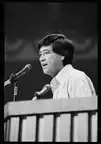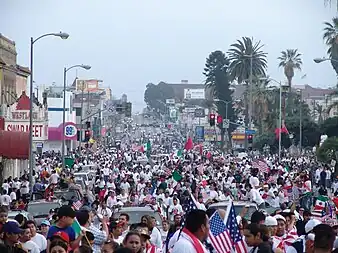History of Mexican Americans
Mexican American history, or the history of American residents of Mexican descent, largely begins after the annexation of Northern Mexico in 1848, when the nearly 80,000 Mexican citizens of California, Nevada, Utah, Arizona, Colorado, and New Mexico became U.S. citizens.[1][2] Large-scale migration increased the U.S.' Mexican population during the 1910s, as refugees fled the economic devastation and violence of Mexico's high-casualty revolution and civil war.[3][4] Until the mid-20th century, most Mexican Americans lived within a few hundred miles of the border, although some resettled along rail lines from the Southwest into the Midwest.[5]
| This article is part of a series on the |
| History of Chicanos and Mexican Americans |
|---|
| Part of a series on |
| Hispanic and Latino Americans |
|---|
| This article is part of a series on the |
| History of the United States |
|---|
 |
|
In the second half of the 20th century, Mexican Americans diffused throughout the U.S., especially into the Midwest and Southeast,[6][7] though the groups' largest population centers remain in California and Texas.[8] During this period, Mexican-Americans campaigned for voting rights, educational and employment equity, ethnic equality, and economic and social advancement.[9]
Spanish period
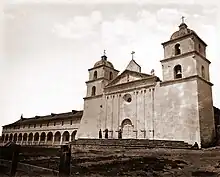
Spanish entry into what is now the United States southwest began in 1540, when Francisco Vasquez de Coronado, his 230 Spanish soldiers, 800 Indigenous Mexicans, and three women marched into the Rio Grande valley.[10] Soon after, Juan Rodriguez Cabrillo led the first expedition into Alta California in 1542, when he landed in modern-day Santa Barbara.[11] There are reports that the explorer Marcos de Niza entered Arizona in 1539, but scholars have cast doubt on his fabled exploration for the Seven Cities of Gold.[12]
Full-scale Spanish colonization of the Southwest did not begin until 1598, when the Spanish government, under pressure from the Catholic Church to Christianize the Coahuiltecan peoples of the Rio Grande Valley, selected Juan Oñate to cross the Rio Grande and establish a permanent settlement in San Juan Pueblo, near present-day Espanola.[13] Rumors of hidden gold and silver ores in New Mexico circulated in the lead-up to the Oñate settlement, but none were ever found in the region.[14] The focus remained on religious conversion.
The first Spanish missions in Texas were founded in the 1680s around present-day San Angelo, El Paso and Presidio, near the New Mexico settlements. In the early-1680s, however, conflict emerged in New Mexico, as the Pueblo people rebelled against the Spanish occupation.[15] Spanish colonization nevertheless persisted, and in 1690, new missions were built in East Texas by Alonso de León after the Spanish discovered the French had been encroaching into the territory.[16] In Arizona, the first Spanish settlements were founded in 1691 by the Italian Jesuit missionary Father Eusebio Francisco Kino.[17] California's first permanent Spanish settlement wasn't established until 1769, when the Presidio of San Diego was founded by Father Junipero Serra and his accompanying Spanish soldiers.[18] This marked the beginning of the Mission system, an era infamous for its brutality toward Indigenous peoples.[19]
The Spanish period ended in 1821 with the signing of the Treaty of Córdoba, which officially ended the Mexican War of Independence.[20]
Mexican period

The Mexican period of the U.S. southwest lasted from 1821 until 1848. The First Mexican Republic (1824-1835) had difficulties maintaining control over the region.[21] Sparsely populated and far from the economic and political center in Mexico City, the northern territories of Alta California, Santa Fe de Nuevo Mexico, and Tejas were now free to engage in economic exchange with American traders, a practice which had been barred under the Spanish Empire. This newfound freedom resulted in the development of strong economic and social ties between the economic elites of Tejas, Alta California, and the United States.[22]
Mexico's Constitution of 1824 guaranteed the equality of all Mexicans regardless of race. This had significant consequences in Alta California. In 1824, the Chumash of Santa Barbara coordinated a rebellion against the Mission system, protesting the inhumane conditions they continued to experience under the Jesuits.[23] Simultaneously, the elites of the state, including the Vallejos, Alvarados, and Peraltas, urged for the total secularization of Mission lands. These agricultural families understood that if the Missions were secularized, the churches' large land-holdings would be distributed through land-grants by the regional government.[24] The Mexican government eventually acquiesced, and the Mission system was abolished through the Secularization Act of 1833.[25] As a result, the large land-holdings of the Missions were distributed through grants to the state's wealthiest families, including the Vallejos, Alvarados, Peraltas, Carillos, de la Guerras, and Picos.[26] The California neophytes, rather than being freed, became laborers on the Ranchos the Californios created. These ranchos were compared to Plantations, and the indigenous laborers were often "treated worse than slaves".[27]

During this period, California and Texas were flooded by Anglo American businessmen.[28] These migrants were welcomed into the region, and intermarriage between U.S. men and Mexican women was common practice, as it was a way to secure business loyalties through familial bonds.[29] Yet the continual flood of Americans into the Northern territories grew into an ever-larger issue for the Mexican government. In 1835, less than 14 years after Mexico's independence from Spain, American ranchers in Tejas revolted against Mexico and declared themselves the Republic of Texas.[30] Mexico's President Santa Anna led an army to put down the filibusteros, but after initial victories at The Alamo and Goliad, Santa Anna's army surrendered defeat on April 21, 1836.[31] The Republic of Texas was never recognized as a sovereign state by the government of Mexico, which refused to recognize the treaties signed by Santa Anna, as he was a hostage when he signed them.[32] In the new Republic of Texas, Tejanos faced severe educational and economic discrimination.[33] Meanwhile, Mexico struggled to maintain its hold on political stability following the rebellion in Texas. In fact, the nation went through eighteen Presidential administrations from 1836 to 1845.[34]
In 1845, newly elected U.S. President James K. Polk, aware of the lingering instability in Mexico and eager to expand the United States to the Pacific Ocean, propositioned Mexico to purchase Alta California and Santa Fe de Nuevo México.[35] The offer was flatly rejected by the Mexican government. Polk responded by moving U.S. troops, led by Zachary Taylor, into the Nueces Strip to provoke the Mexican Army into attacking the U.S. in order to get Congress to declare war.[36] Taylor set up camp in a disputed border territory and refused to leave, even after repeated warnings from the Mexican government.[37] After several skirmishes in the disputed zone, the U.S. Congress declared war on May 13, 1846.[38]
Mexican–American War
Conflict and battles
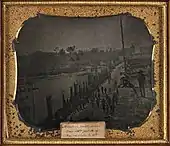
The Mexican–American War of 1846–48 would prove one of the most consequential events for Mexican Americans in United States history. In 1846, U.S. general Stephen W. Kearney marched into New Mexico, where he faced little resistance from the Mexican residents of Santa Fe.[39] He installed local elite nuevomexicanos as the head of the provisional military government, which largely placated the residents of the territory.[40] In his first public speech to residents, he proclaimed the forthcoming equality of an American regime, claiming that, "El fuerte, y el debil; el rico y el pobre; son iguales ante la ley ... protegeré los derechos de todos con igualdad" ("both the strong and the weak, the rich and the poor ... everybody is equal before the law and will be protected by the same equal rights").[40]
New Mexico at first accepted the United States' military occupation without resistance, but within a year of Kearney's annexation of the territory, there was a widescale uprising.[41] Nuevomexicano Pablo Montoya and Taos Puebloan Tomás Romero together led the 1847 Taos Revolt, which resulted in the execution of Charles Bent, Taos sheriff Stephen Lee, Judge Cornelio Vigil, Bent's brother-in-law Pablo Jaramillo, the attorney J. W. Leal, and a young boy named Narciso Beaubien.[42] The U.S. military moved quickly to quash the revolt, and the fighting ended in New Mexico after the Nuevomexicanos' subsequent defeats in the Battle of Red River Canyon, the Battle of Las Vegas, and the Battle of Cienega Creek.
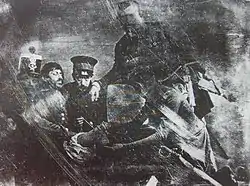
In California, residents also fought the American army. In 1847, Californios staged battles throughout Southern California against the American conquest, including the Battle of Los Angeles and the Battle of San Pasqual (present-day San Diego). The United States Navy, believing that cutting off supplies to the Californios would ensure their defeat, implemented blockades along the Pacific Coast and Gulf of Mexico. As a result of these actions, the Navy's Pacific Squadron subsequently conquered Monterey, San Francisco, and San Diego, virtually guaranteeing victory for the U.S. in California.[43] The war ended on September 8, 1847, when Winfield Scott took control over Mexico City in the Battle for Mexico City. The U.S. and Mexico soon after entered negotiations for conditions of surrender.[44]
Treaty of Guadalupe Hidalgo

On July 4, 1848, the United States and Mexico ratified the Treaty of Guadalupe Hidalgo, which formally ended the war.[45] Under the conditions of defeat, Mexico also ceded more 525,000 square miles of territory.[46] The treaty guaranteed full citizenship for all former-Mexican citizens who requested it, as well as formal U.S. citizenship to all who remained in the U.S. territories for one full year after the signing of the treaty.[47] The full text of the treaty also included Article X, a provision which would have guaranteed rights to all holders of Mexican land-grants.[48] Fearing that Article X would give Tejanos too much protection over their land, the U.S. Congress quietly removed it from the final version, claiming that it was "redundant".[40] The law of the treaty guaranteed the "treaty citizens" full rights to their land if they were able to prove ownership, but the ability to prove ownership proved difficult.[49]
Furthermore, the treaty was signed without any formal legal guarantees that all Mexican citizens would be treated as citizens under U.S. law. Under the Constitution of 1824, all Mexicans, regardless of their race, had gained recognition as citizens, yet the United States, under the Naturalization Act of 1790, only recognized "white persons" as eligible for citizenship through naturalization.[50] The treaty thus legally classified Mexicans as "white" in order to allow them U.S. citizenship, yet this was applied only to the Spanish Mexican elite, mestizos, and assimilated Indigenous peoples.[51] Without explicit legal protection, all unassimilated and autonomous Native Americans in the new territories were thereby subjected to prior United States' case law relating to "Amerindian" tribes.[52]
Early-American period
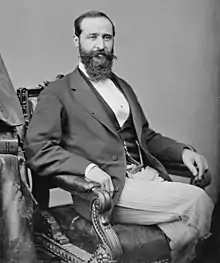
.jpg.webp)
The early-American period in the U.S. southwest was a period marked by violence and land loss. Under the terms of the Treaty of Guadalupe Hidalgo, all Mexicans were granted formal citizenship rights as American citizens, yet widespread dissatisfaction emerged amongst the Mexican Americans.[53] Despite the treaty pledges of full and equal citizenship, rampant discrimination and violence were immediate and widespread.[54]
Realizing the potential dissatisfaction which the former Mexicans would face as American citizens, Mexico's president José Joaquín de Herrera issued a recolonization plan in August 1848, which promised economic resources and land for any former-Mexican who returned to Mexico.[55] The commission hired three commissioners to recruit repatriates. Father Ramón Ortiz y Miera, the New Mexico commissioner, encouraged resettlement by criticizing the inferior status of the "treaty citizens".[55] Such arguments had a strong resonance for the former Mexicans, as twenty-five percent of the country's Mexican American population repatriated after the war.[55]
Yet, the United States, despite guaranteeing the rights of former Mexicans to return to Mexico, developed legal arguments in order to institute formal barriers against this resettlement movement.[55] The U.S. Secretary of War George W. Crawford even claimed that repatriation was prohibited. Because New Mexico served as the primary buffer between American settlers and indigenous groups, the U.S. believed it was in their best interest if the treaty citizens remained in the U.S. to maintain a "civilized" presence in the region and protect against Native encroachment.[40]
Society
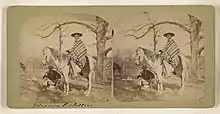
In 1850, the United States census counted approximately 80,000 Mexican treaty citizens living across California, Texas, and New Mexico.[56] New Mexico was the largest United States territory at the time, with around 61,547 inhabitants, about 95% of whom were former Mexican citizens.[57] The majority of the Nuevomexicanos lived in rural communities with populations of fewer than 1,000 people. According to the 1850 census, the three most common occupations held by Nuevomexicanos were farmer, laborer, and servant.[57]
In South Texas, Tejanos lived in a three-tiered society. At the top were the landed elite, who owned huge ranchos, many of which had been granted by the Spanish colonial empire and turned into haciendas.[58] The elite retained their economic dominance through cattle ranching.[58] Small landowners occupied the second rung of the South Texas economic and social ladder.[58] These landowners lived in one-room adobe houses and spent most of their time caring for their horses and cattle.[58] Finally, South Texas had a third lower class composed primarily of peóns, vaqueros, and cartmen. Peóns had a status above slaves in antebellum Texas but below that of free men.[58] Peóns worked at the direction of the patróns—planting and harvesting crops, herding goats, digging wells, and doing any sort of manual labor necessary. They lived in tiny one-room jacales, huts with walls of mud or any other material available and thatched roofs.[58] Anglo migrants to Texas believed the jacales were evidence of the Tejanos' "sub-human" and "primitive" nature.[59]
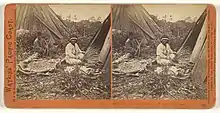
In California, native-born californios mostly lived in small farming and ranching communities in the south. The two largest cities in 1850 were Los Ángeles, with a population of 3,500, and Santa Barbara, where 1,185 people lived.[60] While elite Californios, such as Pablo de la Guerra and Luis María Peralta, held political and economic power in the state, they represented only 3 percent of the population in 1850.[61] The vast majority of landed Californios were subsistence farmers who based their livelihood on their small plots of land. In the southern coastal regions, business-ownership and manual labor were also common occupations for general Californios. For the Indigenous peoples of California, the Treaty of Guadalupe Hidalgo's failure to ensure full citizenship and protections had dire consequences. They were subjected to a systematic genocide, funded by the state of California.[62] The California Genocide killed around 90% of California's Native population during the early-American period, clearing the way for full-scale Anglo colonization.[63]
Government
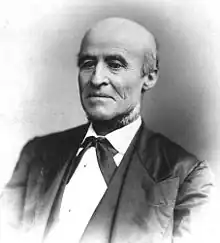
Over time, the social, economic, and legal position of the Spanish Mexicans diminished, largely through political disenfranchisement and large-scale land loss. These two processes were facilitated through the elimination of political, linguistic, and property rights. In two decades, Anglo Americans seized complete control over the apparatuses of political power across the U.S. Southwest.
José Manuel Gallegos was sworn into Congress in 1853 as the first nuevomexicano territorial representative to Congress. He spoke only Spanish, which was not a problem for his first two terms. After he successfully ran for reelection in 1856, however, his bilingual opponent Miguel A. Otero, contested the election results.[64] Otero claimed Gallegos' inability to speak English disqualified him. Gallego made an impassioned self-defense in Spanish on the House floor, where he protested the "disappointment" he felt from the "sneers" of his colleagues.[65] Nevertheless, Otero's bid was successful, and he replaced Gallego as the territorial representative of New Mexico.[66]
California's first U.S. senator, John C. Frémont, introduced legislation for the federal government to arbitrate land claim settlements.[67] After the removal of Article X from the Treaty of Guadalupe Hidalgo, treaty citizens were stripped of any formal protection of their land rights.[68] After gold was discovered at Sutter's Mill in Coloma, California in 1848, a massive migration flooded the state, sparking the Gold Rush. By 1852, the population of California had grown from 8,000 in 1848 to 260,000.[69] These gold miners were largely landless and asserted ownership over California lands. The California Land Act of 1851, also known as the Gwin Act, after California senator William M. Gwin, created a Presidentially-appointed commission to settle disputed claims between the landholders and Anglo miners.[70]
Land
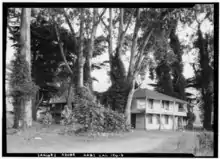
In California's post-war years, land proved to be the most contentious and sought-after commodity. The California Land Act of 1851 established a commission to determine the validity of Spanish and Mexican land grants.[71] In order to prove ownership over the property, landowners needed to both provide evidence of the initial grant, as well as submit proof they had made "structural and pastoral" improvements to the land.[40] If they could not, Anglo squatters were free to claim ownership if they had "improved the land", a contentious claim which was often difficult to disprove.[72] Additionally, because many of the initial Spanish and Mexican diseños" grants were vague, merely describing the natural boundaries of the property, contestations over the boundaries of ranchos were difficult for the Californios to prove.[73] All documents submitted in support of a claim also needed to be translated into English. Some firms, like Halleck, Peachy & Billings, gained popular reputations as "friends to the Mexicans" for helping the Californios navigate the new American court system, but most land lawyers used the situation to their advantage, drawing out the cases and charging exorbitant fees for their services.[74]
_-_Vallejo_Adobe%252C_Adobe_Road_at_Casa_Grande%252C_HABS_CAL%252C49-PET.V%252C1-25.tif.jpg.webp)
In most instances, land claim cases often proved simply too expensive for most Californios to litigate. While the majority of cases were ultimately ruled in favor of the Californios, the average wait-time for a case to be resolved was seventeen years.[75] During that time, most Californio families were forced to sell portions of their property to pay their attorneys' fees.[76] In addition, all land commission hearings were held in San Francisco, which created an additional and expensive barrier for Southern California landowners.[77] Mexican American landowners, in general, faced often insurmountable odds in proving ownership of their lands, which some argue was the intent of the convoluted system.[74] Mariano Guadalupe Vallejo wrote, "It requires a lot of work and money that I don't have to locate [possible witnesses], and afterwards to pay for notarized affidavits and English translations for each."[40]
Some Californios, however, attempted to use their positions of influence and power to fight against the legal discrimination. Pablo de la Guerra, a Santa Barbara landowner, asserted his political influence as a state senator and then lieutenant governor to vocally critique the American legal system, which treated Mexicans as a "conquered and inferior race".[40] De la Guerra complained that the testimony of white people was taken more seriously in the court system than that of Mexicans; he said, "A disgraceful distinction between white testimony and ours was indelicately paraded."[40] De la Guerra would have to fight even to maintain his right to hold political office; the landmark case People v. de la Guerra decided that despite charges otherwise, De la Guerra could hold political office in the United States.[78] Nevertheless, Anglos came to dominate the political and economic landscape of California, as not even one Mexican family retained their wealth in the early-American period.[79]
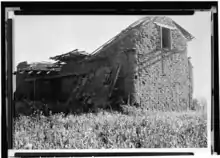
In Texas, land grants were never subject to a federally legislated commission. Because Texas had attained statehood in 1845, it retained jurisdiction over the entirety of its border regions and thus claimed exemption from the Treaty of Guadalupe Hidalgo.[80] The Texas state government thus took the matter of land grants into its own hands, when governor Peter H. Bell appointed William H. Bourland and James Miller to determine the validity of Spanish and Mexican land holdings in the state.[81] At its first hearing in Webb County, the Bourland-Miller Commission faced significant opposition from the local Mexican American landowners, who claimed that the commission had been established in order to seize the property of Tejanos and take away their full rights.[82] Miller and Bourland were able to win over the landowning elite of the Laredo area, however, by conducting an "impartial" proceeding, which resulted in all the Tejano families retaining their landholdings.[83] In the rest of the state, however, the commission was less favorable to the land-owning claims of the Tejanos. In areas of Southwest Texas, fewer than half of all land grants were recognized as legitimate by the commission, and many of the ones which were recognized as legitimate were already owned by Anglo Texans.[82]
Violence

In addition to using legalistic maneuvers to seize economic and political control, American settlers also used physical violence as a tactic to control the conquered Mexican American population. In California, Mexican Americans were driven out of their homes, forced out of mining camps in gold-rich areas, barred from testifying in court, and gradually segregated into barrios.[84] There was resistance to this violence, as men like Tiburcio Vásquez turned to banditry to resist the domination of the Anglos.[85] As a method to keep Mexicans in their place, the American settlers lynched Mexicans. Between 1848 and 1860, at least 163 Mexicans were lynched in California alone.[86]
Between 1848 and 1879, Mexican Americans across the United States were lynched at an unprecedented rate of 473 per 100,000 of population. Most of these lynchings were not instances of "frontier justice"— out of 597 total victims, only 64 were lynched in areas which lacked a formal judicial system.[86] The majority of lynching victims were denied access to a trial while others were convicted in unfair trials. Mexican Americans had no avenues for justice in the early-American period. As a result, many of the folk heroes of this period were considered to be outlaws: robbers, social bandits, and freedom fighters.[87]
In Texas, Mexican Americans also resisted the violence of the U.S. settlers. Juan Cortina began the First Cortina War in 1859 when he shot the Brownsville town Marshall, Robert Shears, for brutalizing Cortina's former employees.[88] Cortina raided and occupied the town with a squad of armed men. They held the city for several months, until they were attacked by a joint effort between the Texas Rangers and U.S. Army, led by John Ford and Samuel Heintzelman. The final battle was fought in March 1860, when Cortina was defeated.[89]
Late-19th century
Civil War
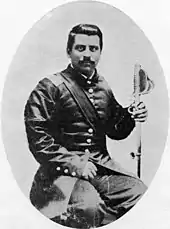
Mexican Americans played a major role in the American Civil War (1861-1865). Texas, which was home to a significant portion of the nation's Mexican American population, seceded from the Union and joined the Confederate States of America in February 1861. In the Arizona and New Mexico territories, many elite Mexican American families held views sympathetic to the Confederacy.[90] In New Mexico, wealthy Mexican American crop-farm families openly supported the slave-owners of the South, perhaps due to their own reliance on the forced labor of Native Americans.[90]
Across the country, Mexican Americans felt resentment toward the U.S. because of the ethnic discrimination they experienced after the Mexican American War. The result was a mixed dispersion of support and opposition toward the United States. In New Mexico and California, support among Mexican Americans was split.[90] Many wealthy landowners in southern New Mexico supported the Confederacy, while most northern New Mexicans fought for the Union Army.[90] In California, Union support tended to be stronger in Northern California, while many Mexican Americans in Southern California leaned toward the Confederacy. Nevertheless, California remained in the Union.[90]
.jpg.webp)
The Confederates, however, believed that opening a route to California would aid their cause. In summer 1861, John R. Baylor led the Confederates into Mesilla and declared the southern portion of New Mexico as the Confederate Territory of Arizona.[91] He then marched into Tucson and declared Southern Arizona the second district of the Arizona Territory.[92] In response to this aggression, President Abraham Lincoln appointed Henry Connelly - an Anglo politician who married into a Mexican American family - as the territorial governor of New Mexico.[93] Inspiring confidence amongst the Nuevomexicanos, the Union army was soon filled by Mexican Americans. The New Mexico units, known as the New Mexico Volunteers, were led by Brigadier General Diego Archuleta, Lt. Col. Manuel Chávez, Lt. Col. Francisco Perea, Col. José Guadalupe Gallegos, J. Francisco Chaves, and Cpt. Rafael Chacón.[94] This massive Mexican American army was able to destroy the Confederate hold on New Mexico by March 28, 1862, when Lt. Col. Manuel Chávez and his troops destroyed the Confederate supply train on Glorieta Pass and forced the Confederate soldiers to abandon the field.[95] Often called the "Gettysburg of the West", the Battle of Glorieta Pass effectively ended the Confederates attempts to take over the Western United States.[96] With the Confederates' surrender of the Territory, Mexican Americans from California were responsible for clearing out all Confederates supporters, including French imperialists who entered the U.S. during Maximilian's rule in Mexico.[90]
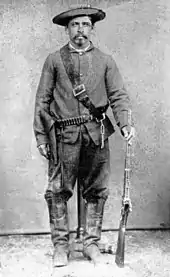
As the last Confederate stronghold of the Southwest, Texas played a major role in Civil War battles. Wealthy Tejano ranchers, such as Santos Benavides, were the strongest Texas supporters of the Confederacy.[97] Nevertheless, many working class Tejanos fought for the Union army, as they had no interest in living in a social system predicated on unfree labor.[90]
Some Tejanos, such as Antonio Ochoa, had fought against the Texas Confederates from the time of secession. In 1861, Ochoa and a group of 40 men marched to the Zapata County courthouse and sought to prevent the town officials from swearing their allegiance to the Confederacy.[98] Ochoa and his men were immediately attacked by Confederate troops and forced to flee into Mexico. There they met and recruited Juan Cortina, who'd been forced out of Texas at the end of the First Cortina War.[90] Ochoa and Cortina together launched multiple military and economic attacks in South Texas, targeting supply lines, and even assassinating a Confederate county judge.[99] After each attack, they fled back to the safety of Mexico, waited for a short time, and then moved back into Texas for their next attack. This continued until Ochoa was executed by the brother of Santos Benavides.[90]
The final battle of the U.S. Civil War was fought in Texas. One month after Robert E. Lee's surrender at Appomattox in April 1865, Union forces marched toward Brownsville.[100] Tejano Confederates responded near the mouth of the Rio Grande and attacked the Union soldiers.[101] While the Confederates won this final victory, they were the ultimate losers of the war. All told, an estimated 20,000 Latino soldiers fought during the American Civil War.[102]
Reconstruction era

Despite the significant contributions of Mexican Americans in the American Civil War, the community faced a resurgence of discrimination in the Reconstruction era. In the 1870s, the New Mexico Territory saw a massive influx of Anglo-American settlers and land speculators.[103] The Territory legislature, fearing a Gold Rush-style land grab, petitioned Congress for protections.[40] In their 1872 memorial to Congress, the New Mexico legislators argued for a change in federal land laws, which stipulated that in the case of a dispute, the owners of the land must present evidence of their original land grant in both English and Spanish. The legislators argued this provided an undue burden to Nuevomexicanos, since in the territory, "very few ... understand the English language."[40] As migration increased over the course of the decade, the legislature issued more memorials, stressing the need for a Board of Commissioners to settle disputed land claims.[40]
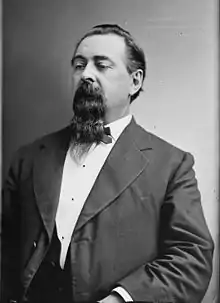
In Texas, disputes between Tejanos and white Americans resulted in open racial conflict. The Skinning Wars, also known as the Second Cortina War, erupted in the 1870s.[104] After the Civil War, Texas ranchers found themselves with a massive surplus of cattle, and this resulted in a precipitous drop in the price of beef. The cost of cowhides, however, remained relatively high. Because of the high price of hides, disputes soon emerged over mavericks, which, in this period, were often left to grange on the open range. These disputes resulted in "skinning raids", where young Mexican men would round up disputed herds of cattle and skin them all at once. In retaliation, white Americans in South Texas organized "vigilance committees", which quickly gained notoriety for their violent tactics.[105] In Corpus Christi, the Anglo vigilance committee raided Tejano ranches, where they would kill every Mexican male, burn down all their buildings, and force any survivors across the border to Mexico.[106] Texas Ranger Leander H. McNelly, a former Confederate, imposed punishments against the Tejanos he believed were responsible for the "raids", formally ending the race war.[107]
.jpg.webp)
In West Texas, violent ethnoracial tensions exploded by 1877. In September of that year, San Elizario District Judge Charles Howard sought to charge collection fees from Mexicans, Tejanos, and Tiguas when they harvested from local salt beds.[108] The residents were outraged by the fees, as the salt beds had been considered a public resource for many generations.[109] After Howard arrested two residents who tried to collect salt without paying, the residents revolted against Howard. Known as the San Elizario Salt War, this revolt resulted in the death of Howard and four other white Americans.[110] In response, the white residents of San Elizario called upon the Texas Rangers, who, along with the U.S. Army, suppressed the rebellion and reasserted Anglo power in the region.[111]
Further south, Richard King continued to actively consolidate the King Ranch in the late-1870s, usually through violent and coercive tactics directed against his Tejano ranchero neighbors.[112] In 1878, one newspaper commentator complained that King's neighbors "mysteriously vanish whilst his territory extends over entire countries".[113] King, however, did not work alone. As his wealth grew, so did his political influence, and the territorial consolidation of Texas ranch land was made possible through the Texas Rangers. The Rangers in this period took violent measures against Tejano ranch owners to scare them into selling their land. In fact, the Rangers were known popularly in the late-1870s as los riches de la Kineña, an allusion to the belief they acted as King's private security force.[114]
Gilded Age
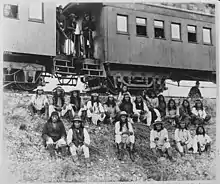
The 1880s for Mexicans Americans was a period of substantial change, marked especially by the emergence of the Southern Pacific Railway. In El Paso, the Southern Pacific reached the city in 1881, at which point it birthed an immediate economic and industrial revolution, as new industries emerged in mining, smelting, and construction.[115][116] The economic boom was felt throughout the U.S. Southwest and Northern Mexico, and it brought new national and transnational migrants into the region.[117] In addition to Mexicans entering the U.S. from Mexico, Chinese laborers came from San Francisco, African Americans fled from the Jim Crow South, and European Americans came from the East Coast. The influx of new capital and immigrant labor into the region helped transform Texas from a barren terrain into a hub of international commerce, and El Paso emerged as the region's primary economic hub and an international commercial depot.[118] Nevertheless, racial violence continued.[119] Mary Jaques, a British tourist who spent two years in Central Texas in the 1880s, wrote that the murder of Tejanos "carried a sort of immunity with it", as Mexicans appeared to be "treated like a dog, or, perhaps, not so well".[120]

Migration into the United States in this period was also soon complicated by racial restrictions. For the first time in its history, the U.S. barred an entire national-origin group from immigrating when it passed the Chinese Exclusion Act in 1882.[121] This caused difficulties at the Mexico–United States border, since the Act officially excluded Mexicans of Chinese descent from entering the U.S. as well.[122] "Chinese Inspectors" were hired by the United States Customs Service to inspect immigrants at ports of entry in the Southwest.[123] While official U.S. policy was to deport all ethnic Chinese immigrants to China, migration policies were slightly revised for Chinese Mexicans, who were deported to Mexico instead, if they held Mexican citizenship, had lived most of their lives in Mexico, or were married to Mexican nationals.[124] This "Chinese inspection" force would grow into the U.S. Border Patrol.[125]

These continued indignities suffered by Mexicans and Mexican Americans did not go completely ignored, however. In 1885, María Ruiz de Burton, a Californian Mexican-American, published The Squatter and the Don, a novel set in 1870s San Diego County, where the fictional Amaro family clashed with esquatas, Anglo Americans who "improved" the Amaro family ranch in order to lay legal claim to the land.[126] Considered the United States' first female Mexican-American author, Maria Ruiz de Burton had been politicized through her personal experiences in California after the Mexican American War.[127] Before the publication of her novel, she wrote to her cousin, "It cannot be denied that the Californians have reason to complain. The Americans must know it; their boasted liberty and equality of rights seem to stop when it meets a Californian ... And now we have to beg for what we had the right to demand."[128] The publication of Burton's novel coincided with several other important developments in California for Mexican Americans. The decade witnessed the official dismantling of Spanish usage in official government documents,[129] around the same time the Gilded Age practice of voter suppression emerged to disenfranchise African American peoples from having a say in the functions of government.[130] For Mexican Americans, in general, the Gilded Age was a period of abrupt economic change, political disenfranchisement, and demographic displacement. While there was significant immigrant labor entering the Southwest from Mexico during this period through the railroads, it was dwarfed by the tidal wave of Anglos moving West from New York and other ports of entry. While the 1880s brought major changes, the coming years would emerge as a retrenchment of racial animosity.
Rise of Juan Crow
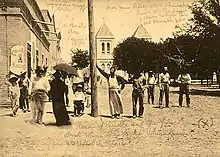
If the 1880s represented a period of massive cultural and economic change for Mexican Americans in the U.S. Southwest, the 1890s were marked by renewed racial conflict and social unrest. In El Paso, which experienced a massive influx of white American migrants to the region after the completion of the Southern Pacific railway line, there was a widespread retrenchment of racial animosity.[131] Interracial marriage, which had theretofore been tacitly allowed in some parts of Texas, became a crime increasingly targeted by Texan officials.[132] Throughout the state, a new code of racial relations and series of ordinances worked to create segregated racial neighborhoods.[133] These laws targeted Native Americans, black Americans, Asians, and Mexican Americans. They have been described as Juan Crow, the rough equivalent to the Jim Crow laws emerging in the South. In El Paso, Mexicans Americans were demonized as ignorant, and therefore both ineligible and unworthy of the vote. White Texans also frequently characterized them as "foreigners", despite their U.S. citizenship.[131] One El Paso newspaper claimed Mexicans were "foreigners who claim American citizenship but who are as ignorant of things American as the mule."[131]
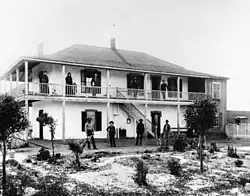
In the 1890s, the railroad and mining industries continued to expand. These industries needed massive pools of labor to fill new jobs, many of which were filled by immigrants from Mexico.[134] Immigrants entering the United States came from remote regions of Mexico, seeking relief from the increasingly brutal Porfiriato.[135] The Texas Mexican Railway had connected the U.S. and Mexico in 1883, and this railway allowed for an increasingly integrated transnational transportation system between the two countries.[136] Meanwhile, for elite Mexican American families who continued to undergo litigation involving disputed land claims, the federal government finally offered them some relief in 1891. The Court of Private Land Claims was created to settle disputes, providing a federally funded interpreter for the court.[137] The New Mexico Territory, which had been urging such a commission for years, fell under the jurisdiction of the court, along with Colorado and Arizona. And though the Court did confirm some Nuevomexicano land grants, many were left unconfirmed.[40]
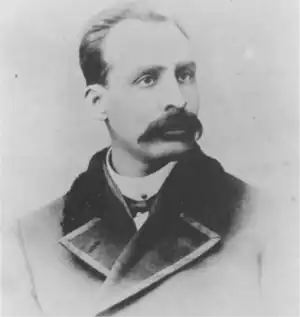
In Texas, the massive economic and political inequalities occurring sparked a resurgence of racial warfare. In September 1891, Catarino Erasmo Garza led an army of hundreds of Tejanos back and forth across the Rio Grande in a revolt against both Mexico and the United States, known as the Garza Revolution.[138] Adopting the slogan "libres fronterizos" which were stitched onto their hats, the army, known as the Garzistas, was a multiclass movement, consisting of lower-middle-class professionals, poor farmers, landless ranchers, and wealthy landowners, with both Mexicans and Mexican Americans (as well as a few Anglo Americans who had married into Mexican families).[138] The military response to the Garza Revolution was extremely bloody, and set precedent for both Texas police, as well as the U.S. Army for domestic warfare.[138] Leading the suppression was U.S. Army captain John Gregory Bourke, who said, "The cheapest thing to do is to shoot them down wherever [they are] found skulking about with arms in their hands, and to burn down some of the ranchos which gave them shelter."[139] Bourke, who had fifteen years experience in Arizona during the Apache Wars, led his armies to destroy all Tejano communities believed to support Garza.[139] The U.S. Army burned down ranches, threatened families with lynching, searched without warrants, and stole guns, horses, and money from Tejano families.[139] Complaints were filed with state and federal officials, but the atrocities were ignored. The Garza Revolution was suppressed by 1893, at which point Catarino Garza was forced into exile, along with the last of his scattered supporters.[139]
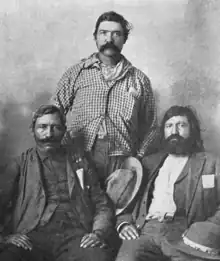
In New Mexico, there was also significant ethnic violence in the 1890s. It began when the Santa Fe Ring, a group of powerful Anglo lawyers and land speculators, succeeded in dispossessing thousands of Mexican Americans of lands they used for community farming.[140] The Ring moved quickly to fence the lands to prevent anyone from accessing the areas. In response, a group called Las Gorras Blancas initiated a lawsuit against the Ring arguing for community access to the Las Vegas Land Grant, but the judge sided with the Santa Fe Ring.[141] The Gorras Blancas, outraged at the injustice, promised military retribution. In 1890, they began their campaign of vigilante justice, cutting down the new fences, destroying farm equipment, and burning buildings throughout San Miguel, Santa Fe, and Mora counties.[142] Believed to have been led by the three Herrera brothers, Juan José (known as El Capitan), Pablo, and Nicanor, the Gorras Blancas held between 700 and 1,500 members at its height.[143] In 1890, the Blancas declared themselves the defenders of "the rights of all people in general, and especially the rights of poor people".[143] The territorial Governor Lebaron Bradford Prince responded by declaring them a violent "mob",[143] and organized officials to clamp down on the group. Four dozen Gorras Blancas were indicted, but none were convicted.[144] Finally, in Arizona, racial violence also erupted in 1896 with the Yaqui Uprising, when a group of Yaqui, Pima, and Mexican revolutionaries fought against the U.S. and Mexican armies in an early attempt to overthrow the increasingly despotic President Porfirio Díaz.[145]
1900s
.jpg.webp)
In the first decade of the 20th century, the population of Mexicans in the United States grew significantly. The first railroad connecting Mexico City to the Mexico-United States border was completed, which allowed for greater ease of movement from the interior of Mexico to the United States.[146] Migration increased especially after a severe recession hit Mexico in 1906 and then a depression from 1908 to 1909.[147][148] The Mestizo migrants were met with animosity in the United States, as Anglo Americans in the Southwest began warning about the dangers of non-white immigration.[131] As the number of Mexican immigrants increased, nativist broadsides emerged in the Progressive Era which asserted the poor living conditions of the immigrants - such as substandard housing, high infant mortality, lack of sanitation, and high crime rates - were indicative of flaws within the Mexican character, rather than a failure on the part of the United States to assist the immigrants.[131] In Chihuahuita, Texas, complaints about the "hordes of Mexicans" pouring over the border were widespread; however, the need for Mexican traquero labor, farmworkers, and miners meant that enforcement against Mexican laborers remained lax.[131]
Domestic politics
%252C_factory_(cropped).jpg.webp)
For U.S.-born Mexican-Americans, the first decade of the 20th century was defined largely by legalistic discrimination, including the creation of segregated schools for Mexican American children (where they were severely underserved and mistreated),[149][150] mysterious and unexplained "jail suicides", and a significant number of lynchings.[151] Some Mexican Americans, however, took a stand against these violent conditions. In 1903 near Oxnard, California, a group of Mexican American beet farmworkers teamed up with their Japanese-American coworkers to demand better wages and working conditions.[152] The Oxnard strike of 1903 is one of the first recorded instances of an organized strike by Mexican Americans in United States history.[152] The Mexican and Japanese American strikers raised the ire of the surrounding white American community. While picketing, one laborer, Luis Vasquez, was shot and killed, and four others were wounded.[153] While the strikers were able to leverage the press from the shooting into securing some of their demands, the success of the strike proved short-lived after Samuel Gompers and the American Federation of Labor refused to grant the strikers an official union charter due to the racial makeup of their group.[154] Incidents of racial conflict also flared up in areas such as Clifton, Arizona, where, in 1904, mobs of Anglo men raided the homes of Mexican American families to kidnap their children, so as to save the children from the "suffering" of being raised in Mexican homes.[155] In 1906, the Supreme Court refused to hear what became known as the "Arizona Orphan Abduction" case, thereby tacitly allowing the children to be legally adopted and raised by their kidnappers.[156]
International relations
.tif.jpg.webp)
In these years around the turn of the century, Mexico intensified its campaign against the Yaqui of Sonora, who were fighting against the forced assimilation programs of the Porfirio government.[157] The federal Mexican government initiated a program of forced resettlement, deporting Yaqui rebels to work as slave laborers on the henequen plantations in Yucatán.[157] In response, many Mexican Yaquis fled to the United States. The U.S. Army, led by Captain Harry C. Wheeler, negotiated with the Mexican government to deport any Yaqui found in Arizona back to Mexico.[131] The U.S. Department of Commerce and Labor went a step further and ordered the detention and deportation of all Yaquis who entered the United States without documentation. Somewhere between 10,000 and 15,000 Yaquis were deported to Mexico, where they were met with murder, lynching, and enslavement by the Porfiriato.[157]

In the latter half of the decade, U.S. immigration officials worked to step up regulations at the Mexico-United States border. As immigration from Mexico to the United States increased around the turn of the century, nativists pushed to increase public health and public charge restrictions against potential migrants.[131] Widespread anti-Chinese sentiment also created a sense of hysteria in U.S. border towns. Unable to differentiate between Indigenous and Mestizo Mexicans and Mexicans of Chinese descent, U.S. immigration officials became increasingly concerned about Chinese Mexicans who entered the United States by wearing "traditional" Mexican clothes and speaking Spanish.[158] In 1905, T. F. Schmucker, Chief of the Immigration Bureau in El Paso, asserted that between 150 and 200 Chinese Mexicans were being held in detention in Juarez.[159] By 1907, U.S. immigration officials adopted even more stringent policies in order to prevent Chinese Mexicans from entering the United States; however, one immigration inspector named Marcus Braun, wrote, "How exceedingly difficult it is to positively state whether these are ... Chinamen or Mexicans."[131] In the lead-up to the Mexican Revolution, the number of immigrants entering the U.S. from Mexico increased dramatically, including the number of Chinese Mexicans. In 1909, the El Paso Times wrote, "There are a hundred 'Celestials' where there was one twenty years before ... every train brings a dozen or two to Juarez, all intent on getting across the border, and in the course of a few years hundreds of them have been taken off trains on the American side."[131]
1910s
Mexican Revolution
.jpg.webp)
The Mexican Revolution (1910-1920) resulted from the increasing unpopularity of the 31-year-long brutal dictatorship of Porfirio Díaz. Growing resistance to Diaz resulted in a power struggle among competing elites, which created the opportunity for agrarian insurrection.[160] Wealthy landowner Francisco I. Madero challenged Díaz in the 1910 presidential election, and following the rigged results, revolted under the Plan of San Luis Potosí.[161]
Armed conflict broke out in northern Mexico, led by Madero, Pascual Orozco, and Pancho Villa, and with support from portions of the middle class, the peasantry, and organized labor,[162] Díaz was forced out. In the Treaty of Ciudad Juárez, Díaz resigned and went into exile. New elections were held in 1911, and Madero was elected, taking office in November. Opposition to his regime then grew from both the conservatives, who saw him as too weak, and from former revolutionary fighters, who saw him as too conservative.
In a period in February 1913, known as the Ten Tragic Days, Madero and his vice president Pino Suárez were forced to resign and then assassinated. The counter-revolutionary regime of General Victoriano Huerta came to power, backed by the United States and its ambassador Henry Lane Wilson,[163] business interests, and supporters of the old order. Huerta remained in power until July 1914, when he was forced out by a coalition of different regional revolutionary forces, including the forces of Pancho Villa and Emiliano Zapata. Wealthy landowner Venustiano Carranza formed the "Constitutionalist" political faction, and with military forces under the leadership of Álvaro Obregón, played an important part in defeating Huerta.[164] When the revolutionaries' attempt to reach political agreement failed, Mexico plunged into a civil war (1914–15). Carranza emerged as the victor in 1915, defeating the Villistas and forcing Zapata back to guerrilla warfare.[165] Zapata was assassinated in 1919 by agents of President Carranza. Many scholars consider the promulgation of the Mexican Constitution of 1917 as the end point of the armed conflict.

For the United States, the Revolution proved profoundly consequential, as the violence unleashed by the conflict led between 600,000 and 1,000,000 refugees to flee into the United States.[166] Along the border, residents in American cities feared revolutionary fervor for land redistribution would inspire the poor and working classes in the U.S. to rise up against Anglo property ownership and domination.[139] The Texas governor made a formal request for U.S. troops to guard the border and keep the revolutionary ideals out of the United States.[139]
The border was effectively turned into a militarized zone. Barbed wire, spotlights, tanks, machine guns, and airplanes were brought in to surveil Mexican residents and maintain "order" in the borderlands.[167] Around sixty-five hundred U.S. troops were stationed in El Paso, where they were ordered to keep Villistas from entering the city and keep watch over the Mexican refugees and Mexican Americans in the city. U.S. consular agent George Carothers wrote, "A large portion [of the] Mexican population of El Paso have arms ... which will create [a] dangerous situation here ... The possibility exists of them starting something serious."[168] In January 1916, white Americans took matters into their hands and started a "race riot" in the majority-Mexican neighborhood of Chihuahuita,[169] attacking every Mexican refugee and Mexican American they found in the streets.[170]
.jpg.webp)
While Mexican American historians have continued to debate the long-term consequences of the Mexican Revolution, one of its most long-lasting legacies was the mass dislocation of entire communities from Mexico to the United States.[131] Men, women, and children fled on foot, traveled by wagon and horseback, and by railroad to enter the United States as refugees.[136] In the aftermath of Pancho Villa Expedition, one press report described the "hundreds" of refugees fleeing to the United States in the course of a single day: "Following the troops were hundreds of refugees. Prosperous Mormon families rode in comfortable farm wagons or in small motor cars. Some Mexicans rode in carriages, on horses, mules, burros and on the motor lorries of the expeditionary forces while hundreds of them and Chinese residents from the evacuated region walked through the deep dust which had been made by the feet of hundreds of troops."[171]
Treatment in the U.S.
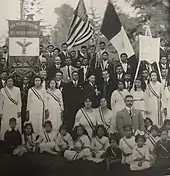
Life in the United States was difficult and violent for Mexican refugees and Mexican Americans in the latter half of the Progressive Era. Reformers in the era believed that non-white people were "primitive" and biologically inferior.[172] The eugenics-influenced Dillingham Commission argued for drastic reductions in the number of immigrants to the United States,[173] while academics such as Charles Davenport claimed racial "deficiencies" were the root of violence and poverty.[174] This elite nativism had a direct translation on the ground, as refugees of the Mexican Revolution were regularly denied humanitarian aid. In one incident in 1914, refugees fleeing the violence of the revolution crossed into West Texas; in response, white Texans arrested the refugees and imprisoned them in Ft. Bliss.[139]
Most of the hundreds of thousands of Mexican refugees who fled to the United States during the Revolution settled in California and the U.S. Southwest. In Los Angeles, many of the resettled refugees lived in the historically Mexican American area of East Los Angeles.[175] State and local resources were thinly spread, and Mexican refugees and Mexican Americans were specifically targeted for exclusion from welfare programs.[176] Mexicans were left to fill pre-existing gaps in the American labor market, and colonias, or Mexican-majority neighborhoods, were established in Chicago, Kansas City, and Salt Lake City, as railroad companies were one of the main sources of employment.[177] The steel and automobile sectors drew Mexicans and Mexican Americans to Detroit, San Francisco, and Minneapolis, as well as farming in Oregon, Texas, and Southern California. In order to provide middle-class Mexicans with a sense of grounding in their new communities, consulates of the Mexican government in major cities organized a network of juntas patrioticas (patriotic councils) and comisiónes honoríficos (honorary committees) to celebrate Mexican national holidays and to express support for the Revolution. The juntas patrioticas proved incredibly popular, and were an early form of community organizing for the Mexican community in the United States.[178]
.jpg.webp)
Mexican Americans also faced a darker form of discrimination during the Progressive Era. In this period, several dozen states passed eugenics laws, outlining legal criteria for compulsory sterilization.[179] In California, eugenicists at public institutions like Sonoma State Hospital and Whittier State School began their sterilization programs in the 1910s.[180] These doctors believed that "dispositions" for poverty, crime, mental illness, disability, and violence were inheritable, and thus, anyone diagnosed as "insane", "feebleminded", or "epileptic" was unfit for "breeding".[181] They would thus be permanently sterilized in order to solve the nation's social ills. Recommendations for surgical sterilization were heavily influenced by eugenic prejudices regarding the biological inadequacy of poor and non-white people.[182] As a result, Mexican American men, women, and children were disproportionately sterilized in California. Many Mexicans immigrating to the United States struggled through their journey crossing borders because they hoped to find stability and better opportunities in this new environment. Although, this history portrays the beginning of Mexican immigration and how new events have continued to reoccur, whether being influenced by government issues or not.[183] By some estimates, Mexican Americans were between 40 and 60% more likely to be permanently sterilized than their white counterparts.[184] Progressive-era elites also passed severe Anti-miscegenation laws, as well as laws prohibiting "normal" individuals from marrying people with low-IQs, in order to "breed" a more healthy nation.[176] California's eugenic laws were the basis for Nazi eugenics.[185][186]
La Matanza de Texas

The mid-1910s proved to be one of the most violent periods for Mexican Americans in Texan history. In the summer of 1915, a manifesto attributed to Mexican seditionists was discovered, entitled El Plan de San Diego.[187] The plan sought to overthrow American control over the entire borderlands through a panethnic "Liberating Army of race and people", which would include Mexicans and Mexican Americans, African Americans, and Japanese Americans.[188] The plan called for the expulsion of Anglos and the execution of all white American men over the age of sixteen years old.[189] The plan also called for burning bridges and derailing trains in order to disrupt federal, state, and local infrastructure. The initial steps of the plan were initiated through targeted attacks against prominent ranches.[190] On August 8, 1915, around sixty ethnic men raided the Los Norias headquarters of the Texas Rangers on the King Ranch.[191] The response to this raid and the discovery of the plan was swift and violent. The Texas Rangers launched an indiscriminate manhunt, killing every Mexican and Mexican American man they could find.[192] One Ranger wrote that the troops showed a "savage radical element" against the Mexicans.[139] Estimates range that at least 102 people were killed in the wake of this first incident.[193]
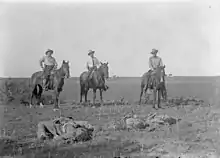
This event set off a wave of violence across South Texas, described by some as an "orgy of bloodshed" known as La Hora de Sangre (part of a broader period called La Matanza).[194] Texas judge James Wells estimated that in Hidalgo County and Cameron County alone, Texas officers and vigilantes executed between 250 and 300 men between the summers of 1915 and 1916.[139] Extralegal violence was enacted by white mobs, state police, and local deputies across Texas, and estimates of the dead range from 300 to several thousand.[195] Police often colluded with the vigilante mobs, and Mexican Americans were tortured, hanged, shot, beat, and burned alive.[196] Many of the known victims were adult men, though a few women, and some children, were murdered by the white mobs.[139] The executions often occurred in isolated and rural areas hidden from public view. Assailants almost never faced arrest, and grand juries refused to indict the accused, as in the case of Porvenir massacre.[197] Mexican Americans had no option but to organize their lives to avoid law enforcement or the white American community.[139]
Immigration policies
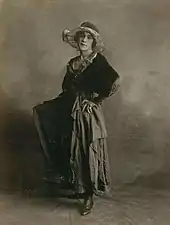
The nativism which had been growing in the United States for several decades grew even stronger in the aftermath of the Mexican Revolution. In January 1917, the United States passed the Immigration Act of 1917. This legislation severely curtailed immigration to the United States and marked a major turning point in U.S. immigration policy. The act introduced a literacy requirement, increased the "head tax" to eight dollars (a significant sum at the time), added new prohibited categories (including peoples with mental illness, as well as the "gender inverse", meaning all members of the LGBT community),[198] and extended the Chinese Exclusion Act to bar all Asian immigrants (except from Japan and the Philippines).[199] This act created a burden for Mexican immigrants, as the literacy requirements, head taxes, and restricted categories were applied vigorously.[200] In 1917, the U.S. Public Health Service also implemented invasive medical inspections at the border (where men and boys would be stripped naked and examined for "defective" anatomy - including large breasts or small genitalia - and sprayed with chemical agents to be "disinfected").[201] Outrage at these procedures resulted in the 1917 Bath riots.[202] Soon, agricultural interests in California and Texas, successfully lobbied Secretary of Labor William B. Wilson to create exemptions for agricultural laborers.[131] For all other immigrants from Mexico, the protocols remained in place.
With these new policies in place, nativists across the United States were emboldened to enact anti-Mexican violence. In one particularly infamous and egregious incident in Bisbee, Arizona, over 1,000 Mexican and Mexican American laborers were forcibly deported by an army of over 2,000 deputies in an incident known as the Bisbee Deportation.[203] The laborers, who were miners in the nearby copper mine, had been organized by the Industrial Workers of the World, a labor union, on June 26, 1917.[204] In response, Sheriff Harry Wheeler and his army of deputies rounded up and arrested over a thousand of the men on July 12, 1917, marching them to a waiting train.[205] The train carried the men to Columbus, New Mexico, where it left them in the desert without food or water.[206]
World War I
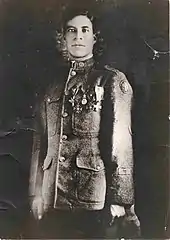
U.S. involvement in World War I lasted from April 6, 1917 until the war's end on November 11, 1918. During this time, approximately 200,000 Latino Americans fought for the United States.[207] The majority of these Latino servicemen were Mexican Americans.[207] Many of these men experienced discrimination in the service, and some went so far as to hide their Mexican ancestry to avoid prejudicial treatment.[208] Unlike African American servicemen, however, Mexican Americans did not serve in segregated units during World War I.[209] Even as white American servicemen harassed the Mexican American soldiers for their "barrio English", Mexican American soldiers proved decisive in several key skirmishes, including the Battle of Saint-Mihiel and the Meuse–Argonne offensive.[209]
David B. Barkley, one Mexican American man from Laredo, was posthumously awarded the Medal of Honor for scouting behind enemy lines in France. And Marcelino Serna, who immigrated to the United States from Mexico as a young man, was awarded the Distinguished Service Cross. During the war, Serna singlehandedly destroyed a German machine gun site in one battle.[210] Two weeks later, he took out 26 enemy soldiers, captured 26 more as prisoners, and successfully prevented his fellow American soldiers from executing the captured men.[210] Serna returned to the United States as the most decorated soldier from the state of Texas.[211]
1920s
Rise of the KKK
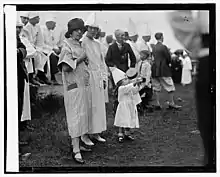
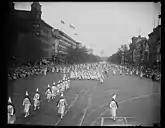

In the years after World War I, the rising tide of nativism continued to grow in the 1920s. The Second Ku Klux Klan was a new organization patterned after the original KKK of the 1860s. It was anti-Catholic and anti-immigrant[212][213] and taught that all Mexicans and Mexican Americans were "subhuman foreigners".[214] The KKK mounted an extensive campaign of violence across the Southwest.[214]
The KKK had a strong presence in Texas and California.[215][216] The organization had adherents in rural communities in both states,[217][218] and held major political control in large cities.[219][220] In Dallas, where the KKK gained control over the city's politics, it sought to completely close off the border with Mexico.[221] In San Diego, the KKK was led by many of the city's elite. According to Ernesto Galarza, a labor activist and professor, "Mexicans were seen as an endangerment to traditional American values. [Even the clergy] often ignored the Klan's abuses toward Latinos".[220] The KKK in Southern California regularly lynched, tortured, dragged, and murdered Mexicans and Mexican Americans. Mercedes Acasan Garcia, a refugee of the Revolution working as a maid in San Diego in the 1920s, stated, "Since they were ragged Wetbacks, nobody cared who they were and nothing was done about it."[220] The KKK was also extremely politically powerful in Los Angeles, and in 1928, the KKK senior member John Clinton Porter was elected mayor of the city.[222]
Colorado was another area with extensive Klan activity. During World War I, Colorado companies sought to fill labor gaps left by soldiers through recruiting refugees of the Mexican Revolution (who had arrived in the United States in large numbers during the 1910s).[223] As labor recruiters paid to relocate large numbers of refugees to Colorado, white residents became increasingly enraged at the presence of the "radical aliens".[223] During the First Red Scare of 1920, significant numbers of white Coloradans joined nativist and "one hundred percent American" organizations.[224] Despite these sentiments, corporations continued to recruit Mexicans. In 1921, John Galen Locke harnessed the intensifying anti-Mexican feelings and organized the KKK in Colorado.[225] By 1925, the KKK had emerged as the dominant political force in Colorado, running on campaigns of law and order and anti-Mexicanism. The KKK deliberately held rallies in cities with large Mexican neighborhoods.[223]
Johnson–Reed Act
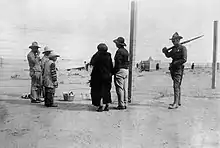
In the years following World War I, the United States nearly entirely shut out immigration from the rest of the world. In 1921, Congress passed the "Emergency" Quota Act of 1921, which set immigration levels to "3 percent of the number of foreign-born persons of each nationality" living in the U.S. as determined by the 1910 United States census.[226] This Act was meant to reserve most immigration quota slots to northwestern European countries, which received the largest number of the 350,000 total slots created.[227] Immigration restrictionists, however, were not satisfied, and U.S. Representative Albert Johnson and Senator David Reed responded by pushing for even stricter quotas.[228] The resulting Johnson-Reed Act reduced the quota from 3 percent to 2 percent, and changed the census base from 1910 to 1890, which meant that only people from West and North Europe could migrate.[229]
For Mexicans, however, the effect of the law was complicated, as the quota system applied only to countries outside the Western Hemisphere, meaning there were no caps on immigration from any Latin American country.[230] This lack of a quota for Mexicans was controversial amongst the U.S. nativist movement, who were outraged at the large numbers of Mexican immigrants entering the country - including thousands during the Cristero War (1926-1929).[231] Immigration restrictionists, who desired to limit the number of non-white people in the U.S., felt that immigration from Mexico, even when only to fill labor gaps, was dangerous to the nation.[232] One article in The Saturday Evening Post asked, "How much longer [are] we going to defer putting the Mexican Indian under the quota law we have established for Europe?"[233] The East Texas congressman John C. Box went so far as to state that Mexicans would lead to the "mongrelization" of white America.[234] In general, however, Mexican racial identity was contentious enough for lawmakers to avoid moving forward with increased restrictions. U.S. Secretary of Labor James Davis, wrote, "The Mexican people are of such a mixed stock and individuals have such a limited knowledge of their racial composition that it would be impossible for the most learned and experienced ethnologist or anthropologist to classify or determine their racial origin. Thus, making an effort to exclude them from admission or citizenship because of their racial status is practically impossible."[235] According to scholars of the period, however, most Americans at the time believed Mexicans' racial heritage was "impure".[159]
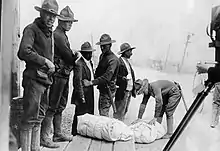
Even though Mexican immigration was never subjected to quota limits, U.S. immigration officials used increasingly stringent measures to limit entry. For itinerant laborers who lived in Mexico and worked in the United States, weekly disinfection mandates were regularized, and quarantine and "bath certificates" were required to be renewed weekly.[236] Then, in 1924, the U.S. Congress approved the creation of the Border Patrol, led by the previous chief "Chinese Inspector", Clifford Alan Perkins.[237][238] The Border Patrol began with headquarters in El Paso overseeing three district offices in Los Angeles, El Paso, and San Antonio. Beginning in the 1920s, visa controls and deportations became regular mechanisms to regulate Mexican immigration.[239] Finally in 1929, Congress passed the Aliens Act of 1929, known as Blease's Law, which turned undocumented entry into the U.S. a misdemeanor and re-entry a felony.[240] Up to that point, immigration violations were largely considered civil matters.[241]
Mexicans in Hollywood

In the 1920s, Mexican entertainers entered American popular culture for the first time in U.S. history. Dolores del Río was an actress, singer, and dancer. Born and raised in Mexico, she and her husband left Mexico in 1925. Both were from upper-class families who were struggling in the aftermath of the Mexican Revolution.[242] She began her film career in Hollywood almost immediately upon her arrival. She had roles on a string of successful silent films, including Resurrection (1927), Ramona (1928) and Evangeline (1929). While del Río was proud and insistent of her Mexican heritage, she was nevertheless mostly cast in non-Hispanic white roles, usually appearing as the romantic interest of white actors. Many considered her the most beautiful woman in the world in the 1920s and early 1930s, and she is widely regarded as the first major female Latin American star in Hollywood.[243][244][245]
_poster_1.jpg.webp)
In the 1920s, another Mexican actress reached the heights of Hollywood stardom. Lupe Vélez attended high school in San Antonio, Texas as a teenager but returned to Mexico after her family lost their home during the Mexican Revolution.[246] The family struggled financially in those years, and Vélez moved to Mexico City to work in an FAL department store - then considered an upper-class symbol of modern global capitalism. Her breakthrough occurred when she appeared in a popular musical production in the city's revista theater.[246] After moving to the U.S., she made her first film appearance in a short in 1927. By the end of the decade, she was acting in full-length silent films and had progressed to leading roles in The Gaucho (1927), Lady of the Pavements (1928) and Wolf Song (1929). Vélez' roles were varied, though she often portrayed "exotic" and "foreign" women.[247]

Though Hollywood had two Mexican star actresses in the 1920s (and the male star Ramon Novarro), there was still controversy over the stereotypical depictions of Latin Americans in film. In the 1920s, Latin America was Hollywood's largest export market.[248] In Mexico, nearly 80 percent of all films screened were made in the United States. Nevertheless, Mexicans and other Latin Americans were often depicted on screen as lazy, barbaric, morally degenerate, or buffoonish.[249] Mexican Americans, already facing an onslaught of discrimination in other aspects of their everyday lives, were concerned that such depictions were contributing to the prejudicial treatment they were receiving in the United States. Spanish-language newspapers criticized Hollywood "greaser" films' depictions of Latin Americans and even called on the Mexican government to take a stand against Hollywood.[250] The Mexican government did launch an influence campaign, but its success was limited. According to one historian, "The Mexican immigrant community in Los Angeles used discussions about cinema to critique American racial and political ideologies."[251]
Labor issues
.jpg.webp)
In the 1920s, Mexicans met the increasing demand for cheap labor on the West Coast. Mexican refugees continued to migrate to areas outside the Southwest; they were recruited to work in the steel mills of Chicago during a strike in 1919, and again in 1923.[252] Many found work on the assembly lines of automobile factories in Detroit, and in the meat plants of Chicago and Kansas City.[253]
Many also worked as agricultural laborers in farming valleys in the border states, such as Tucson in Arizona, the Rio Grande Valley in Texas, and most especially, the Imperial Valley in California. Anglo-Americans hired Mexicans and Mexican Americans to work in the region's year-round agricultural economy. Mexican farm laborers, along with African Americans, Filipino Americans, Japanese-Americans, and even Armenian Americans, Punjabi Americans, Native Hawaiians and Native Americans, were instrumental in California becoming the nation's top agricultural state. In this shift toward agricultural dominance, California relied on the cheap labor of Mexicans and Mexican Americans in a wide variety of fields. By the mid-1920s, California cotton farms were around five times larger than farms in the Deep South. This meant they needed large numbers of manual laborers, as well as technicians, since California farmers adopted tractors and picking machines at rates faster than any other region.[254] The ability of Mexican laborers to adapt to industrial farming was crucial to the state's success. Nevertheless, even as labor unions in the 1920s grew rapidly to protect workers, some mainstream organizations, such as the AFL, were blatantly anti-Mexican.[255] When Mexicans sought better working conditions, they often faced outright violence.[256]

Some of the decades' most infamous labor disputes occurred in Colorado. In 1927, Mexican-American coal miners participated in a bloody coal strike in Colorado, walking out under the banner of the Industrial Workers of the World. Mexican-Americans in the southeastern part of the state, particularly from the Walsenburg, Pueblo, and Trinidad areas, took leadership roles in the 1927 strike, protesting for better and safer working conditions. Some mine owners in other parts of the state retaliated against the striking miners by refusing to hire any Mexican or Mexican American in their mines.[257] In Walsenburg and Trinidad, the mine owners went to more extreme measures to stymie the protests. Mine owners hired armed men to attack the Industrial Workers of the World's (IWW) Trinidad hall and Walsenburg branch halls. In Walsenburg, the men used a machine gun to attack the IWW hall, ultimately killing two union strikers, Salastino Martinez (age 15) and Klementz Chavez (age 41), on January 12, 1928.[258] Josephine Roche, president of the Rocky Mountain Fuel Company, invited the United Mine Workers of America to unionize her mines, so as to meet some of the strikers' demands without alienating other mine owners, who remained strongly opposed to the IWW.[259]
LULAC and activism
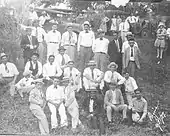
In 1929, the League of United Latin American Citizens (LULAC) was formed in Corpus Christi, Texas through the merging of several smaller Mexican American organizations.[260] It was one of the nation's first mainstream Mexican American political organizations and was formed largely through the efforts of Mexican American World War I veterans who were frustrated at the continued discrimination Mexican Americans faced in the United States.[261] Ben Garza served as the organizations' first president.[262] LULAC quickly developed into an influential middle-class civil rights organization with councils across the Southwest. Organization members tended to portray themselves as patriotic "white" Americans, and membership was restricted only to English-speaking U.S. citizens.[263] Like the NAACP at this time, LULAC believed an "educated elite" Mexican American leadership would guide the community as a whole toward a higher political and economic standing in the United States. Nevertheless, the organization focused mostly on issues such voter registration and poll tax fundraising-drives, aggressively waging legal campaigns against racially discriminatory laws and practices.[264]
Great Depression
Poverty
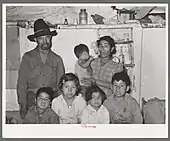
The Great Depression started in the United States after a major fall in stock prices that began around September 4, 1929, and especially with the stock market crash of October 29, 1929, (known as Black Tuesday). The Depression had a major impact for the approximately one and a half million Mexicans and Mexican Americans living in the United States by 1930.[265] Agricultural work fell as one of the depression's first casualties.[159] As white Americans increasingly found themselves unemployed, they grew outraged at the fact that farmers in the Southwest employed Mexican and Mexican American laborers. They mounted pressure campaigns on government officials and employers to insist that only "citizens" be hired.[159] The campaigns were successful, and soon construction companies, stores, factories, and laundries fired their Mexican employees in favor of white Americans.[159] The Hoover administration explicitly blamed Mexicans for taking jobs away from "American citizens".[266]
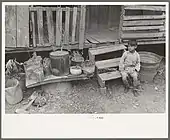
When Franklin Delano Roosevelt was elected president in 1932, there was hope he would provide relief to the suffering Mexican American communities across the United States. This did not materialize. While no New Deal program explicitly barred people by race or immigration status from receiving assistance, occupational status was used to exclude Mexican Americans from receiving Depression relief.[267] The Social Security Act of 1935, for example, barred agricultural and domestic workers from both social security benefits and unemployment insurance, which effectively excluded many African and Mexican Americans from this early social safety net.[268] At the local level, few Mexican migrant laborers received relief, since residency restrictions often required the applicant to have lived in the county for a set amount of time, which excluded migratory laborers.[267]

Without federal or local relief, many jobless Mexican American families adopted an itinerant life, traveling highways in search of work.[269] Some found temporary housing in U.S. Farm Security Administration (FSA) work camps, where Mexican American farm families finally received medicine, food, and housing. Because the widespread culture of anti-Mexican demonization in the U.S. had resulted in targeted violence against Mexican American communities, however, the FSA was forced to set up separate camps specifically for Mexican Americans in order "to create safe havens from violent attacks" from white Americans.[269] These segregated camps brought together Mexican American families from various communities, which provided them with the opportunity to organize and discuss many of the main issues of the day, including the harsh working conditions within the agricultural sector.[269] The familial connections developed in these camps would serve as a strong factor in farm labor movements later in the century.[269] Yet, while the FSA work camps did provide relief for some Mexican American families, many others had a very different experience in the Depression. In many cities, when a Mexican or Mexican American family applied for aid, they were sent to designated "Mexican Bureaus", where repatriation was discussed.[270][271]
Repatriation
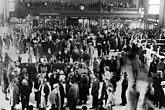
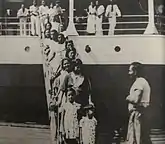
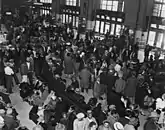
For several hundred thousand Mexicans and Mexican Americans, their lives in the United States during the Great Depression were unbearable - they lost their jobs, were largely denied federal or local relief because of their ethnicity, and faced vilification in politics and in the media as "stealing jobs from real Americans".[272] In addition to these factors, state and county officials across the U.S. began to threaten Mexican and Mexican American families who were seeking government aid with deportation.[273] At the same time, the Mexican government introduced a program to entice ethnic Mexicans back to the country with the promise of free land if they returned.[231] All of these factors - overwhelming poverty, the fear of threats from U.S. government officials, and the promises of the Mexican government - led many to leave the U.S. in a period known as the Mexican Repatriation.[274]
These repatriations, though often initiated under threats of deportation, were considered "voluntary", and thus few federal records exist to provide numbers of how many Mexicans left the country during the Depression.[275] Nevertheless, INS reported in 1931 that "large proportions" of the nation's Mexican population were leaving the country, and some estimates have concluded that between just November 1929 and December 1931, about 200,000 Mexicans left the United States.[275] While a large number willingly departed to Mexico, a significant number were explicitly pressured to leave through state and local repatriation programs.[276] These programs responded to the Depression's severe effects in Mexican and Mexican American communities by promoting deportation.[277]
Some scholars contend that the unprecedented number of deportations and repatriations between 1929 and 1933 was part of an "explicit Hoover administration policy",[278] and the manufactured climate of fear was meant to coerce Mexicans into self-repatriating.[279][280] In fact, local welfare workers did regularly collaborate with immigration officials to provide the names of ethnic Mexicans seeking Depression relief so they might be repatriated.[275] During the Repatriation period, local government and federal officials also collaborated in "street sweeps" and "full-scale paramilitary" raids in majority-Mexican neighborhoods to find undocumented migrants and to terrorize others in the community to repatriate.[277] In addition to welfare officials, charitable aid agencies worked with state and local governments to provide names of Mexican and Mexican American families seeking aid. Charities also sometimes provided money to pay for one-way tickets to Mexico.[281] In all, the INS formally deported around 82,000 Mexicans from 1929 to 1935, while the remaining 320,000 repatriated were considered "voluntary". Of the total number of people who left the United States during the Mexican Repatriation, around half were U.S. citizens.[278]
New Deal labor
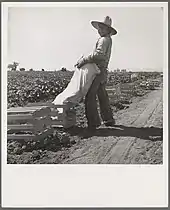
During the New Deal era, Mexican American labor unions made significant strides in organizing; however, they still often faced outright violence. In September 1933, the Cannery and Agricultural Workers' Industrial Union led a massive strike of cotton pickers in the San Joaquin Valley, California. One contemporary writer later described the mobilization of strikers as "an army of brown skinned people".[282] In response, the growers initiated an all-out war to avoid paying the strikers higher wages.[283] They began with a propaganda campaign, claiming the strike was being agitated by a radical-left "Communist menace",[284] rather than the workers themselves who were fighting against endemic low wages and horrific working conditions.[285] Next, the farm owners created armed militias.[282] One, Pixley's Farmers Protection Association, had 600 enrolled members.[282] The farm owners then went after local business owners in town, threatening dire consequences to any business which sold the strikers food. Then, the farmers evicted all striking pickers and their families from their homes, which were usually shacks on the cotton ranches.[282]
When the strikers still refused to break, news began to emerge of mysterious deaths in the cotton fields. The Mexican consulate sent a representative to Tulare County "to protect the interests of Mexicans".[282] However, this did not stop local welfare officials from denying the strikers' families food relief during the strike.[282] Law enforcement soon also stepped in to preserve "law and order", quickly deputizing an army of white locals and granting them "unlimited power".[282] The Mexican American strikers were then openly attacked, and three were killed - but their killers were soon released with all charges dropped.[286] Meanwhile, local and federal relief officials continued to deny the strikers any food relief, and soon scores of the strikers' children began to die from malnutrition.[282] The U.S. federal government finally stepped in, establishing an arbitration committee. By the end of October 1933, a compromise was reached and the strike was finally ended.[282]
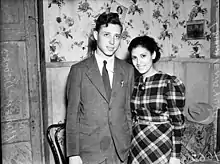
The San Joaquin Cotton Strike of 1933 received national media coverage at the time, much of it in favor of the farm owners. However, Latino American labor activists did make major strides in the 1930s. Luisa Moreno, a Guatemalan immigrant, became the first Latina in U.S. history to hold a national union office when she became the Vice-President of the United Cannery, Agricultural, Packing, and Allied Workers of America.[287] At the time, it was the seventh largest affiliate of the Congress of Industrial Organizations.[288] Another important labor leader during the Depression was the 21-year old Emma Tenayuca,[289] who was instrumental in one of the most famous conflicts of Texas labor history–the 1938 San Antonio pecan shellers strike at the Southern Pecan Shelling Company.[290][291] During the strike, nearly 12,000 workers at over 130 plants protested a wage reduction of one cent per pound of shelled pecans and inhumane working conditions by walking off the job.[289] Mexicana and Chicana workers who picketed were clubbed, gassed, arrested, and jailed. A photo of Tenayuca ran in Time magazine where she was called "the forefront of most of its civil commotions".[292]
Depression politics
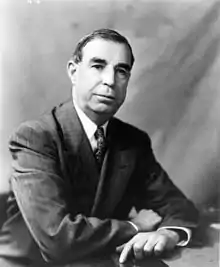
Despite the intense anti-Mexican sentiment pervading the country in the Depression, the era also saw the first Mexican American senators in the history of the country. Sen. Octaviano Larrazolo was elected to the U.S. senate in 1928, but he died in office three months later.[293] Sen. Dennis Chávez first served in the United States House of Representatives from 1931 to 1935, until he was appointed to a full term in the U.S. Senate in 1934. When Chávez was sworn-in, six senators allegedly stood abruptly, turned their backs to Chávez, and angrily left the chamber.[294] During his time in office, Senator Chávez was a major proponent of the New Deal, and he was at least partially successful at securing benefits for New Mexicans. What became known in New Mexico as the "Latino New Deal" was a rare extension of New Deal benefits to Mexican Americans.[295] In the state, newly funded education programs improved literacy rates, and vocational programs revived the production of Hispano craft goods like santero artwork, woven goods, and furniture.[294] WPA agents taught New Mexicans how to market their items to tourists.[294] Later, Senator Chávez became known for his civil rights advocacy, as he fought to expand notions of American citizenship.[296]
In 1935, a federal judge in New York upheld an immigration officer's decision to deny the naturalization petitions of three Mexicans on the grounds that they were not white, but instead individuals "of Indian and Spanish blood".[297] Whiteness, which had been a requirement for naturalized citizenship since 1790, remained so until 1940.[298] If the 1935 ruling had been upheld, it would have rendered the majority of Mexicans ineligible for citizenship.[299] President Roosevelt - who had only recently replaced American interventionist policies, such as the Roosevelt Corollary, with his own diplomatic approach of the Good Neighbor Policy - was concerned that denying Mexicans the opportunity to naturalize would hurt Mexico-U.S. relations.[300][301] He thus urged the State Department to "quiet the controversy", pressuring the judge to reverse the decision.[301] The Labor Department issued guidance to its border officials that "in all future cases, [Mexican] immigrants be classified as 'white.'"[302]
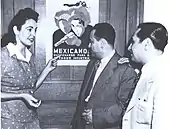
In April 1938, Luisa Moreno and group of Mexican American labor activists, including Josefina Fierro, Eduardo Quevedo, and Bert Corona, organized the inaurural conference of El Congreso de Pueblos de Hablan Española in Los Angeles, an organization meant to promote a broad agenda of working class empowerment, civil rights, and Latino unity.[303] In their founding constitution, the organizers also endorsed the rights of Mexicans to live and work in the U.S. without having to fear coerced deportation.[304] El Congreso also never promoted assimilation,[305] in direct contradiction to other organizations like LULAC (which focused on the desegregation of employment, housing, education, and all public facilities).[306][307] El Congreso was notable for their early stands promoting immigrant rights despite the widespread culture of demonization occurring during the Mexican Repatriation. In fact, Moreno spoke to the American Committee for the Protection of the Foreign Born, critiquing the exploitation of Mexican workers, saying, "[Mexicans make] a barren land fertile for new crops and greater riches. These people are not aliens, they have contributed their endurance, sacrifices, youth, and labor to the Southwest."[128]
World War II era
World War II
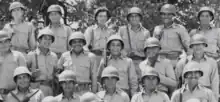
The United States entered World War II against the Axis Powers on December 7, 1941 after the attack on Pearl Harbor. Several hundred thousand Latino men served in the U.S. military during the war, about 500,000 of whom were Mexican American.[308][309] Unlike their African American counterparts, who mostly served in segregated units, most Mexican American soldiers served in integrated units in World War II,[310] though recent research has discovered at least one unit composed entirely of Mexican Americans.[311][312] The majority of World War II Mexican American service members were second-generation Americans who had grown up in the anti-Mexican hysteria of the Great Depression. Thus, the transition for them into the role of an "American soldier" could at times be surprising. One man, Private Armando Flores of Corpus Christi, Texas, remembered the shock he felt the first time he was ever referred to as an "American soldier", because, as he recalled later, "Nobody had ever called me an American before!"[309] According to some scholars, the U.S. government made efforts during the war to address some of the domestic issues facing the Mexican American community.[313] These efforts were part of an overarching campaign to win broad domestic support for the war effort.[313] Perhaps not surprisingly, this new feeling of wartime social "inclusion" created a strong sense of patriotic pride within the Mexican American community.[309] On a single two-block stretch of Silvis, Illinois, 45 Mexican American boys and men volunteered to fight; it was dubbed in the press as "Hero Street".[314]
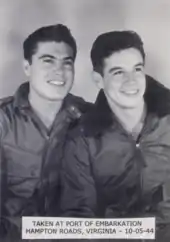
During the war, Mexican American soldiers gained renown for their bravery. At least eleven Mexican Americans received the Medal of Honor during the war.[309] One, Joe P. Martínez, who was a beet harvester before the war, led a strategically critical charge up a snow-covered mountain on Attu Island.[315] He died during the action, and became the first draftee to win the Medal of Honor posthumously.[316] Another, Silvestre Herrera, explained his single-handed attack on a Nazi hold, saying, "I am a Mexican-American and we have a tradition. We're supposed to be men."[309]
Perhaps the most famous Mexican American servicemen was Guy Gabaldon, an 18-year old from East Los Angeles, who had been adopted by a Japanese American family at the age of twelve. When his family was sent to an internment camp, Gabaldon joined the Marines.[317] He was sent to the Pacific theater and saw action in Saipan. In the Battle of Saipan, Gabaldon killed thirty-three enemy combatants, and then, using his ability to speak conversant Japanese, Gabaldon convinced the surrounded remaining soldiers to surrender.[318] The eight hundred Japanese soldiers surrendered peacefully,[319] and Gabaldon earned the nickname the "Pied Piper of Saipan".[320] Though he was recommended for the Medal of Honor, Gabaldon was instead awarded the Silver Star.[321] The 1960 film Hell to Eternity was based on Gabaldon and his life.[322]
Women's wartime labor
.jpg.webp)
Women played a hugely important role during World War II, entering the industrial workforce in record numbers to fill crucial manufacturing positions left empty by the departing soldiers.[323][324] Additionally, countless Mexican American women joined Women's Army Corps, WAVES, and other all-female auxiliary units in the military.[320] It is estimated thousands of Mexican Americans found jobs in the defense industries during the war, though they still often encountered anti-Mexican prejudice on the job market, despite Franklin Roosevelt's 1941 Executive Order 8802, which barred discrimination in defense industry hiring.[309][325] Nevertheless, the war's insatiable demand for labor ultimately overcame employers' reluctance to hire Mexican Americans. Soon, thousands of Mexican American women across the country had joined the workforce as a "Rosita the Riveter".[326]

In addition to efforts on the formal job market, Mexican American women made significant material and moral contributions through the formation of wartime community organizations. These organizations aimed to support American troops abroad, but specifically the young Mexican-American soldiers from local barrios.[327] A few community projects consisted of cooperation between Mexican American and Anglo neighborhoods, yet the vast majority of Mexican American home front activities were organized separately from those of the white community.[328] One of these organizations, the Spanish-American Mothers and Wives Association of Tucson, Arizona, sought to roll bandages, raise money for a veterans center for after the war's end, and write letters to help the boys fight their "internal battle of loneliness".[327] The organization peaked at 300 members during the war.[329] Other organizations, such as Phoenix' Lenadores del Mundo, organized wartime festivals and collected rubber for the war effort, but also sought to fight against the still rampant racism and discrimination experienced by the community.[328]
Sleepy Lagoon murder
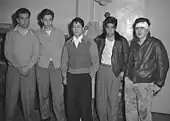
In late-1942, California Governor Culbert Olson, who was facing a tough re-election battle against future incumbent Earl Warren, sent a memo to Los Angeles County's law enforcement agencies, ordering them to launch a vicious campaign against the city's youth gangs.[330] Under these orders, the office of the Los Angeles County District Attorney decided to use the August 2, 1942 death of José Gallardo Díaz, a Mexican American youth, as a test case to launch the new war against juvenile delinquency by turning the investigation into a major media event.[330] In the weeks following Díaz' death, the LAPD launched mass raids in Mexican and African American neighborhoods, arresting more than 600 young men and women to be held in custody and interrogated.[331] The Los Angeles press hailed the arresting officers as heroes.[330] As a result of their often brutal interrogations of the adolescents, the police announced they had found the murderers: twenty-two alleged members of the 38th Street gang and two female accomplices.[332] The public discourse in California surrounding the arrest of the youths was viciously racist, and high-profile debates emerged whether Mexicans and Mexican Americans were "culturally, politically, intellectually, and biologically capable of living within a white, civilized, democratic society".[330]
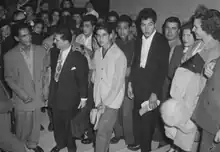
The resulting criminal trial, People v. Zammora (1942), is infamous for its fundamental denial of due process. Of the twenty-four charged youth, seventeen were indicted on murder charges and placed on trial.[333] The courtroom was small and, during the trial, the defendants were not allowed to sit near, or to communicate with, their attorneys.[334] None of those charged were permitted to change their clothes during the entirety of the trial by order of the presiding Judge Charles W. Fricke at the request of the district attorney.[335] Judge Fricke also permitted the chief of the Foreign Relations Bureau of the Los Angeles sheriff's office, E. Duran Ayres, to testify as an "expert witness" that Mexicans as a community had a "blood-thirst" and a "biological predisposition" to crime and killing, citing the supposed human sacrifice practiced by their Aztec ancestors.[336] After Judge Fricke's guilty verdict in January, the Mexican-American youths were imprisoned. The Mexican American community was outraged and several attorneys challenged Judge Fricke's decisions.[337] The famous journalist Carey McWilliams noted that a few months earlier, over 120,000 Japanese Americans were detained and interned in detention camps, and argued that there were common links between the Japanese-American internment and the anti-Mexican response to the Sleepy Lagoon case.[338] In October 1944, the state Court of Appeals unanimously decided the evidence was not sufficient to sustain a guilty verdict.[332] It reversed 12 of the defendants' convictions and directly criticized Fricke for his bias in and mishandling of the case.[339]
Zoot Suit Riots
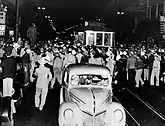


In the 1940s, Mexican American youth had grown up fully immersed in American popular culture, including films, music, and other media. When they came of age, these youth diverged from the expectations of both their parents and dominant society by using culture and fashion to undermine the norms of American segregation and white supremacy.[340] These teens developed their own music, language, and dress. For boys, called Pachucos, the style was to wear a flamboyant long coat zoot suit with baggy pegged pants, a pork pie hat, a long key chain and shoes with thick soles.[341][342] The style was meant to serve as a rebuke of American assimilation and war efforts to conserve materials like fabrics.[343] Meanwhile, girls, called Pachucas, wore black drape jackets, tight skirts, fishnet stockings and heavily emphasized make-up. For the Pachucas, participation in the movement was a way to openly challenge conventional notions of feminine beauty and sexuality, especially in traditional Mexican culture.[344][345][346][347] In both instances, the Zoot-suiters were considered un-American.[348]
This sentiment created issues in Los Angeles, where a new Navy base was installed in Chavez Ravine, a segregated Mexican American neighborhood of Los Angeles.[349] This brought over 50,000 service members into a largely Mexican neighborhood, many of whom were white and from areas with few Mexican Americans.[350] The sailors - who frequently walked through the Chavez Ravine neighborhood on their way to the bars in Downtown Los Angeles - would harass the Zoot-suited youth for their seemingly disrespectful attitudes.[351][352] As the anti-Mexican atmosphere surrounding the Sleepy Lagoon murder trial grew more tense over the course of 1943, minor attacks by Navy sailors against Mexican American boys became an almost daily occurrence.[352]
In June 1943, these tensions exploded in one of the worst race riots in the city's history. After a Mexican American boy raised his hand in a way that a sailor considered to be "threatening", the man and his friends attacked the boy.[352] This sparked a skirmish in the street, which ended quickly after the initial sailor had his nose broken.[353] That night, hundreds of sailors went into the neighborhood and attacked every Mexican American boy they could find.[354] For the next ten straight days, the Navy sailors went into Chavez Ravine, Downtown LA, and even East Los Angeles, dragging, beating, and stripping naked every Zoot suited boy out in public - some as young as twelve and thirteen years old.[355] The Los Angeles press cheered on the racist attacks, even printing guides on how to "de-zoot" a zoot-suiter.[356] The LAPD responded by joining the sailors, arresting hundreds of Zoot suiters, both teenaged boys and girls, and charging them with "disturbing the peace".[357] Progressive activists at the time, such as Carey McWilliams, blamed the riots on William Randolph Hearst's "proto-fascist" promotion of "anti-Mexican hysteria" during the Sleepy Lagoon murder trial.[358] Scholars, however, have focused on the complex social matrix operating within Los Angeles at the time, and interpret the riots as an example of the "social cleavages" within the segregation-era U.S.[359]
Postwar activism
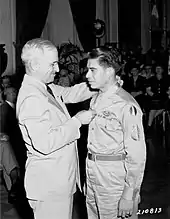
World War II formally ended on September 2, 1945 after the atomic bombings of Hiroshima and Nagasaki, and the final surrender of Japan to the Allied powers. For the millions of returning veterans, the adjustment back to civilian life was difficult. For African and Latino Americans, in particular, there was significant difficulty transitioning from being war heroes and liberators in Europe, back into second-class citizens in the race-segregated United States. African Americans had sought to address some of these discrepancies with their Double V campaign;[360] meanwhile, Mexican Americans began their own fight for civil rights at home. The historian Thomas A. Guglielmo writes, "Patriotic sacrifice and service only further fired Mexicans' and Mexican Americans' determination to gain first-class citizenship."[361] Returning Mexican Americans challenged discrimination and segregation in many ways, including by sitting in "whites only" seating sections in town theaters, demanding service at white restaurants, and attempting to enter segregated public pools.[362] In one notorious instance, Macario Garcia received the Medal of Honor in a ceremony at the White House, and less than a month later, he was refused service at the Oasis Cafe in Richmond, Texas because of his ethnicity.[363] He refused to leave the cafe, the police were called, and Garcia was arrested and charged with "aggravated assault".[364] In Arizona, the governor named August 14, 1945 in honor after another Medal of Honor recipient, Silvestre Herrera. Coverage of the event was marred, however, by the governor's need to request Phoenix businesses to take down signs barring Mexicans.[365]
.jpg.webp)
Discrimination against returning Mexican American veterans hurt the prospects of the entire Mexican American community. While medical, financial, and educational benefits from the GI Bill helped lift millions of Anglo-American families into the growing American middle-class, the application of the bill's benefits to African and Mexican American veterans was uneven.[366] As a result, the Mexican American community did not ever gain full economic and political equality in the postwar era.[313][327] Rather than being simply exclusionary, however, the GI Bill had several important failings which resulted in its discriminatory outcomes.[367] The bill offered loan guarantees, yet few banks honored such guarantees to non-white veterans, and for those who did, restrictive racial covenants meant that African and Mexican American veterans were only able to live in redlined neighborhoods, where property values often remained low.[368][369] Furthermore, many Mexican American veterans complained about consistently late tuition disbursements, which forced them to drop out of their job training and university programs, and reports of "outright racism within the VA" were common.[367] Contemporary scholars have found that overall, the GI Bill "did not profoundly alter the occupational profile of all Mexicans ... and its immediate impact on upward mobility among families ... was inconsistent".[370]
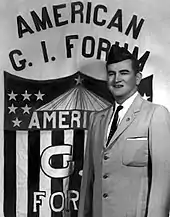
Some of these issues were challenged directly. In 1948, the Corpus Christi physician, Hector P. Garcia, founded the American GI Forum in order to demand equal rights to GI Benefits, medical care, burial rights, desegregated education, and other civil rights.[371] In a famous early instance of the Forum's civil rights advocacy, Garcia took up the case of Private Felix Longoria of Three Rivers, Texas. Longoria had died in combat in 1945, but his remains weren't shipped home for several years.[372] When they finally arrived, his widow Beatrice went to the local funeral home to plan a wake in his honor.[373] The funeral home director refused to allow the family to use the chapel, because of their race.[374] The director told the media at the time that he would never allow Mexican Americans to use his facilities, saying, "We just never made it a practice to let them use the chapel and we don't want to start now."[375] When Garcia found out about the situation, he was outraged and immediately sent letters of protest to the media, elected politicians, and government officials. One of these letters was sent to Texas' junior senator, Lyndon B. Johnson, who arranged for Longoria to receive full honors and burial at Arlington National Cemetery.[376] The Longoria incident pushed the American G.I. Forum to the forefront of the postwar Mexican American civil rights strategy.[309] The Forum, alongside LULAC and El Congreso, greatly expanded their operations after World War II and began their fights to end segregation.[377]
Court cases
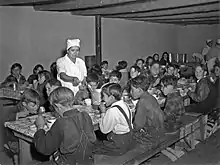
In the 1940s, there were two major court cases involving the civil rights of Mexican Americans. The first, Mendez v. Westminster (1947), involved Gonzalo Méndez, a naturalized U.S. citizen born in Mexico, and his Puerto Rican wife Felicitas, who joined four Mexican American families to sue four Orange County school districts.[378] The families challenged the common California practices of drawing school boundaries around majority-Mexican American neighborhoods and of placing Mexicans who lived in majority-white communities into segregated Spanish "remedial" schools.[379][380] During the trial, the Orange County superintendents justified school segregation because the Mexican American children had inferior "personal hygiene", "scholastic ability", and "economic outlook".[378] On the plaintiff's side, the constitutionality of educational segregation was questioned on the basis of the Fourteenth Amendment, and social scientists were brought in as expert witnesses to dispute the supposed educational benefits of segregated schools.[381] In 1946, Judge Paul McCormick ruled that school segregation was a "clear denial" of the Equal Protection Clause, and the next year, McCormick's decision was upheld by the U.S. Court of Appeals.[382] The Méndez case was significant for several reasons, including: the support of NAACP counsel Thurgood Marshall;[383] the plaintiffs' revolutionary use of social scientific research as a basis for law;[384] the legal precedent marking educational segregation as unconstitutional;[385] and the case's influence for the Anderson Bill (1947), which repealed California school segregation.[386]
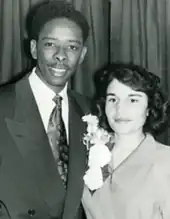
The second major civil rights court victory for Mexican Americans also occurred in California. Andrea Pérez, who was Mexican American, and Sylvester Davis, who was African American, had met and developed a friendship immediately before he was drafted to fight in World War II. When he returned, they resumed their relationship, fell in love, and married.[387] At the time, California's anti-miscegenation code barred interracial marriage.[388] Pérez and Davis hired the civil rights attorney Dan Marshall to represent them in challenging the ban.[389] When the Los Angeles County clerk denied them a marriage license, Pérez formally filed suit. In 1948, the California Supreme Court ruled in favor of the couple, becoming the first state in the country to overturn a ban on interracial marriage.[390] The decision in part relied on arguments based on the inability of the law to account for Mexican mestizaje.[391] The court, noting Pérez' "in-between" racial status, ruled that blanket bans on interracial marriage were "too vague and uncertain" since they did not consider people who were of "mixed ancestry".[391] Also, the court held county clerks and other government employees could not realistically be expected to successfully ascertain the racial makeup of each marriage applicant. Finally, Judge Roger Traynor's majority opinion found that the law also violated the equal protection clause of the Fourteenth Amendment.[392] Earl Warren was then the governor of California, and he oversaw the legal implementation of the ruling in the state. Nineteen years later, he served as chief justice in Loving v. Virginia (1967), the U.S. Supreme Court case that struck down all remaining state bans on interracial marriage.[387]
Mid-20th century
Korean War
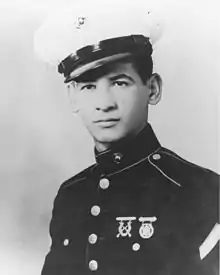
In June 1950, the United States entered the Korean War as part of a United Nations-led coalition supporting South Korea.[393] Thousands of Mexican Americans served in the conflict from its beginning, many of them inspired to join the war effort because of the service of their fathers and older brothers in World War II.[394] Staff Sgt. Joe Campos, from Miami, Arizona became one of the first soldiers missing in action of the war after his plane was shot down on June 28, 1950 over the Yellow Sea. A few days later, Florentino Gonzales, from Chicago, was part of the first group of prisoners of war.[395] One Mexican American soldier, Jesus Rodriguez, later remembered how his harsh upbringing in the United States prepared him for the Korean War.[396][397] He stated, "I used to pray a lot. Another thing that helped me was that I was street smart from before going into the service. On the streets I learned how to fight ... Something else that helped me survive Korea was that going hungry wasn't new to me and didn't hurt me."[398] Ten Mexican Americans were awarded the Medal of Honor for their valor in the Korean War;[398] they included: Joe R. Baldonado, Victor H. Espinoza, Eduardo C. Gomez, Edward Gómez, Ambrosio Guillen, Rodolfo P. Hernandez, Benito Martinez, Eugene Arnold Obregon, Mike C. Pena, and Joseph C. Rodriguez.[399] Finally, Gen. Richard E. Cavazos, born in Kingsville, Texas, became the first Mexican American four-star general and head of the U.S. Army Forces Command.[400]
Bracero program
In 1951, the U.S. government passed Public Law 78, a law which formalized the Bracero Program, a temporary work exchange program with Mexico.[401] First begun as a scheme to fill wartime labor shortages during World War II, Congress decided to formalize the program for a number of reasons: first, new concerns were raised about domestic labor gaps during the Korean War; second, political concerns were raised about a potential rise in undocumented immigration if Mexican laborers were not offered a legal pathway to work in the U.S.; third, agricultural employers' associations lobbied hard for the program since they benefited the most from its subsidizations.[402] Estimates place the annual number of laborers entering the U.S. in the 1950s at around 300,000,[403] and a significant number of these Braceros were indigenous Mexicans, who hardly spoke Spanish.[404] Domestically, the program was controversial. The U.S. Department of Labor official overseeing the program called it "legalized slavery",[405] and some Mexican Americans believed the program suppressed their own wages.[406] Dolores Huerta, a prominent labor organizer, first began her work as an organizer with the Stockton Community Service Organization (CSO) in the 1950s, where she organized voter registration drives, and pressed for barrio improvements.[407][408] She was a vehement opposer of the Bracero program and was a key actor lobbying for its termination.[409]
Operation Wetback
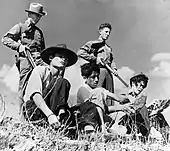
In 1951, the Truman administration's Commission on Migratory Labor released a scathing and xenophobic report blaming the Southwest's social ills on undocumented immigration. The report stated, "The magnitude [of undocumented migration] ... has reached entirely new levels in the past 7 years ... In its newly achieved proportions, it is virtually an invasion."[410] This report, and an August 1953 tour of Southern California, influenced Attorney General Herbert Brownell, Jr. to push Congress to sanction the employers of undocumented workers.[411] This did not become law. Nevertheless, the new Eisenhower administration moved forward with planning a mass deportation operation. On June 9, 1954, the INS Commissioner Joseph Swing announced Operation Wetback, a campaign to deport all undocumented people from the United States. Extensive media coverage during the period exaggerated the Border Patrol's menace and strength, and extensively reported displays of strength as part of a broader PR campaign against undocumented migration.[411] While 1.1 million INS apprehensions occurred that year, estimates place the number of deportations resulting directly from Operation Wetback at around 33,000 people,[412] with perhaps another 60,000 who voluntarily repatriated.[411] Mexican American organizations, such as LULAC and the American G.I. Forum - as well as the broader Mexican American middle-class - were largely supportive of the campaign surrounding Operation Wetback, believing that unauthorized Mexican immigration had "materially retarded" the acceptance and assimilation of Mexican Americans into American culture.[413]
Law and politics
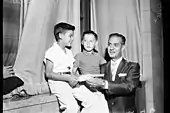
Electorally, Mexican Americans made small but important strides in the 1950s. In Los Angeles, Edward R. Roybal served as the only Mexican American member on the Los Angeles City Council. During his time on council, he took a series of important positions, including: fighting against an ordinance which required communists to register with the police;[414] opposing the tearing down of the Mexican American neighborhood of Chavez Ravine to build Dodger Stadium;[415] and pushing for the establishment of a Fair Employment Practices Commission for the city.[416] In 1954, he also ran for Lieutenant Governor, but he lost to the incumbent Goodwin Knight (R) by more than ten points.[417] Despite these gains in political visibility, however, Mexican American Angelenos also experienced several high-profile incidents of police brutality in the early 1950s, including Bloody Christmas.[418][419]
In the courts, Mexican Americans continued to challenge the legal infrastructure of American segregation. Throughout the Southwest, Mexican Americans were often deliberately excluded from serving as jurors in cases involving Mexican American defendants.[420] In 1954, Pete Hernandez, an agricultural worker, was convicted by an all-Anglo jury in Jackson County, Texas for murder. Hernandez's pro bono legal team, including Gustavo C. García, appealed the ruling, arguing that he was being discriminated against because there were no Mexicans in the jury that convicted him. They argued that Hernandez had the right to be tried by a jury of his peers under the 14th Amendment. The State of Texas denied their claim, but they appealed to the United States Supreme Court through a writ of certiorari.[421] The legal team included García, Carlos Cadena and John J. Herrera of the League of United Latin American Citizens, and James DeAnda and Cris Alderete of the G. I. Forum, both activist groups for civil rights for Mexican Americans. These were the first Mexican-American lawyers to represent a defendant before the U.S. Supreme Court, which heard their arguments on January 11, 1954. Chief Justice Earl Warren and the Supreme Court unanimously ruled in favor of Hernandez, and required he be retried by a jury composed of his peers.
Chicano Movement
1960s
_with_Margarita_Sanchez_at_the_Belmont_High_School_walkout%252C_part_of_a_series_of_1968_student_protests_for_education_reform_in_LA.jpg.webp)


.jpg.webp)
In the 1960s, a sub-group of Mexican American student organizations developed ideologies of Chicano nationalism and the Chicano movement, highlighting American discrimination against Mexican Americans and emphasizing the overarching failures of a culturally pluralistic society.[422] Calling themselves La Raza, Chicano activists sought to affirm Mexican Americans' racial distinctiveness and working-class status, create a pro-barrio movement, and assert that "brown is beautiful."[422] Urging against both ethnic assimilation and the mistreatment of low-wage workers, the Chicano Movement was the first large-scale mobilization of Mexican American activism in United States history.[423]
The Chicano movement blossomed in the 1960s. The movement had roots in the civil rights struggles that had preceded it, adding to it the cultural and generational politics of the era.
In 1963, in Crystal City, Texas the mainly Mexican-American migrant community together with the support of the Teamsters Union and the Political Association of Spanish-Speaking Organizations (PASSO), an outgrowth of the Viva Kennedy clubs of 1960, encouraged Mexican-American men and women to pay their poll tax and choose their own candidates. Led by Teamsters business agent and cannery employee, Juan Cornejo, five Mexican-Americans, despite intimidation by the Texas Rangers, won the support of their community young and old alike who thanks to the protection provided by the Teamsters and PASSO mobilized for electoral victory. This "revolt" was covered nationwide and reported in the New York Times and the Wall Street Journal. This election led Americans outside of the Southwest to take note of America's other minority community as a political force.
The early proponents of the movement — Rodolfo Gonzales in Denver, Colorado and Reies Tijerina in New Mexico — adopted a historical account of the preceding hundred and twenty-five years that obscured much of Mexican-American history. Gonzales and Tijerina embraced a form of nationalism that was based on the failure of the United States government to live up to the promises that it had made in the Treaty of Guadalupe Hidalgo.[424]
That version of the past did not, on the other hand, take into account the history of those Mexicans who had immigrated to the United States. It also gave little attention to the rights of illegal immigrants in the United States in the 1960s — not surprising, since immigration did not have the political significance it was to acquire in the years to come. It was only a decade later when activists embraced the rights of illegal immigrants and helped broaden the focus to include their rights.
The Immigration and Nationality Act of 1965 set strict quotas on the number of persons who could legally enter the U.S. from Latin American nations, and most new Mexican migration to the U.S. in the 1960s was temporary and short-term. Seasonal migration between the United States and Mexico became illegal in 1965. Nevertheless, the numbers involved with seasonal agriculture kept growing, often forced to resort to undocumented migration. They made money in the U.S. but returned to the villages to spend it, tend to the family business, and participate in extended kinship rituals such as baptisms, weddings, and funerals.
The most significant union struggle involving Mexican-Americans was the United Farm Workers' long strike and boycott aimed at grape growers in the San Joaquin and Coachella Valleys in the late 1960s, followed by campaigns to organize lettuce workers in California and Arizona, farm workers in Texas, and orange grove workers in Florida.
The most prominent civil rights organization in the Mexican-American community is the Mexican American Legal Defense and Educational Fund (MALDEF), founded in 1968. Although modeled after the NAACP Legal Defense and Educational Fund, MALDEF has also taken on many of the functions of other organizations, including political advocacy and training of local leaders.
Instead, when the movement dealt with practical problems most activists focused on the most immediate issues confronting Mexican-Americans: unequal educational and employment opportunities, political disenfranchisement, and police brutality. In the heady days of the late 1960s, when the student movement was active around the globe, the Chicano movement brought about more or less spontaneous actions, such as the mass walkouts by high school students in Denver and East Los Angeles in 1968.
The movement was particularly strong at the college level, where activists formed MEChA, el Movimiento Estudiantil Chicano de Aztlán, which promoted Chicano Studies programs and a generalized nationalist agenda. The student movement produced a generation of future political leaders, including Richard Alatorre and Cruz Bustamante in California.
1970s
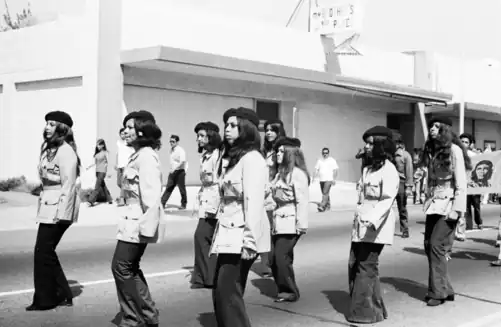
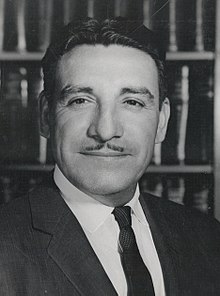
Bottom: Raúl Héctor Castro, the Governor of Arizona from 1975-1977.
Some women who worked within the Chicano movement felt that participants were more worried about other issues, such as immigration than solving problems that affected women. This led Chicanas to form the Comisión Femenil Mexicana Nacional in 1970. The National Chicano Moratorium March was also held in Los Angeles in 1970.
La Raza Unida Party campaigns in the early 1970s had the practical effect of defeating Mexican-American Democratic candidates, embittering many activists against the party and the form of nationalism it represented.
As a result of the Voting Rights Act, followed up by intensive political organizing, Mexican-Americans were able to achieve a new degree of political power and representation in Texas and elsewhere in the Southwest. The La Raza Unida Party, headed by José Ángel Gutiérrez of Crystal City, Texas made startling progress in the poorest regions in the Rio Grande Valley with its base of operations at Crystal City, Texas in the early 1970s, spreading for a while to Colorado, Wisconsin, California, Michigan, Oregon, Kansas, Illinois and several other states. The party faded in the mid-1970s and held on only in Crystal City, Texas before collapsing in the early 1980s. Veterans from the party, such as Willie Velasquez, became active in Democratic politics and in organizing projects such as the Southwest Voter Registration Education Project, which boosted the electoral fortunes of Mexican-American candidates throughout the Southwest.
While the UFW suffered severe setbacks in California in 1973 and never established a strong union presence in other states, its struggle propelled César Chávez and Dolores Huerta into national prominence, while providing the foot soldiers who helped increase the visibility of Mexican-Americans within the Democratic Party in California and elect a number of Mexican-American candidates in the 1970s and 1980s.
By the late 1970s, tactics had forced growers to recognize the UFW as the bargaining agent for 50,000 field workers in California and Florida.
Reagan era
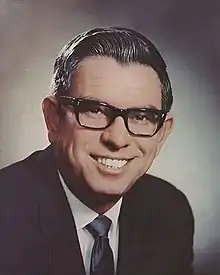
Since the 1980s, Mexican migration has increased dramatically. The Immigration Reform and Control Act of 1986 granted amnesty to illegal immigrants who had resided in the U.S. before 1982 while imposing penalties on employers who hired illegal immigrants. Several factors led to an increase in Mexican immigration to the U.S. The Latin American debt crisis of the 1980s led to high rates of unemployment in Mexico and destroyed the savings of a large portion of the middle-class.
In the 1980s, the first Mexican-American was elected to the Los Angeles City Council in over twenty years. A landmark lawsuit was also filed by the American Civil Liberties Union and the Mexican American Legal Defense and Educational Fund, which argued "the Los Angeles Supervisors in 1981 adopted a plan that fragmented the Latino population into three districts, thus dividing their political power." The outcome of this litigation permitted a Mexican-American to win election to the Los Angeles County Board of Supervisors, the first Mexican American to join that body in more than a century. Ben Fernandez an American politician, financial consultant and special ambassador ran for President of the United States three times, seriously in 1980 and with more perfunctory campaigns in 1984 and 1988, making him America's first major-party presidential contender of Latin American origin.[425] Fernandez was born in Kansas to Mexican parents who were illegal immigrants. At the same time and for similar reasons, neoliberal politician like Henry Cisneros, the mayor of San Antonio, Texas who was a serious contender for the 1984 Democratic Party vice-presidential nomination; Federico Pena the mayor of Denver, Colorado; and Toney Anaya, former governor of New Mexico, emerged as the new voices of Mexican Americans political leadership.
1990s
National politics
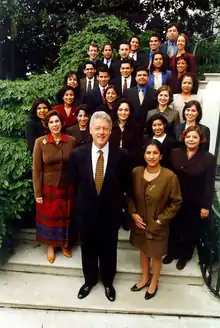
In the final two years of the Bush administration, Congress made several important adjustments to U.S. immigration law. The Immigration Act of 1990 made marrying to evade immigration laws, voting in federal elections as a non-citizen, and "falsely claiming citizenship" to attain employment criminal violations which would lead to incarceration and deportation.[241] The bill also created the temporary protected status (TPS visa), lifted the English testing process for naturalization for permanent residents over 55, and eliminated exclusion of homosexuals as "sexual deviants".[426][427][428]
During the Clinton administration, several cabinet-level Mexican Americans served under President Bill Clinton. These included Henry Cisneros (Department of Housing and Urban Development), Federico Peña (Department of Transportation and Department of Energy), and Bill Richardson (U.S. Ambassador to the United Nations and Department of Energy).[429] Clinton was widely praised for his overall cabinet selections, which were significantly more diverse than prior administrations.[430] During his presidency, however, Clinton's legacy with both Mexico and the Mexican American community was more mixed. His passage of the 1994 Crime Bill is recognized as disproportionately targeting and incarcerating young Mexican American and African American men.[431] Further, his policy of pushing Washington Consensus policies on Mexico led to the 1994 Mexican Peso Crisis,[432] which decimated the Mexican working class and increased migration to the United States. Finally, his signing of the NAFTA is recognized for its harmful effect on both nation's working classes, and the expansion of maquiladoras in states like Baja California, Chihuahua, and Coahuila.[433][434]
Gang culture
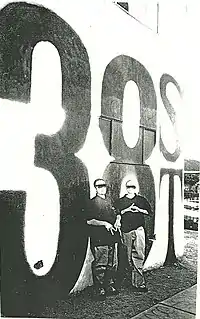

In the 1990s, Chicano youth gang involvement continued to rise across the country, as the result of both the expansion of cocaine markets and widespread socioeconomic changes in the United States.[435] Manufacturing jobs had been decreasing across the U.S. for over twenty years, and as the American economy turned increasingly turned toward the technological and service industries, unemployment rates among young men of color soared in urban areas.[435] Unable to find work in this changing economy, drug markets became the only source of survival for these displaced workers, as the rising prices for crack cocaine became a way for desperate youth to make money.[435] Over time, however, drug markets were monopolized by organized gangs, which actively recruited increasingly younger African American and Chicano youth.[436] Traditional American pathways away from a "gangster lifestyle", such as marriage, family, and stable employment, were largely unavailable to these youth, and in many black, Chicano, and immigrant communities, gang influence emerged as "a dominant informal control and socialization force".[435]
Chicano youth gang activity in the 1990s rose notably in Los Angeles and Chicago, two of the cities with the nation's highest numbers of Mexican Americans,[437] but gang activity rose in almost every U.S. city, including throughout Texas.[438] The political response to gangs such as the Mexican Mafia and 38th Street was a dramatic escalation of the Reagan administration's War on Drugs. Racialized fears of black and brown "superpredators" resulted in tough-on-crime policies in the 1990s, culminating in the infamous Violent Crime Control and Law Enforcement Act of 1994.[439] The law provided local funding to hire over 100,000 new police officers; created grant programs to incentivize drug-related arrests; gave states funds to build massive new prison facilities; and disproportionately criminalized crack cocaine over cocaine.[440][441] Some have argued this bill led directly to the U.S.' rise of mass incarceration.[442]
The ramifications of police militarization were extremely severe, particularly in cities like Los Angeles. In the late-80s, LAPD had responded to gang violence with a series of extremely violent community raids, including Operation Hammer, which was organized under the Community Resources Against Street Hoodlums (CRASH).[443] In the 1990s, as many as 2,000 people a year were killed in Los Angeles County due to gang violence.[444] In September 1993, a mass meeting in Elysian Park organized by La Eme was called to put an end to "violence between Mexicans", however such truces were not usually long-lasting.[445] So, after the passage of the 1994 Crime Bill, the LAPD responded by ramping up its anti-gang tactics, including home and apartment raids, street sweeps, and civil gang injunctions.[446][447]
Union campaigns
In the late 1980s and early 1990s, the Service Employees International Union (SEIU) initiated a series of "Justice for Janitors" campaigns to unionize U.S. janitors.[448] At a march in Los Angeles on June 15, 1990, the striking janitors - many of whom were undocumented Mexican and Central American immigrants - were attacked by the Los Angeles Police Department.[449] The police at first claimed they were acting in "self defense", but TV news footage aired later showed the police violently beating unarmed and peaceful strikers.[450] 60 strikers were jailed, 38 were hospitalized, and two women miscarried.[450][451] One striker told reporters, "What they did to us today in front of the TV cameras is the way the police treat us every day", and another woman stated, "I wasn't robbing a bank or selling drugs, I'm simply asking for an increase in pay, but the police beat us as if we were garbage."[450] Public outrage followed coverage of the event, and the janitors won the union, which doubled their pay and earned them benefits. The strike also inspired janitors in other parts of the country, including Houston, where jailed strikers were held on $20 million dollar bail for "civil disobedience".[450][452] Outrage over the incident in Houston was global, with workers across the U.S. striking in support, and allies in Europe occupying buildings in protest.[450] The Houston strike was successful, and pushed pension fund trustees to develop "responsible contractor" procedures.[450][453] The 2000 film Bread and Roses was based on the Los Angeles campaign.[454] In the mid-90s, the Industrial Workers of the World (IWW) also sought to organize Mexican workers, including troqueros and taxi drivers in LA.[455]
Los Angeles uprising
.jpg.webp)
.jpg.webp)
.jpg.webp)
The 1992 Los Angeles uprising was an uprising against police brutality that occurred in Los Angeles County in April and May 1992.[456] Unrest began in South Central Los Angeles on April 29, after a trial jury acquitted four officers of the Los Angeles Police Department (LAPD) for usage of excessive force in the arrest and beating of Rodney King, which had been videotaped and widely viewed in TV broadcasts. Though much of the media coverage surrounding the events focused on constructing either a "black vs. white" or a "black vs. Asian" narrative (due to the tensions caused by the murder of Latasha Harlins),[457] the majority of people arrested during the uprising were Latino.[458] Analysis of charges in the riot's peak days showed 51% of defendants were Latino and 36% were black, and, of the 58 total people killed during the riots, more than one-third were Latino.[459][460] Stanford University professor Joan Petersilia stated about the uprising, "This was clearly not a black riot. It was a minority riot."[461]
The majority of the Latino residents of South Central Los Angeles in the early 1990s were recent Mexican immigrants and Central Americans.[460] As a result, when the city's Latino leadership met during the uprising to discuss resolution strategies, the disconnect between LA's Mexican-American establishment and South LA's recent migrant community was more fully understood.[460] Los Angeles County's only Latino supervisor, Gloria Molina, told The New York Times that in the days when Los Angeles was burning, she received multiple calls from Mexican American constituents urging her to denounce South Central's Mexican population. Molina stated, "They would say, 'Well, Gloria, it wasn't us doing the looting and the burning. It was those immigrants.'"[460] Molina went further and stated, "They wanted me to denounce them. But I say, let's not let that divide us."[460]
Even white journalists, such as the Los Angeles Times reporter Jack Miles, noted the tension between the South and East LA Latino communities.[462] He wrote, the "law-abiding Mexican-American community" of East Los Angeles resented being associated with the Latinos of South Los Angeles, and that the incident marked the beginning of a Mexican American "anti-immigrant stance".[462] In the years after the uprising, some journalists focused on the long-term interracial scars left by the racial uprising,[463] while others focused on the multiple intra-ethnic meanings the uprising held for Latino communities in Los Angeles.[464] Historians have also explained some of the reasons why there was so much Latino participation, including: the brutality that Latinos also experienced from the LAPD; the near-constant threat of deportation; and the neoliberal defunding of inner-city municipal services.[465]
Proposition 187

Proposition 187 (also known as the Save Our State (SOS) initiative) was a 1994 ballot initiative to establish a state-run citizenship screening system and prohibit undocumented immigrants from using non-emergency health care, public schooling, and other services in the State of California.[466] The bill was widely opposed by the state's Latino communities, though some Mexican Americans did express support for the measure.[467] In the lead-up to the November vote, there were widespread "No on 187" protests throughout California, as activists urged that a full denial of basic rights to undocumented people would be detrimental to the state.[468] In October 1994, an estimated seventy thousand people marched in Los Angeles to protest Prop. 187 in one of the largest protests in U.S. history.[469] The political atmosphere in California at the time, however, was extremely xenophobic,[470] and coverage of the protest focused on the large number of Latino, Mexican, and Mexican American participants and especially expressed outrage at the presence of Mexican flags at the protest.[471] Proposition 187 passed with 58% of the vote.[472] Shortly after the proposition's passage, U.S. District Court Judge Mariana R. Pfaelzer in Los Angeles ruled that preventing undocumented children from attending K-12 schools was unconstitutional and prevented the implementation of most of the measure's other provisions.[473] Proposition 187, though overturned, significantly eroded Mexican American and Latino support for the California Republican Party.[474] In many ways, however, its basic tenets shaped the future of American debates regarding the rights of undocumented people in the U.S.[475] Culturally, the measure also had a strong impact on the community. In Selenidad (2009), the poet Deborah Paredez connected the collective trauma of the 1995 death of Selena to the community's response to the measure's initial passage, writing, "Selena's death galvanized Latino efforts to publicly mourn collective tragedies (such as approved anti-Latino legislation in California, Proposition 187 and Proposition 229) and to envision a brighter future."[476]
Early 2000s

The 2000 Census showed that the foreign-born population of the U.S. increased by 11.3 million people in the 1990s, and Mexican immigrants accounted for 43% of that growth.[477] The region which had the fastest-growing immigrant population was the Southeast, where many Mexicans who found work in construction, as migrant agricultural laborers, and in textile mills and chicken processing plants. The Latino populations of Georgia, North and South Carolina, and Arkansas increased between 300 and 400 per cent from 1990 to 2000.[478]
A major focus of Chicano activists in the 21st century has been to advance the representation of Chicanos in all American mainstream media.[479] Criticism of the American mainstream news media and U.S. educational institutions by Chicano activists has been particularly harsh in recent years subsequent to the massive displays of support for immigrant rights such as that seen during La Gran Marcha[480] (The Great March) on March 25, 2006 in Los Angeles. As of today, this self-proclaimed "largest march in U.S. history" which was primarily organized by Mexican American organizations, Chicano activists, and fueled through a large network of active Internet users, L.A. Spanish language television, and Spanish language news radio coverage, is still virtually ignored by American mainstream (English language) news media and all textbooks of the American educational system.
After the increased border security following the 9-11 attacks in 2001, the back-and-forth pattern became dangerous. People kept coming north, but they stayed in the U.S. and sent money home every month. Locked into the American economy year-round, millions of these undocumented workers moved out of season agricultural jobs into year-round jobs in restaurants, hotels, construction, landscaping and semiskilled factory work, such as meatpacking. Most paid federal social security taxes into imaginary accounts (and thus were not eligible for benefits.) Few had high enough incomes to pay federal or state income taxes, but all paid local and state sales taxes on their purchases as well as local property taxes (via their rent payments to landlords). By 2007 there were 12 million or so undocumented workers in the U.S.

In 2005, Antonio Villaraigosa was elected mayor of Los Angeles, the first Latino in 130 years to hold the seat. Eric Garcetti became the second consecutive Mexican American mayor.
Mexican-Americans tend to vote Democratic (in 1960, the John F. Kennedy presidential campaign boosted the Mexican American vote to over 80% for Kennedy). However, Mexican Americans in recent decades had a low turnout on election day. In 1984, 37 percent of Latino Americans voted for Ronald Reagan and George W. Bush targeted Latinos and won 35% of their votes in 2000, and 40% in 2004 and the fact that his brother Jeb Bush is married to a Mexican woman (Columba Bush).
Voters have elected a number of governors of Mexican descent in the Southwest, include Ezequiel Cabeza De Baca, Octaviano Ambrosio Larrazolo, Jerry Apodaca, Toney Anaya, Bill Richardson, and Raúl Héctor Castro in Arizona. Cruz Bustamante was the first Democratic lieutenant governor of California in 130 years from his election in 1999 to 2007, but Bustamante lost the gubernatorial election to Austrian-born actor Arnold Schwarzenegger, who went on to be state governor. Romualdo Pacheco served as 12th governor of California and remains the only Latino governor in the state's history as part of the United States.
2010s
Electoral politics
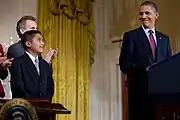
Mexican Americans made significant electoral strides during the Obama Era. In 2010, the Republican Brian Sandoval was elected governor of Nevada; he was the first Latino to ever do so.[481] That same year, the Republican Susana Martinez became the first woman and Latina to be elected as governor of New Mexico and was the first Republican Latina governor in U.S. history.[482] Also in 2010, Joseph García was elected the first Latino lieutenant governor of Colorado in the state's history.[483][484]
During the 2012 United States presidential election, President Obama ran against the former-governor of Massachusetts Mitt Romney. During the campaign, Romney sparked outrage amongst many Mexican and Mexican American officials when he suggested the economic disparities between the United States and Mexico were the result of the "hand of providence".[485] Latinos voted overwhelmingly for President Obama's re-election in 2012, when he earned as much as 71% of the community's vote.[486] In response to their overwhelming defeat, Reince Priebus, the chair of the Republican National Committee, ordered an "autopsy report" to assess deficiencies and paths forward for the party.[487] The report called for greater inclusion of Mexican Americans, Latinos, and other minority groups, stating, "If Hispanic Americans hear that the GOP doesn't want them in the United States, they won't pay attention to our next sentence. It doesn't matter what we say about education, jobs or the economy; if Hispanics think that we do not want them here, they will close their ears to our policies."[488] The report, however, was largely ignored by the GOP in the years ahead.[489]
Immigration

In the 2010s, nativism in the United States increased, particularly in border states like Arizona. In 2010, the Arizona State Legislature proposed and passed the Support Our Law Enforcement and Safe Neighborhoods Act (SB 1070). Critics of the bill argued it was a fundmantally racist law designed to legalize racial profiling.[490] In Arizona v. United States (2012), the Supreme Court overturned three provisions of the bill, including: requiring "legal" immigrants to carry registration documents at all time; allowing state police to arrest any individual for suspicion of being undocumented; and making it a crime for undocumented people to search for or hold jobs in the state.[491][492][493] Despite its overturning, the bill had negative social effects on the Mexican and Mexican American communities, particularly for children and youth.[494][495][496] In the same year Arizona passed SB1070, it also passed Arizona House Bill 2281, effectively barring Mexican American Studies (history and literature) from being taught in the state's public schools.[497][498]
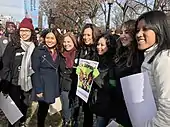
On June 15, 2012, President Barack Obama announced an executive branch memorandum known as Deferred Action for Childhood Arrivals (DACA).[499] This change to immigration policy allowed eligible undocumented individuals brought to the country as children to receive a renewable two-year period of deferred action from deportation and become eligible for a work permit in the U.S. (without providing a path to citizenship for recipients).[500] U.S. Citizenship and Immigration Services (USCIS) began accepting applications for the program on August 15, 2012, and in less than one year, over half a million people applied to the DACA program.[501] The next year, in 2013, a bi-partisan group of eight United States Senators—known as the Gang of Eight—wrote the first draft of the Border Security, Economic Opportunity, and Immigration Modernization Act of 2013.[502] The bill would have provided a path to citizenship for millions of undocumented Americans.[503] It passed the Senate with a strong majority—68–32, with 14 Republicans joining all Democrats; however, the United States House of Representatives under Speaker John Boehner did not act on the bill, and it expired at the end of the 113th Congress.[504]
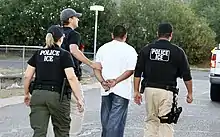
During his time in office, President Obama was known in the Mexican American community as the "Deporter in Chief".[505] Between 2009 and 2015, his administration removed more than 2.5 million people from the country, though some analysts claimed these numbers were "misleading" due to the way they were calculated.[506][507] During his time in office, the Department of Homeland Security initiated two policies which represented a major shift from prior administrations. First, DHS began placing undocumented border crossers through formal removal proceedings; second, it made non-citizens "with criminal records" the agency's top deportation target.[508] Thus, when faced with criticism for his administration's record high deportation numbers, President Obama responded by saying, "The statistics are actually a little deceptive ... we've been apprehending folks at the borders and sending them back. That is counted as a deportation even though they may have only been held for a day or 48 hours."[509] Nevertheless, Obama faced significant criticism for his failure to pass immigration reform and for the detrimental effects of deportation on families' lives.[510][511]
Gentrification

One of the most serious issues facing urban Mexican Americans in the 2010s was residential displacement through gentrification. In San Francisco's historic Latino neighborhood, the Mission District, the rapid expansion of Silicon Valley created a housing shortage, which incentivized investors to buy properties in historically low-income neighborhoods (like the Mission) in order to renovate them and sell them at higher rates to tech workers.[512][513] As a result, many of the neighborhoods' taquerias, bakeries, bars, and auto mechanic shops were replaced with luxury condominiums, organic ice cream stores, international art galleries, and upscale cafes.[514] Significant resistance to the Mission's gentrification emerged, including the "restorative economics" of La Cocina Community Kitchen, the resistance art projects of the Clarion Alley Mural Project, the San Francisco tech bus protests, and the "radically inclusive" social services provided by the Dolores Street Community Services Shelter.[515]

In Los Angeles, gentrification affected the traditionally Mexican American neighborhoods of Echo Park, Highland Park, and large swaths of East Los Angeles, particularly the neighborhood of Boyle Heights. As white, college-educated young people increasingly moved to Los Angeles in the 2010s, they wanted to live in "hip", "urban", "edgy" and importantly, affordable, neighborhoods.[516] Their presence increasingly pushed rent up and made the neighborhoods unaffordable to long-time residents.[517] In Boyle Heights, this process was sped up by the arrival of a subway station, called Mariachi Plaza station, which made the neighborhood even more desirable to young white gentrifiers wanting easy access to the rest of Los Angeles.[518] In 2016, significant controversy arose when the message "Fuck White Art" was spray-painted on the entrance to the Nicodim Gallery in Boyle Heights, especially when the LAPD classified the graffiti as a "hate crime".[519] Modern commentators compared gentrification to the urban renewal projects of the 20th century and connected urban displacement to American capitalism, racism, and colonization.[520][521]
.jpg.webp)
Gentrification affected many major urban Mexican American populations in the country, including in cities like San Diego, Albuquerque, and Chicago.[522] In the historically Mexican American neighborhood of Pilsen in Chicago, working class families experienced high levels of displacement due to rising rents and property taxes.[523] Pilsen (which had grown as a Mexican American enclave in the 1960s and 1970s when expansions to the University of Illinois at Chicago's campus forced them into the neighborhood)[524] became a "tourist attraction" in the 2010s, where sanitized versions of "Latinoness" were marketed to developers and new potential residents.[525] The result was the opening of new businesses catered primarily to upscale non-resident visitors and recent arrivals. Pilsen's primary tool to resist gentrification was a grassroots effort to designate the neighborhood a historic landmark.[526]
LGBT rights
.jpg.webp)
LGBTQ+ rights made significant strides in the 2010s. Between 2010 and 2019, public support for marriage equality rose by over 19 points, and 2011 marked the first time in U.S. history that more people supported same-sex marriage than opposed it.[527] In 2011, President Obama formally ended the policy of "Don't ask, don't tell", allowing openly-identified gay men and lesbians to serve in the U.S. military.[528] In 2015, the U.S. Supreme Court ruled in Obergefell v. Hodges that same-sex marriage was a constitutionally-protected right under the 14th Amendment.[529] Around the time of the Supreme Court's ruling, Latino support for marriage equality was amongst the highest of any ethnic group.[530]
Despite these significant strides, however, the Mexican American and Latino LGBT communities continued to struggle with many challenges. In the aftermath of the Great Recession, an approximately 4.2 million youth experienced homelessness in the U.S., of which 700,000 were unaccompanied minors.[531] Of these 4.2 million, estimates range that between eleven and forty percent were LGBTQ, many of whom were Mexican American or Latino.[532][533] Transgender equality also remained a major issue for many Mexican Americans. In the 2010s, black and Latino transgender women experienced homicide rates widely disproportionate to their percentage of the overall population.[534][535] The failure of the Obama administration or mainstream LGBT organizations to address any of these difficulties created outrage amongst the LGBT Mexican American and Latinx communities. In 2015, the activist Bamby Salcedo disrupted the opening session of the National LGBTQ Task Force's annual conference to protest the white LGBT community's continued ignorance regarding violence against transgender women of color.[536][537] In the 2010s, LGBT Mexican and Latino ICE detainees also experienced alarmingly high rates of sexual abuse in U.S. immigration detention centers.[538][539] The undocumented activist Jennicet Gutiérrez interrupted a speech by President Obama during a White House LGBT celebration dinner in 2015 to protest violent detention center conditions for LGBT Latinos.[540]
"Build that wall!"

From the start of Donald Trump's campaign for president, he faced accusations of racism and discrimination against Mexicans and Mexican Americans. In his announcement speech in August 2015, Trump said the United States had become a "dumping ground" for unwanted people from other countries and received pushback in particular for his statement: "When Mexico sends its people, they're not sending their best. They're bringing drugs. They're bringing crime. They're rapists. And some, I assume, are good people."[541] The comment was interpreted by many to imply that immigrants from Mexico had been "sent" to the U.S., and that many could be generalized as "criminals and rapists".[542][543] In June 2016, Trump was again accused of racism when he said he would be unable to receive a fair hearing from the Mexican American judge Gonzalo Curiel because, "The judge, who happens to be, we believe, Mexican ... [has] an absolute conflict ... I'm building a wall. It's an inherent conflict of interest."[544][545][546] The border wall was one of the central themes of Trump's 2016 campaign, with many of his rallies featuring the chant, "Build that wall!"[547] Numerous commentators noted the racial and nativist connotations underlying the campaign pledge to build a wall.[548] Studies conducted during the 2016 presidential election showed negative online discourse surrounding Latinos was so severe that it negatively affected the community's mental well-being.[549] Nevertheless, Trump won at least 18% of the Latino vote in 2016.[550][551]

While in office, the Trump administration unleashed a series of controversial policies affecting Latinos. On May 7, 2018, Jeff Sessions, then Trump's attorney general, announced a new "zero tolerance" policy at the U.S.-Mexico border, meaning any person apprehended crossing the border without documentation would be charged criminally and any children accompanying them would be held separately.[552] Though the policy was ended by executive order within a month, more than 500 children remained separated from their parents more than two years later.[553] During the 2018 midterm elections, Trump politicized the Central American refugee crisis, claiming "terrorists" and "gang members" were secretly hiding alongside women and children in order to gain entry into the United States.[554] After the midterm elections, the Trump administration adopted the "Remain in Mexico" program, which essentially sought to shut down asylum entry into the country.[555] The policy resulted in a humanitarian crisis, as tens of thousands of refugees were forced to live in makeshift tent encampments in Mexico while they awaited an asylum hearing.[556][557] Trump's efforts on the border resulted in the erection of over 53 miles of new border wall and the renovation of over 400 miles of existing border walls;[558] this wall construction sparked outrage for its impact on indigenous communities.[559] During the Trump years, Immigration and Customs Enforcement also collaborated with other U.S. law enforcement agencies, such as the U.S. Marshals, to conduct large "crime raids", during which hundreds of people were arrested and deported if found to be undocumented.[560] In fact, in 2019, ICE conducted the largest single-state immigration raid in U.S. history.[561]
Trump protests
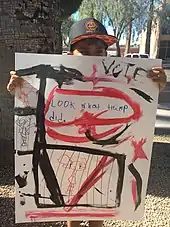
The 2010s saw levels of mass protest unseen in the United States since the Civil Rights movement of the 1960s. In 2017, the Day without Immigrants protested President Donald Trump's plans to build a border wall and to potentially deport millions of undocumented immigrants.[562] In 2018, protests against Trump's family separation policy occurred in over 700 cities and towns in the United States, many under the title, "Families Belong Together".[563][564] Also in response to the Trump's family separation policies, widespread calls emerged to shut down U.S. Immigration and Customs Enforcement (ICE),[565] usually expressed under the slogan "Abolish ICE".[566] In 2019, as the Trump administration sought to end the DACA program, the United States Supreme Court agreed to hear their case.[567] DHS v. University of California created significant controversy, and major protests in support of "Dreamers" occurred across the country.[568][569] Major American corporations also voiced their support for the DACA program,[570] and the Supreme Court ultimately upheld the program.[571] Mexicans Americans were also involved with many of the major social movements during the Trump presidency, including the movement for Black Lives Matter and racial justice,[572] the Women's March (the Chicana activist Carmen Perez was one of four national co-chairs of the 2017 March),[573] and gun control movements like March For Our Lives.[574] According to some scholars, the intense activist energy during the Trump presidency motivated young Mexican Americans to adopt a political identity of "neo-Chicanismo", defined by ethnic pride, cultural heritage and expression, and protecting immigrants' rights.[575][576] This younger activist generation also actively adopted gender neutral language, such as the terms "Chicanx" and "Xicanx" as a way to push back against gender bias in politics, society, and activism.
El Paso shooting

Over the course of the 2010s, the rise of white nationalist domestic terrorism increased dramatically.[577] There was a large surge in white supremacist and other hate group membership over the course of the Obama administration,[578] and the United States saw a record number of hate crimes committed during the Trump administration.[579] In 2019, one of the largest mass shootings against Latino Americans occurred at a Walmart store in El Paso, Texas when a 21-year old white terrorist open-fired, killing 23 people and injuring 23 others.[580][581] The terrorist, named Patrick Crusius, was mostly radicalized online, a trend which has occurred with increasing frequency in the United States.[582][583] National security experts have compared the radicalization of white and other far-right terrorists to the online recruitment of terror organizations like ISIS.[584] Shortly before the attack, the terrorist posted his "manifesto" to the online message board 8chan, where he wrote about the "Latino invasion of Texas" and detailed a plan to separate America by race, claiming "white people were being replaced by foreigners."[585] The terrorist faces 90 federal charges, including 23 counts of federal hates crimes resulting in death, and he will face the death penalty if found guilty.[586]
2020s
Politics
.jpg.webp)
In 2020, former House Representative and Secretary of Housing and Urban Development Julian Castro became the first serious Mexican American candidate for president since Ben Fernandez ran in the 1980 Republican primaries.[587] Castro dropped out of the race on January 6, 2020, after polling far behind other candidates,[588] and he announced his support for Joe Biden on June 2, 2020.[589] During the 2020 general election, some experts were surprised at the strength of Donald Trump's support amongst Mexican Americans in areas like the Rio Grande Valley, which increased by 10% from 2016.[590][591] Others, however, noted that the increase toward Trump in 2020 represented the culmination of long-term trends within the Mexican American and Latino communities.[592] In December 2020, Alex Padilla was appointed to replace Vice President Kamala Harris as the junior senator from California.[593] He was sworn in by Harris in January 2021, thus becoming the first Latino senator in the state's history.[594][595]
Police violence
_(51130533546).jpg.webp)
In the 2020s, Mexican Americans and other Latinos joined calls for racial justice and an end to police brutality in the United States.[596][597][598] Analysis of fatal U.S. police shootings in October 2020 showed that in the prior five years, Native Americans, black Americans, and Latinos were the three ethnic groups killed by police at the highest rates in the country, respectively.[599] Activists within the community, however, expressed frustration that in the years leading up to the 2020–21 United States racial unrest, police killings of Latino boys and men had largely been met with sustained national indifference.[600][601][602][603] Several cases did generate national headlines.[604] Outrage was expressed when eighth-grader Andy Lopez (13 years old) was shot and killed by the Sonoma County sheriff's deputy who mistook Lopez' toy gun for a real gun, and no criminal charges were ever filed.[605] The death of Andres Guardado (18 years old) also sparked outrage after a Los Angeles Sheriff's Department whistleblower claimed the officer killed Guardado as part of an "initiation".[606][607] Nationally, over 900 Latinos were killed by the police in just the five years leading up to 2020.[605][608] Some of these killings of young unarmed Latino men drew outrage for their sheer brutality. In the case of Sean Monterrosa (22 years old) in Vallejo, California, Monterrosa was apprehended, on his knees, with his hands held above his waist, when police opened fired and killed him.[609] In the case of Alex Nieto (28 years old), Nieto was eating his dinner of a burrito and chips before work at a San Francisco park when a passerby called 9-1-1 because he considered Nieto suspicious. When the SFPD arrived, one officer shot 23 rounds at Nieto, another officer shot him 20 times, and two more officers shot Nieto at least 5 more times while he lay dying, yet no officer was criminally charged.[610][605] In March 2021, 13-year old Adam Toledo in Chicago was chased into an alley before being shot and killed by police.[611]
COVID-19

The COVID-19 pandemic disproportionately impacted the Mexican American and Latino communities. Professor Rogelio Sáenz described the pandemic's effect on Tejanos and Latinos in Texas, saying, 2020 was "a hellish, hellish year. Once you adjusted for age, you really see clearly that Latinos were dying at rates more than three times as high as the white population."[612] In 2020 alone, approximately 1 in 1,150 Latinos in the United States died from COVID-19.[613][614] Because many Mexican Americans and Latinos disproportionately work in the service-sector and were thus considered part of the "essential" workforce, they had to bear a major part of the pandemic's force.[615][616] Complications from the coronavirus were especially dire for Latinos without health insurance.[617] In the economic fallout of the pandemic, many Mexican Americans and Latinos relied on food banks and unemployment insurance to keep their families alive.[618][619]
Historiography
Scholars of Mexican American history
|
|
See also
- Latino Americans
- History of Mexico
- History of United States
- List of Mexican Americans
- Mexican American
- Mexico
- Spanish Americans
- History of Hispanic and Latino Americans
By state:
In other regions:
Notes
- "Treaty of Guadalupe Hidalgo". University of Houston, Digital History. University of Houston. Retrieved 18 August 2020.
- Baca, Herman. "The little-known treaty of Guadalupe Hidalgo and 5 years of conquest" (PDF). The San Diego Union-Tribune. University of California, San Diego. Retrieved 18 August 2020.
- Steinhauer, Jason (11 March 2015). "The History of Mexican Immigration to the U.S. in the Early 20th Century". Insights: Scholarly Works at the John W. Kluge Center. Library of Congress. Retrieved 18 August 2020.
- "The Mexican Revolution 1910-1917". UT Liberal Arts Instruction Technology Services. University of Texas, Austin. Retrieved 18 August 2020.
- Garcilazo, Jeffrey Marcos (February 16, 2016). Traqueros: Mexican Railroad Workers in the United States, 1870 to 1930 (2 ed.). University of North Texas Press. ISBN 978-1574416275. Retrieved 18 August 2020.
- Anderson, Lydia R. "Hispanics in the Midwest" (PDF). Center for Family and Demographic Research. Bowling Green State University. Retrieved 18 August 2020.
- Kochhar, Rakesh; Suro, Roberto; Tafoya, Sonya (26 July 2005). "The New Latino South: The Context and Consequences of Rapid Population Growth". Pew Research Center: Hispanic Trends. Pew Research Center. Retrieved 18 August 2020.
- Lopez, Mark Hugo (8 September 2016). "Ranking the Latino population in the states". Pew Research Center. Retrieved 18 August 2020.
- "Chicano/Latino Movements History and Geography". Mapping American Social Movements. University of Washington. Retrieved 18 August 2020.
- de Otermín, Antonio (20 November 2008). A Forgotten Kingdom: The Spanish Frontier in Colorado and New Mexico, 1540-1821. National Park Service. Retrieved 18 August 2020.
- "Spanish California". California as I Saw It: First-Person Narratives of California's Early Years, 1849 to 1900. Library of Congress. Retrieved 18 August 2020.
- Weber, David (January 1, 1990). Myth and the History of the Hispanic Southwest (1 ed.). University of New Mexico Press. ISBN 978-0826311948. Retrieved 18 August 2020.
- "Colonial New Mexico" (PDF). City of Albuquerque. Retrieved 18 August 2020.
- "Spanish New Mexico". National Museum of American History. Smithsonian Institution. 12 June 2017. Retrieved 18 August 2020.
- Gutiérrez, Ramón A. (January 1, 1991). When Jesus Came, the Corn Mothers Went Away (1 ed.). Palo Alto: Stanford University Press. ISBN 978-0804718325. Retrieved 19 August 2020.
- Whitehurst, Katie. "Spanish Colonial". Texas PBS. PBS. Retrieved 18 August 2020.
- "Conquistadors and Spanish Colonial Period" (PDF). Department of Emergency and Military Affairs. Government of Arizona. Retrieved 18 August 2020.
- "San Diego Mission Church (San Diego de Alcala)". Early History of the California Coast. National Park Service. Retrieved 18 August 2020.
- Castañeda, Antonia I. "Sexual Violence in the Politics and Policies of Conquest: Amerindian Women and the Spanish Conquest of Alta California". UC Berkeley Law School. University of California, Berkeley. Retrieved 18 August 2020.
- Miguel-Stearns, Teresa M. (June 6, 2014). Sources of State Practice in International Law (2 ed.). Brill - Nijhoff. p. 371. ISBN 978-9004178861. Retrieved 18 August 2020.
- "Mexican California". California as I Saw It: First-Person Narratives of California's Early Years, 1849 to 1900. Library of Congress. Retrieved 19 August 2020.
- Camarillo, Albert (February 1, 1996). Chicanos in a Changing Society: from Mexican Pueblos to American Barrios in Santa Barbara and Southern California, 1848-1930 (1 ed.). Cambridge: Harvard University Press. ISBN 978-0674113978. Retrieved 19 August 2020.
- Sandos, James A (July 1985). "Levantamiento!: The 1824 Chumash Uprising Reconsidered". Southern California Quarterly. 67 (2): 109–133. doi:10.2307/41171145. JSTOR 41171145.
- Hollenbaugh Aviña, Rose (November 1, 1976). Spanish and Mexican Land Grants in California. Ayer Company Publishing. ISBN 978-0405094835.
- Manuel P., Servín (June 1965). "The Secularization of the California Missions: A Reappraisal". Southern California Quarterly. 47 (2): 133–149. doi:10.2307/41169919. JSTOR 41169919.
- "Secularization and the Rancho Era, 1834-1846" (PDF). Ohlone/Costanoan Indians of the San Francisco Peninsula and their Neighbors, Yesterday and Today. National Park Service. Retrieved 19 August 2020.
- Almaguer, Tomás (December 30, 2008). Racial Fault Lines: The Historical Origins of White Supremacy in California (1 ed.). Berkeley: University of California Press. ISBN 978-0520257863. Retrieved 19 August 2020.
- Hackel, Steven W. "Land, and, Labor, and Production: The Colonial Economy of Spanish and Mexican California". University of California Press.
{{cite journal}}: Cite journal requires|journal=(help) - Casas, Maria Raquel (March 28, 2009). Married to A Daughter of the Land: Spanish-Mexican Women and Interethnic Marriage in California, 1820-1880 (1 ed.). University of Nevada Press. ISBN 978-0874177787. Retrieved 19 August 2020.
- "Texas Declaration of Independence". The Republic of Texas - The Texas Revolution. Texas State Library and Archives Commission. Retrieved 19 August 2020.
- "The Republic of Texas - The Texas Revolution". The Battle of San Jacinto. Texas State Library and Archives Commission. Retrieved 19 August 2020.
- "The Treaties of Velasco". The Republic of Texas - The Texas Revolution. Texas State Library and Archives Commission. Retrieved 19 August 2020.
- "Tejano Voices and the Demand for Inclusion". Texans' Struggle for Freedom and Equality. Texas State Library and Archives Commission. Retrieved 19 August 2020.
- Costeloe, Michael P. (August 21, 2008). The Central Republic in Mexico, 1835-1846: 'Hombres de Bien' in the Age of Santa Anna (1 ed.). London: Cambridge University Press. ISBN 978-0521530644. Retrieved 19 August 2020.
- "The Mexican American War". American Experience. PBS. Retrieved 19 August 2020.
- "Mexican American War". American Experience. PBS. Retrieved 19 August 2020.
- "Zachary Taylor". A Continent Divided: The U.S.-Mexico War. The University of Texas Arlington. Retrieved 19 August 2020.
- "The Senate Votes for War against Mexico". United States Senate. Retrieved 19 August 2020.
- Hollon, Cory S. (Winter 2015). "'A Leap in the Dark': The Campaign to Conquer New Mexico and California, 1846–1847". Army History. 94 (94): 6–26. JSTOR 26300360.
- Lozano, Rosina (April 24, 2018). An American Language: The History of Spanish in the United States (1 ed.). Berkeley: University of California Press. ISBN 978-0520297074. Retrieved 20 August 2020.
- Gonzalez, Albert. "The 1847 Revolt: The Beginning of Modern Taos". University of New Mexico, Taos. Archived from the original on 2021-12-12. Retrieved 20 August 2020.
- Beyreis, David C. (Spring 2019). "Dangerous Alliances in the New Mexico Borderlands: Charles Bent and the Limits of Family Networks". Journal of the Early Republic. 39 (1): 57–80. doi:10.1353/jer.2019.0005. S2CID 151104726.
- "Mexican-American War". Naval History and Command Center. United States Navy. Retrieved 20 August 2020.
- "Mexican American War: Timeline of Major Events". University of Michigan. Retrieved 20 August 2020.
- "Treaty of Guadalupe Hidalgo". The Avalon Project: Documents in Law, History, and Diplomacy. Yale Law School. Retrieved 20 August 2020.
- "The Annexation of Texas, the Mexican-American War, and the Treaty of Guadalupe-Hidalgo, 1845–1848". Office of the Historian. United States Department of State. Retrieved 20 August 2020.
- "Treaty of Guadalupe Hidalgo". Digital History. University of Houston. Retrieved 20 August 2020.
- "The Treaty of Guadalupe Hidalgo". Hispanic Reading Room. Library of Congress. Retrieved 20 August 2020.
- Hornbeck, David (October 1979). "The Patenting of California's Private Land Claims, 1851-1885". Geographical Review. 69 (4): 434–448. doi:10.2307/214806. JSTOR 214806. Retrieved 20 August 2020.
- Smith, Marian L. (15 August 2016). "Race, Nationality, and Reality". Prologue. National Archives. Retrieved 20 August 2020.
- Montoya, Margaret E. "Latinos and the Law". American Latino Theme Study: Law. National Park Service. Retrieved 20 August 2020.
- Klein, Christine A. (Spring 1996). "Treaties of Conquest: Property Rights, Indian Treaties, and the Treaty of Guadalupe Hidalgo". New Mexico Law Review. 26 (2). Retrieved 20 August 2020.
- Weber, David (March 1, 2004). Foreigners in Their Native Land: Historical Roots of the Mexican Americans (2 ed.). Albuquerque: University of New Mexico Press. ISBN 978-0826335104. Retrieved 25 August 2020.
- Gómez, Laura E. "Off-White in an Age of White Supremacy: Mexican Elites and the Rights of Indians and Blacks in Nineteenth-Century New Mexico" (PDF). Law Center. University of Houston. Retrieved 25 August 2020.
- Hernandez, Jose Angel. "The Decree of 19 August 1848: The First Repatriation Commissions and Postwar Settlements along the US-Mexico Borderlands". The Center for Mexican American Studies. University of Houston. Retrieved 25 August 2020.
- Nostrand, Richard L. (September 1975). "Mexican Americans Circa 1850". Annals of the Association of American Geographers. 65 (3): 378–390. doi:10.1111/j.1467-8306.1975.tb01046.x. JSTOR 2561888. Retrieved 25 August 2020.
- "New Mexico" (PDF). U.S. Census Library. United States Census. Retrieved 25 August 2020.
- Campbell, Randolph B. (March 15, 2017). Gone to Texas: A History of the Lone Star State (3 ed.). Cambridge: Oxford University Press. pp. 190–191. ISBN 978-0190642396. Retrieved 24 August 2020.
- De León, Arnoldo (January 1, 1983). They Called Them Greasers: Anglo Attitudes toward Mexicans in Texas, 1821–1900 (1 ed.). University of Texas Press. ISBN 978-0292780545. Retrieved 24 August 2020.
- "California" (PDF). Census of 1850: California. United States Census. Retrieved 26 August 2020.
- Monroy, Douglas (May 25, 1993). Thrown Among Strangers: The Making of Mexican Culture in Frontier California (1 ed.). Berkeley: University of California Press. ISBN 978-0520082755. Retrieved 24 August 2020.
- Field, Margaret A. "Genocide and the Indians of California, 1769-1873". Scholarworks. University of Massachusetts, Boston. Retrieved 25 August 2020.
- Madley, Benjamin (May 24, 2016). An American Genocide: The United States and the California Indian Catastrophe, 1846-1873 (1 ed.). New Haven: Yale University Press. ISBN 978-0300181364. Retrieved 25 August 2020.
- "Miguel Antonio Otero". History, Art, and Archives. United States House of Representatives. Retrieved 26 August 2020.
- "José Manuel Gallegos". History, Art, and Archives. United States House of Representatives. Retrieved 26 August 2020.
- "José Manuel Gallegos". Hispanic Americans in Congress, 1822-1995. Library of Congress. Retrieved 26 August 2020.
- Gates, Paul W. (Spring 1974). "The Frémont-Jones Scramble for California Land Claims". Southern California Quarterly. 56 (1): 13–44. doi:10.2307/41170514. JSTOR 41170514. Retrieved 26 August 2020.
- Rodríguez, Roberto; Gonzales, Patrisia. "The Treaty of Guadalupe Hidalgo Still Relevant Today". DePaul University Libraries. DePaul University. Retrieved 26 August 2020.
- "California Population by Ethnic Groups, 1790-1880". Myth and Reality: The California Gold Rush and Its Legacy. Museum of California. Retrieved 26 August 2020.
- Gates, Paul (December 1971). "California Land Act of 1851". California Historical Quarterly. University of California Press. 50 (4): 395–430. doi:10.2307/25157352. JSTOR 25157352. Retrieved 26 August 2020.
- "California Land Act of 1851" (PDF). 31st Congress of the United States. Library of Congress. Retrieved 26 August 2020.
- Pisani, Donald J. (Autumn 1994). "Squatter Law in California, 1850-1858". Western Historical Quarterly. 25 (3): 277–310. doi:10.2307/971109. JSTOR 971109. Retrieved 26 August 2020.
- Vaught, David (Spring 2004). "A Tale of Three Land Grants on the Northern California Borderlands". Agricultural History. 78 (2): 140–154. doi:10.1525/ah.2004.78.2.140. JSTOR 3744897. S2CID 143254378. Retrieved 26 August 2020.
- Pitt, Leonard; Gutierrez, Ramon A. (1999). Decline of the Californios: A Social History of the Spanish-Speaking Californias, 1846-1890 (1 ed.). Berkeley: University of California Press. ISBN 978-0520219588. Retrieved 25 August 2020.
- Hornbeck, David (October 1979). "The Patenting of California's Private Land Claims, 1851-1885". Geographical Review. 69 (4): 434–448. doi:10.2307/214806. JSTOR 214806. Retrieved 26 August 2020.
- Lopes, Adrian; Libecap, Gary B.; Leuck, Dean. "A Legacy of History: 19th Century Land Demarcation and Agriculture in California" (PDF). Department of Economics. University of Pittsburgh. Retrieved 26 August 2020.
- Olmsted, Nancy J. "Mexican Land Claims—The U.S. Land Commission and The Burden of Proof, 1851-1854". San Francisco's Digital Archive. Found SF. Retrieved 26 August 2020.
- "The Public Land Commission". Digital History. University of Houston. Retrieved 26 August 2020.
- Suárez, Camille Alexandrite. "How California Was Won: Race, Citizenship, And The Colonial Roots Of California, 1846 – 1879". Scholarly Commons. University of Pennsylvania. Retrieved 26 August 2020.
- Richerson, Rose (2014). "Spanish and Mexican Land Grants and Heirs' Rights to Unclaimed Mineral Estates in Texas". Texas A&M Journal of Property Law. 2 (1). Retrieved 26 August 2020.
- de la Teja, Jesús F.; Greaser, Galen D. (April 1992). "Quieting Title to Spanish and Mexican Land Grants in the Trans-Nueces: The Bourland and Miller Commission, 1850-1852". The Southwestern Historical Quarterly. 95 (4): 445–464. JSTOR 30242000. Retrieved 26 August 2020.
- Montejano, David (September 1, 1987). Anglos and Mexicans in the Making of Texas, 1836-1986 (1 ed.). University of Texas Press. ISBN 978-0292775961. - Read online at Google Books. Access date: August 26, 2020
- Alonzo, Armando C. "Mexican-American Land Grant Adjudication". Texas State Historical Association. Retrieved 26 August 2020.
- Camarillo, Albert (January 1, 1984). Chicanos in California: A History of Mexican Americans in California (1 ed.). Boyd & Fraser Publishing Co. ISBN 978-0878351282. Retrieved 26 August 2020.
- Boessenecker, John (July 17, 2014). Bandido: The Life and Times of Tiburcio Vasquez (1 ed.). University of Oklahoma Press. ISBN 978-0806146812. Retrieved 26 August 2020.
- Carrigan, William D.; Webb, Clive (Winter 2003). "The Lynching of Persons of Mexican Origin or Descent in the United States, 1848 to 1928". Journal of Social History. 37 (2): 411–438. doi:10.1353/jsh.2003.0169. JSTOR 3790404. S2CID 143851795. Retrieved 25 August 2020.
- Paredes, Américo (June 1, 1958). 'With His Pistol in His Hand:' A Border Ballad and Its Hero (1 ed.). University of Texas Press. ISBN 978-0292701281. Retrieved 25 August 2020.
- "Latinos: Juan Cortina" (PDF). Smithsonian Repository. Smithsonian Institution. Retrieved 26 August 2020.
- "Juan Nepomuceno Cortina and the 'First Cortina War'". Rio Grande Valley Civil War Trail. University of Texas, Rio Grande Valley. Retrieved 26 August 2020.
- "Hispanics and the Civil War". National Park Service. U.S. Department of the Interior. Retrieved 3 September 2020.
- Finch, L. Boyd (Spring 1992). "Arizona in Exile: Confederate Schemes to Recapture the Far Southwest". The Journal of Arizona History. 33 (1): 57–84. JSTOR 41695920. Retrieved 3 September 2020.
- Finch, Boyd (Autumn 1969). "Sherod Hunter and the Confederates in Arizona". The Journal of Arizona History. 10 (3): 137–206. JSTOR 41695524. Retrieved 3 September 2020.
- Dziurzynski Cox, Karen. "Establishment of New Mexico's American Identity: A Survey of Governance and Events highlighting The Kearny Code, the first American Rule of Law and the Civil War Battles in New Mexico" (PDF). James Madison Memorial Fellowship Foundation. Ashland University. Archived from the original (PDF) on 2019-01-19. Retrieved 3 September 2020.
- Hannigan, Isabel. "'Overrun All This Country...' Two New Mexican Lives Through the Nineteenth Century". OhioLINK. Oberlin College. Retrieved 3 September 2020.
- "The Gettysburg of the West: The Battle of Glorieta Pass (1862)". United States Army Combined Arms Center. United States Army. Retrieved 3 September 2020.
- "Battle of Glorieta Pass: Action at Apache Canyon". United States National Guard. Retrieved 3 September 2020.
- "Col. Santos Benavides". University of Texas, Rio Grande Valley. Retrieved 3 September 2020.
- "Confrontation at Carrizo". University of Texas, Rio Grande Valley. Retrieved 3 September 2020.
- "Second Battle of El Clareño and Hanging of Zapata County Judge". University of Texas, Rio Grande Valley. Retrieved 3 September 2020.
- Stephen, J. "The Battle of Palmito Ranch (May 12-13, 1865)". New Mexico State University. Retrieved 3 September 2020.
- "The Battle of Palmito Ranch". The History Engine. University of Richmond. Retrieved 3 September 2020.
- "Civil War". Hispanics in the U.S. Army. United States Army. Retrieved 3 September 2020.
- Correia, David (Winter 2008). "Land Grant Speculation in New Mexico During the Territorial Period". Natural Resources Journal. 48 (4). Retrieved 12 September 2020.
- Collins, Michael L. (April 12, 2018). A Crooked River: Rustlers, Rangers, and Regulars on the Lower Rio Grande, 1861–1877 (1 ed.). University of Oklahoma Press. ISBN 978-0806160085. Retrieved 12 September 2020.
- Jennings, N. A. "A Little Standing Army in Himself". History Matters. George Mason University. Retrieved 12 September 2020.
- Weber, John William. "The Shadow of the Revolution: South Texas, the Mexican Revolution, and the Evolution of Modern American Labor Relations". Theses, Dissertations, & Master Projects. College of William & Mary. Retrieved 12 September 2020.
- Callahan, Manuel. "Mexican Border Troubles: Social War, Settler Colonialism and the Production of Frontier Discourses, 1848-1880". The University of Texas at Austin August. Retrieved 12 September 2020.
- Comar, Scott C. "The Tigua Indians of Ysleta del Sur: A Borderlands Community". Open Access Theses & Dissertations. University of Texas at El Paso. Retrieved 12 September 2020.
- Stuart, Andrew. "Tracing the Salt Road, Where West Texas Geology, History Meet". Nature Notes. Marfa Public Radio. Retrieved 12 September 2020.
- Sonnichsen, C.L. "Salt War of San Elizario". Handbook of Texas. Texas State Historical Association. Retrieved 12 September 2020.
- "The El Paso Salt War". Guadalupe Mountains National Park. National Park Service. Retrieved 12 September 2020.
- Matthews, Matt M. (2007). The US Army on the Mexican Border: A Historical Perspective (PDF) (1 ed.). Fort Leavenworth: Combat Studies Institute Press. p. 60. ISBN 978-0-16-078903-8. Archived (PDF) from the original on November 15, 2020. Retrieved 12 September 2020.
- Davis, Steven L. (October 15, 2009). J. Frank Dobie (1 ed.). University of Texas Press. p. 13. ISBN 978-0292721142. Retrieved 12 September 2020.
- Solis, Gabriel Daniel (January 18, 2012). "El Corrido de Ricardo Aldape Guerra: Form, History, and Resistance". Cultural Dynamics. 23 (3): 173–196. doi:10.1177/0921374011430567. S2CID 145344043. Retrieved 12 September 2020.
- Agredano, Hector. "Rails to Revolution: Railroads, Railroad Workers and the Geographies of the Mexican Revolution". El Paso and Ciudad Juárez: Border Boomtowns. City University of New York. Retrieved 21 September 2020.
- Labodda, Marsha. "Southern Pacific Company (Rio Grande Division)". Historical Sketch. University of Texas at El Paso. Retrieved 21 September 2020.
- Kupsky, Gregory. "Responses to Immigration". ehistory. Ohio State University. Retrieved 21 September 2020.
- Hodges, Gladys Arlene. "El Paso, Texas and Ciudad Juarez, Chihuahua, 1880-1930". University of Texas at El Paso. Retrieved 21 September 2020.
- Carrigan, William D.; Webb, Clive (May 21, 2013). Forgotten Dead: Mob Violence against Mexicans in the United States, 1848-1928 (1 ed.). New York: Oxford University Press. ISBN 978-0195320350. Retrieved 21 September 2020.
- Jaques, Mary J. (1890). Texas Ranch Life. Independent Publishers. ISBN 978-1519055460.
- "Chinese Exclusion Act (1882)". Our Documents. The U.S. National Archives and Records Administration. Retrieved 21 September 2020.
- Chao Romero, Robert (January 1, 2012). The Chinese in Mexico, 1882-1940 (2 ed.). Tucson: University of Arizona Press. ISBN 9780816514601. Retrieved 21 September 2020.
- "Chinese Immigration and the Chinese in the United States". National Archives: Chinese Heritage. The U.S. National Archives and Records Administration. 15 August 2016. Retrieved 21 September 2020.
- Delgado, Grace (March 7, 2012). Making the Chinese Mexican: Global Migration, Localism, and Exclusion in the U.S.-Mexico Borderlands (1 ed.). Palo Alto: Stanford University Press. ISBN 978-0816514601. Retrieved 21 September 2020.
- "Border Patrol History". U.S. Customs and Border Protection. U.S. Department of Homeland Security. Retrieved 12 December 2020.
- Railton, Ben (15 August 2017). "Why We Should All Read The Squatter and the Don". American Writers Museum. Retrieved 21 September 2020.
- Contreras, Alicia. "María Amparo Ruiz de Burton". Oxford Bibliographies. Oxford University Press. Retrieved 21 September 2020.
- Ruiz, Vicki L. (December 2006). "Nuestra América: Latino History as United States History" (PDF). The Journal of American History: 660. Retrieved 21 September 2020.
- Baron, Dennis. "California must ban language discrimination". The Web of Language. University of Illinois. Retrieved 21 September 2020.
- Perman, Michael (2001). Struggle for Mastery: Disfranchisement in the South, 1888-1908 (1 ed.). Raleigh: University of North Carolina Press. ISBN 9780807849095. Retrieved 21 September 2020.
- Lim, Julian (December 18, 2017). Porous Borders: Multiracial Migrations and the Law in the U.S.-Mexico Borderlands (1 ed.). Chapel Hill: University of North Carolina Press. ISBN 978-1469635491. Retrieved 3 October 2020.
- Robinson II, Charles (July 2004). "Legislated Love in the Lone Star State: Texas and Miscegenation". The Southwestern Historical Quarterly. 108 (1): 65–87. JSTOR 30239495. Retrieved 3 October 2020.
- "Jim Crow and the 1890s". Jim Crow Museum. Ferris State University. Retrieved 3 October 2020.
- Garcilazo, Jeffrey Marcos (February 16, 2016). Traqueros: Mexican Railroad Workers in the United States, 1870-1930 (1 ed.). University of North Texas Press. ISBN 978-1574416275. Retrieved 3 October 2020.
- Spener, David. "Mexican Migration to the United States, 1882-1992: A Long Twentieth Century of Coyotaje" (PDF). The Center for Comparative Immigration Studies. University of California, San Diego. Retrieved 3 October 2020.
- Cardoso, Lawrence A. (June 1, 1980). Mexican Emigration to the United States, 1897-1931: Socio-Economic Patterns (1 ed.). Tucson: The University of Arizona Press. ISBN 978-0816506781. Retrieved 3 October 2020.
- "Court of Private Land Claims, 1891-1904". History of the Federal Judiciary. Federal Judicial Center. Retrieved 3 October 2020.
- Young, Elliott (July 26, 2004). Catarino Garza's Revolution on the Texas-Mexico Border (1 ed.). Duke University Press. ISBN 978-0822333203. Retrieved 3 October 2020.
- Muñoz Martinez, Monica (September 3, 2018). The Injustice Never Leaves You: Anti-Mexican Violence in Texas (1 ed.). Cambridge: Harvard University Press. ISBN 978-0674976436. Retrieved 3 October 2020.
- Caffey, David L. (March 15, 2014). Chasing the Santa Fe Ring: Power and Privilege in Territorial New Mexico (1 ed.). Santa Fe: University of New Mexico Press. ISBN 978-0826354426. Retrieved 3 October 2020.
- Correia, David (Fall 2010). "'Retribution Will Be Their Reward': New Mexico's Las Gorras Blancas and the Fight for the Las Vegas Land Grant Commons" (PDF). Radical History Review. 108 (1): 49–72. doi:10.1215/01636545-2010-003. Retrieved 3 October 2020.
- Larson, Robert W. (May 1975). "The White Caps of New Mexico: A Study of Ethnic Militancy in the Southwest". Pacific Historical Review. 44 (2): 171–185. doi:10.2307/3638001. JSTOR 3638001. Retrieved 3 October 2020.
- Wishart, David J. "Gorras Blancas". Encyclopedia of the Great Plains. University of Nebraska - Lincoln. Retrieved 3 October 2020.
- "Las Gorras Blancas: Millitant Resistance". Central New Mexico Community College. Retrieved 3 October 2020.
- Herrera, Jose Maria. "Aguirre, Lauro (1857–1925)". Texas State Historical Association. Retrieved 3 October 2020.
- Agredano, Hector (September 2019). Rails to Revolution: Railroads, Railroad Workers and the Geographies of the Mexican Revolution (Dissertation ed.). New York, NY: City University of New York. Retrieved 21 November 2020.
- Anderson, Rodney D. (1 February 1974). "Mexican Workers and the Politics of Revolution, 1906-1911". Hispanic American Historical Review. 54 (1): 94–113. doi:10.1215/00182168-54.1.94. Retrieved 21 November 2020.
- Cahill, Kevin J. (Summer 1998). "The U.S. Bank Panic of 1907 and the Mexican Depression of 1908-1909". The Historian. 60 (4): 795–812. doi:10.1111/j.1540-6563.1998.tb01416.x. JSTOR 24452185. Retrieved 21 November 2020.
- Powers, Jeanne M. (Oct 2008). "Forgotten History: Mexican American School Segregation in Arizona from 1900–1951". Equity & Excellence in Education. 41 (4): 467–481. doi:10.1080/10665680802400253. S2CID 143690066. Retrieved 10 October 2020.
- Gonzalez, Gilbert G. (April 5, 2013). Chicano Education in the Era of Segregation (1 ed.). Denton: University of North Texas Press. ISBN 978-1574415018. Retrieved 12 December 2020.
- Villanueva Jr., Nicholas (June 15, 2017). The Lynching of Mexicans in the Texas Borderlands (1 ed.). Santa Fe: University of New Mexico Press. ISBN 978-0826358387. Retrieved 21 November 2020.
- Kim, Eugene. "The Oxnard Strike of 1903". History 32. Dartmouth University. Retrieved 20 November 2020.
- "A History of Mexican Americans in California". Five Views: An Ethnic Historic Site Survey for California. National Park Service. Retrieved 21 November 2020.
- Ramirez, Raymond. "The Oxnard Sugar Beet Strike of 1903". Asian Pacific American Labor History. University of California, Los Angeles. Archived from the original on November 7, 2002. Retrieved 21 November 2020.
- Gordon, Linda (2001). The Great Arizona Orphan Abduction (1 ed.). Cambridge: Harvard University Press. ISBN 978-0674005358. Retrieved 21 November 2020.
- Brophy, Anthony Blake (1972). Foundlings on the Frontier: Racial and Religious Conflict in Arizona Territory, 1904-1905 (1 ed.). Tucson: University of Arizona Press. ISBN 978-0816503193.
- Hu-DeHart, Evelyn (November 1, 2016). Yaqui Resistance and Survival: The Struggle for Land and Autonomy, 1821–1910 (1 ed.). Madison: University of Wisconsin Press. ISBN 978-0299311049. Retrieved 21 November 2020.
- Lee, Erika (June 2002). "Enforcing the Borders: Chinese Exclusion along the U.S. Borders with Canada and Mexico, 1882-1924". The Journal of American History. 89 (1): 54–86. doi:10.2307/2700784. JSTOR 2700784. Retrieved 20 November 2020.
- Lim, Julian (August 2013). The Future Immense: Race and Immigration in the Multiracial U.S.-Mexico Border, 1880-1936 (PDF) (Dissertation ed.). Ithaca, NY: Graduate School of Cornell University. Retrieved 20 November 2020.
- Tutino, John (1986). From Insurrection to Revolution: Social Bases of Agrarian Violence, 1750–1940 (1 ed.). Princeton University Press. p. 327. ISBN 978-0691022949. Retrieved 29 November 2020.
- Friedrich Katz, The Secret War in Mexico: Europe, the United States and the Mexican Revolution. Chicago: University of Chicago Press, 1981, p. 35.
- Katz, The Secret War in Mexico p. 35.
- Tuñon Pablos, "Mexican Revolution: February 1913 – October 1915", p. 855
- McLynn, Frank (2001). "The Revolt Against Huerta". Villa and Zapata: A History of the Mexican Revolution. United States: Carroll & Graf Publishers. ISBN 0-7867-1088-8.
- McLynn, Frank (2001). "Villa at His Zenith; The End of Huerta; The Convention of Aguascalientes". Villa and Zapata: A History of the Mexican Revolution. United States: Carroll & Graf Publishers. ISBN 0-7867-1088-8.
- "A Growing Community". Immigration and Relocation in U.S. History. Library of Congress. Retrieved 29 November 2020.
- Contreras, Russell (5 April 2018). "Why U.S. militarization of border isn't new". PBS. Retrieved 29 November 2020.
- Levario, Miguel (March 2, 2015). Militarizing the Border: When Mexicans Became the Enemy (1 ed.). Texas A&M University Press. p. 82. ISBN 978-1623493028. Retrieved 29 November 2020.
- Levario, Miguel A. "El Paso Race Riot of 1916". Handbook of Texas. Texas Historical Association. Retrieved 29 November 2020.
- Darrah, Jason T. "Anglos, Mexicans, and the San Ysabel Massacre: A Study of Changing Ethnic Relations in El Paso, Texas, 1910-1916" (PDF). Texas Tech University. Retrieved 29 November 2020.
- Lim, Julian (August 2013). "Immigration, Asylum, and Citizenship: A More Holistic Approach". California Law Review. 101 (4): 1013–1077. JSTOR 23784324. Retrieved 29 November 2020.
- Hovenkamp, Herbert J. "The Progressives: Racism and Public Law". Penn Law: Legal Scholarship Repository. University of Pennsylvania Carey Law School. Retrieved 29 November 2020.
- Benton-Cohen, Katherine (May 7, 2018). Inventing the Immigration Problem: The Dillingham Commission and Its Legacy (1 ed.). Cambridge: Harvard University Press. ISBN 978-0674976443. Retrieved 29 November 2020.
- "Davenport, Charles". Eugenics Archive. Social Sciences and Humanities Research Council of Canada. Retrieved 29 November 2020.
- Sánchez, George J. (March 23, 1995). Becoming Mexican American: Ethnicity, Culture, and Identity in Chicano Los Angeles, 1900-1945 (1 ed.). New York: Oxford University Press. ISBN 978-0195096484. Retrieved 27 November 2020.
- Stern, Alexandra Minna; Lira, Natalie (2014). "Mexican Americans and Eugenic Sterilization: Resisting Reproductive Injustice in California, 1920–1950". Aztlán: A Journal of Chicano Studies. 39 (2): 9–34. Retrieved 27 November 2020.
- Cardoso, Lawrence A. (1980). Mexican Emigration to the United States, 1897–1931 (1 ed.). Tucson: University of Arizona Press. doi:10.2307/j.ctvss3xzr. ISBN 9780816506781. JSTOR j.ctvss3xzr. S2CID 242575639. Retrieved 29 November 2020.
- Rosales, Francisco A. (January 1, 1997). Chicano! The History of the Mexican American Civil Rights Movement (2 ed.). Houston: Arte Publico Press. p. 78. ISBN 978-1558852013. Retrieved 27 November 2020.
- Kaelber, Lutz. "Eugenics: Compulsory Sterilization in 50 American States". 2012 Social Science History Association. University of Vermont. Retrieved 27 November 2020.
- "Latinx Sterilization and Eugenics Programs". Eugenics in California. Dartmouth University. Retrieved 29 November 2020.
- Gutiérrez, Elena R. (February 1, 2008). Fertile Matters: The Politics of Mexican-Origin Women's Reproduction (1 ed.). Austin: University of Texas Press. ISBN 978-0292716827. Retrieved 29 November 2020.
- Chavez-Garcia, Miroslava (February 21, 2012). States of Delinquency: Race and Science in the Making of California's Juvenile Justice System (1 ed.). Berkeley: University of California Press. ISBN 978-0520271722. Retrieved 29 November 2020.
- Garza, James A. “The Long History of Mexican Immigration to the Rural Midwest.” Journal of the West, vol. 45, no. 4, Fall 2006, pp. 57–64. EBSCOhost
- Lira, Natalie; Novak, Nicole; O'Connor, Kate; Harlow, Siobán; Kardia, Sharon; Alexandra, Minna Stern (April 2018). "Disproportionate Sterilization of Latinos Under California's Eugenic Sterilization Program". American Journal of Public Health. 108 (5): 611–613. doi:10.2105/AJPH.2018.304369. PMC 5888070. PMID 29565671.
- Black, Edwin. "Eugenics and the Nazis: The California connection". SF Gate. Retrieved 29 November 2020.
- Kuhl, Stefan (1994). The Nazi Connection: Eugenics, American Racism, and German National Socialism (1 ed.). New York: Oxford University Press. pp. 39–44. ISBN 978-0195149784. Retrieved 30 November 2020.
- "The Plan of San Diego". Digital History. University of Houston. Retrieved 29 November 2020.
- Coerver, Don M. "Plan of San Diego". Handbook of Texas. Texas State Historical Association. Retrieved 29 November 2020.
- M. Hager, William (1963). "The Plan of San Diego Unrest on the Texas Border in 1915". Journal of the Southwest. 5 (4): 327–336. JSTOR 40167788. Retrieved 29 November 2020.
- Harris III, Charles; Sadler, Louis R. (July 1, 2013). The Plan de San Diego: Tejano Rebellion, Mexican Intrigue (1 ed.). Lincoln: University of Nebraska Press. ISBN 978-0803264779. Retrieved 29 November 2020.
- Johnson, Benjamin Heber (August 29, 2005). Revolution in Texas: How a Forgotten Rebellion and Its Bloody Suppression Turned Mexicans Into Americans (1 ed.). New Haven, CT: Yale University Press. ISBN 978-0300109702. Retrieved 13 December 2020.
- Truett, Samuel; Young, Elliot (2004). Continental Crossroads: Remapping U.S.-Mexico Borderlands History (1 ed.). Durham: Duke University Press. ISBN 978-0-8223-8632-2. Retrieved 29 November 2020.
- Harris III, Charles H.; Sadler, Louis R. (1978). "The Plan of San Diego and the Mexican-United States War Crisis of 1916: A Reexamination". Hispanic American Historical Review. 58 (3): 391. doi:10.1215/00182168-58.3.381. Retrieved 29 November 2020.
- Álvarez, Maira Elizabeth. "Creating an Archive: Froneriza Authors Writing Histories, Documenting U.S.-Mexico Border Militarization" (PDF). Department of Hispanic Studies. University of Houston. Retrieved 29 November 2020.
- "The History of Racial Violence on the Borderlands". Refusing to Forget. Retrieved 29 November 2020.
- "Testimony of Monica Muñoz Martinez" (PDF). Committee on The Judiciary Subcommittee on The Immigration and Citizenship. United States House of Representatives. Retrieved 29 November 2020.
- Carrigan, William D.; Webb, Clive (20 February 2015). "When Americans Lynched Mexicans". The New York Times. Retrieved 29 November 2020.
- Sears, Clare (December 26, 2014). Arresting Dress: Cross-Dressing, Law, and Fascination in Nineteenth-Century San Francisco (1 ed.). Durham: Duke University Press. ISBN 978-0822357582. Retrieved 29 November 2020.
- Boissoneault, Lorraine. "Literacy Tests and Asian Exclusion Were the Hallmarks of the 1917 Immigration Act". Smithsonian. Smithsonian Institution. Retrieved 29 November 2020.
- "The Mexican Revolution 1910-1917". College of Liberal Arts. University of Texas at Austin. Retrieved 29 November 2020.
- Canaday, Margot (July 25, 2011). The Straight State: Sexuality and Citizenship in Twentieth-Century America (1 ed.). Princeton University Press. ISBN 978-0691149936. Retrieved 29 November 2020.
- Burnett, John. "The Bath Riots: Indignity Along the Mexican Border". NPR. Retrieved 29 November 2020.
- "Bisbee Deportation". Digital Arizona Library. Arizona State Library, Archives & Records. Retrieved 29 November 2020.
- "An Overview of the Bisbee Deportation of 1917" (PDF). Arizona Geographic Alliance. Arizona State University. Retrieved 29 November 2020.
- "Remembering the Bisbee Deportations of 1917". Special Collections at the University of Arizona Libraries. University of Arizona. Retrieved 29 November 2020.
- Wills, Matthew (17 August 2018). "The Bisbee Deportations". JSTOR. Retrieved 29 November 2020.
- "Res. 253 (110th): Hispanic American Heroes Resolution". GovTrack. United States House of Representatives. Retrieved 23 November 2020.
- MacDonald, Victoria-María; Taylor, Emma (9 October 2018). "Towards a History of Mexican American Participation in World War I". U.S. National Archives. Retrieved 23 November 2020.
- Ramírez, José A. (October 5, 2009). To the Line of Fire! Mexican Texans and World War I (1 ed.). College Station: Texas A&M University Press. ISBN 978-1603441360. Retrieved 23 November 2020.
- Duarte, Rolando. "Serna, Marcelino (1896–1992)". Texas State Historical Association: Handbook of Texas. Retrieved 23 November 2020.
- Blanco, César (10 September 2020). "Pvt. Marcelino Serna deserves Medal of Honor for heroics during World War I". El Paso Times. Retrieved 23 November 2020.
- Dimick, Kristin. "The Ku Klux Klan and the Anti-Catholic School Bills of Washington and Oregon". The Seattle Civil Rights and Labor History Project. University of Washington. Retrieved 12 December 2020.
- "Immigration Restriction and the KKK". Clash of Cultures in the 1910s and 1920s. Oregon State University. Retrieved 12 December 2020.
- Sánchez, Juan O. (July 31, 2018). The Ku Klux Klan's Campaign Against Hispanics, 1921-1925: Rhetoric, Violence and Response in the American Southwest (1 ed.). Jefferson, NC: McFarland. ISBN 978-1476671130. Retrieved 12 December 2020.
- Bernstein, Patricia (January 20, 2017). Ten Dollars to Hate: The Texas Man Who Fought the Klan (1 ed.). College Station: Texas A&M University Press. ISBN 978-1623495299. Retrieved 16 December 2020.
- Rhomberg, Chris (Winter 1998). "White Nativism and Urban Politics: The 1920s Ku Klux Klan in Oakland, California". Journal of American Ethnic History. 17 (2): 39–55. JSTOR 27502269. Retrieved 16 December 2020.
- Kuehler Walters, Katherine (May 2018). The 1920s Texas Ku Klux Klan Revisited: White Supremacy And Structural Power In A Rural County (PDF) (Dissertation ed.). College Station: Texas A&M University. Retrieved 16 December 2020.
- Bringhurst, Newell G. (Winter 2000). "The Ku Klux Klan in a Central California Community: Tulare County During the 1920s and 1930s". Southern California Quarterly. 82 (4): 365–396. doi:10.2307/41172036. JSTOR 41172036. Retrieved 16 December 2020.
- Young, Robin. "In The 1920s, 1 In 3 Eligible Men In Dallas Were KKK Members". WBUR. National Public Radio. Retrieved 16 December 2020.
- Griswold del Castillo, Richard; Larralde, Carlos M. (Summer 2000). "San Diego's Ku Klux Klan 1920-1980". The Journal of San Diego History. 46 (2). Retrieved 16 December 2020.
- Philips, Michael (January 2, 2006). White Metropolis: Race, Ethnicity, and Religion in Dallas, 1841-2001 (1 ed.). Austin: University of Texas Press. ISBN 978-0292712744. Retrieved 16 December 2020.
- Stevenson, Brenda Elaine (September 1, 2015). The Contested Murder of Latasha Harlins: Justice, Gender, and the Origins of the LA Riots (1 ed.). New York: Oxford University Press. p. 186. ISBN 978-0190231019. Retrieved 16 December 2020.
- Bowley, Nicoli R. "'Ten Dollars to Hate Somebody:' Hispanic Communities and the Ku Klux Klan in Colorado, 1917-1925". CU Scholars. University of Colorado Boulder. Retrieved 16 December 2020.
- Coben, Stanley (March 1964). "A Study in Nativism: The American Red Scare of 1919-20". Political Science Quarterly. 79 (1): 52–75. doi:10.2307/2146574. JSTOR 2146574. Retrieved 16 December 2020.
- Goldberg, Robert Alan (March 1, 1982). Hooded Empire: The Ku Klux Klan in Colorado (1 ed.). Urbana, IL: University of Illinois Press. ISBN 978-0252008481.
- "Closing the Door on Immigration". National Park Service. Department of the Interior. Retrieved 22 December 2020.
- ""Emergency" Quota Law of May 19, 1921 (42 Statutes-at-Large 5)". Summary of 1920s Quota Laws. SUNY Ulster. Retrieved 22 December 2020.
- Allerfeldt, Kristofer (January 2010). "'And We Got Here First': Albert Johnson, National Origins and Self-Interest in the Immigration Debate of the 1920s". Journal of Contemporary History. 45 (1): 7–26. doi:10.1177/0022009409348019. JSTOR 40542903. S2CID 143764832. Retrieved 22 December 2020.
- "The Immigration Act of 1924 (The Johnson-Reed Act)". Office of the Historian. U.S. Department of State. Retrieved 22 December 2020.
- "Immigration Restriction Act of 1924". Digital History. University of Houston. Retrieved 22 December 2020.
- Hoffman, Abraham (January 1, 1974). Unwanted Mexican Americans in the Great Depression: Repatriation Pressures, 1929-1939. Tucson: University of Arizona Press. ISBN 978-0816503667. Retrieved 22 December 2020.
- Lytle Hernández, Kelly (April 10, 2017). City of Inmates: Conquest, Rebellion, and the Rise of Human Caging in Los Angeles, 1771–1965 (1 ed.). Chapel Hill: The University of North Carolina Press. p. 134. ISBN 978-1469631189. Retrieved 22 December 2020.
- Ngai, Mae (April 27, 2014). Impossible Subjects: Illegal Aliens and the Making of Modern America (2 ed.). Princeton, NJ: Princeton University Press. p. 52. ISBN 978-0691160825. Retrieved 20 December 2020.
- Box, John. "Immigration Restriction (1928)". Digital History. University of Houston. Retrieved 22 December 2020.
- Molina, Natalia (May 2010). "'In a Race All Their Own': The Quest to Make Mexicans Ineligible for U.S. Citizenship". Pacific Historical Review. 79 (2): 167–201. doi:10.1525/phr.2010.79.2.167. JSTOR 10.1525/phr.2010.79.2.167. Retrieved 22 December 2020.
- Stern, Alexandra Minna (February 1999). "Buildings, Boundaries, and Blood: Medicalization and Nation-Building on the U.S.-Mexico Border, 1910-1930". The Hispanic American Historical Review. 79 (1): 41–81. doi:10.1215/00182168-79.1.41. JSTOR 2518217. PMID 21162338. Retrieved 22 December 2020.
- Perkins, Clifford A. (Summer 1976). "Reminiscences of a Chinese Inspector". The Journal of Arizona History. 17 (2): 181–200. JSTOR 41859448. Retrieved 22 December 2020.
- "1924: Border Patrol Established". U.S. Customs and Border Protection. Department of Homeland Security. Retrieved 22 December 2020.
- Ngai, Mae M. (Spring 2003). "The Strange Career of the Illegal Alien: Immigration Restriction and Deportation Policy in the United States, 1921-1965". Law and History Review. 21 (1): 69–107. doi:10.2307/3595069. JSTOR 3595069. S2CID 145344500. Retrieved 22 December 2020.
- "Sess. II. Ch. 690. 1929" (PDF). Seventieth Congress of the United States. Library of Congress. Retrieved 20 December 2020.
- Inda, Jonathan Xavier; Stumpf, Juliet (March 27, 2013). Governing Immigration Through Crime (1 ed.). Palo Alto: Stanford University Press. p. 63. ISBN 978-0804785419. Retrieved 22 December 2020.
- Hall, Linda B. (December 18, 2015). Dolores del Río: Beauty in Light and Shade (1 ed.). Palo Alto: Stanford University Press. ISBN 978-0804799461. Retrieved 13 December 2020.
- Hall, Linda B. (9 January 2013). Dolores del Río: Beauty in Light and Shade. Stanford University Press. p. 3. ISBN 978-0-8047-8621-8.
- Mulcahey, Martin (29 December 2011). "The First Latina to Conquer Hollywood". Film International. Archived from the original on 25 June 2014. Retrieved 19 July 2016.
- The Face of Deco: Dolores Del Rio Archived 2016-01-07 at the Wayback Machine, Screendeco.wordpress.com, May 18, 2012.
- Rawson, Kristy A. (2012). A Trans-American Dream: Lupe Vélez and the Performance of Transculturation (PDF) (Dissertation ed.). Ann Arbor: The University of Michigan. Retrieved 18 December 2020.
- Sturtevant, Victoria (Spring 2005). "Spitfire: Lupe Vélez and the Ambivalent Pleasures of Ethnic Masquerade". Velvet Light Trap. 55: 19–32. doi:10.1353/vlt.2005.0008. S2CID 193164391. Retrieved 22 December 2020.
- Hershfield, Joanne; Torres San Martín, Patricia. "Writing the History of Latin American Women Working in the Silent Film Industry". Women Film Pioneers Project. Columbia University. Retrieved 18 December 2020.
- Blakemore, Erin (8 May 2017). "Mexican-Americans Have Always Battled Movie Stereotypes". JSTOR Daily. ITHAKA. Retrieved 18 December 2020.
- Serna, Laura Isabel (March 28, 2014). Making Cinelandia: American Films and Mexican Film Culture Before the Golden Age (1 ed.). Durham, NC: Duke University Press. ISBN 978-0822356530. Retrieved 18 December 2020.
- Serna, Laura I. (Fall 2006). "'As a Mexican I Feel It's My Duty:' Citizenship, Censorship, and the Campaign against Derogatory Films in Mexico, 1922-1930". The Americas. 63 (2): 225–244. doi:10.1353/tam.2006.0173. JSTOR 4491219. S2CID 144489656. Retrieved 22 December 2020.
- Aristide Zoldberg, A Nation by Design, Pg. 256
- Vargas, Zaragosa. "Latino Workers in the 19th Century". The Making of America. National Park Service. Retrieved 16 December 2020.
- Olmstead, Alan L.; Rhode, Paul W. "A History of California Agriculture" (PDF). The Giannini Foundation of Agricultural Economics. University of California. Retrieved 16 December 2020.
- Levenstein, Harvey A. (May 1968). "The AFL and Mexican Immigration in the 1920s: An Experiment in Labor Diplomacy". The Hispanic American Historical Review. 48 (2): 206–219. doi:10.2307/2510743. JSTOR 2510743. Retrieved 20 December 2020.
- "Mexicans in the United States in the 1920s". Stanford History Education Group. Stanford University. Retrieved 20 December 2020.
- Phil Goodstein, Slaughter in Serene: the Columbine Coal Strike Reader, 2005, page 110.
- "Industrial Workers of the World Photograph Collection: Colorado Mine Strike, 1927-1928". University of Washington Libraries. University of Washington. Retrieved 16 December 2020.
- "Josephine Roche". University of Colorado Libraries. University of Colorado Boulder. Retrieved 17 December 2020.
- Konicek, Malcolm. "The Origins and Contributions of LULAC". South Texas Stories. Texas A&M University Corpus Christi. Retrieved 22 December 2020.
- Márquez, Benjamin (April 1, 1993). LULAC: The Evolution of a Mexican American Political Organization (1 ed.). Austin: University of Texas Press. ISBN 978-0292751545. Retrieved 18 December 2020.
- "LULAC History - All for One and One for All". League of United Latin American Citizens. Retrieved 18 December 2020.
- Marquez, Benjamin (Summer 1989). "The Politics of Race and Assimilation: The League of United Latin American Citizens 1929-40". The Western Political Quarterly. 42 (2): 355–375. doi:10.2307/448359. JSTOR 448359. Retrieved 22 December 2020.
- Gutiérrez, David Gregory (March 27, 1995). Walls and Mirrors: Mexican Americans, Mexican Immigrants, and the Politics of Ethnicity (1 ed.). Berkeley: University of California Press. p. 78. ISBN 978-0520202191. Retrieved 22 December 2020.
- Haverluk, Terrence (1997). "The Changing Geography of U.S. Hispanics, 1850-1990". Journal of Geography. 96 (3): 138. doi:10.1080/00221349708978775. PMID 12178550. Retrieved 26 December 2020.
- Gerber, David; Kraut, Allen (May 19, 2009). American Immigration and Ethnicity (Revised ed.). Camden: Palgrave Macmillan. ISBN 978-0312293505. Retrieved 25 December 2020.
- Davis, Tadeo (June 2017). "Mexican Communities in the Great Depression". School of Social Service Administration. The University of Chicago. Retrieved 25 December 2020.
- Fox, C. (2016). "Unauthorized Welfare: The Origins of Immigrant Status Restrictions in American Social Policy". Journal of American History. 102 (4): 1051–1074. doi:10.1093/jahist/jav758. Retrieved 25 December 2020.
- "Depression and the Struggle for Survival". Immigration and Relocation in U.S. History. United States Library of Congress. Retrieved 24 December 2020.
- Humphrey, N. (1941). "Mexican repatriation from Michigan public assistance in historical perspective". Social Service Review. 15 (3): 497–513. doi:10.1086/633598. S2CID 143781039.
- Hoffman, Abraham (Spring 1973). "Stimulus to Repatriation: The 1931 Federal Deportation Drive and the Los Angeles Mexican Community". Pacific Historical Review. 42 (2): 205–219. doi:10.2307/3638467. JSTOR 3638467. Retrieved 25 December 2020.
- Howard, Lisa (13 June 2018). "Research Shows Deporting Immigrants Hurts Local Economies". Office of Research. University of California, Davis. Retrieved 26 December 2020.
- "Repatriation During the Great Depression". Digital History. University of Houston. Retrieved 26 December 2020.
- Lytle Hernandez, Kelly. "Mexican Repatriation". UCLA Historiography Project. UCLA Center X. Archived from the original on 2021-12-12. Retrieved 26 December 2020.
- "INS Records for 1930s Mexican Repatriations". U.S. Citizenship and Immigration Service. U.S. Department of Homeland Security. 29 July 2020. Retrieved 26 December 2020.
- Alanís Enciso, Fernando Saúl (September 11, 2017). They Should Stay There: The Story of Mexican Migration and Repatriation during the Great Depression (1 ed.). Chapel Hill: University of North Carolina Press. ISBN 978-1469634265. Retrieved 26 December 2020.
- Balderrama, Francisco E.; Rodriguez, Raymond (May 31, 2006). Decade of Betrayal: Mexican Repatriation in the 1930s (1 ed.). Santa Fe: University of New Mexico Press. ISBN 978-0826339737. Retrieved 26 December 2020.
- Gratton, Brian; Merchant, Emily (Winter 2013). "Immigration, Repatriation, and Deportation: The Mexican-Origin Population in the United States, 1920–1950". The International Migration Review. 47 (4): 944–975. doi:10.1111/imre.12054. hdl:2027.42/102163. JSTOR 24542812. S2CID 143477568. Retrieved 26 December 2020.
- Gross, Terry; Balderrama, Francisco. "America's Forgotten History Of Mexican-American 'Repatriation'". Fresh Air. NPR. Retrieved 26 December 2020.
- Wagner, Alex (6 March 2017). "America's Forgotten History of Illegal Deportations". The Atlantic. Retrieved 26 December 2020.
- Sanchez, George J. (January 10, 1995). Becoming Mexican American (1 ed.). New York: Oxford University Press. p. 212. ISBN 9780199762231. Retrieved 26 December 2020.
- Barry, Raymond P. (1938). Monographs Prepared for a Documentary History of Migratory Farm Labor, 1938 (1 ed.). Oakland, CA: Federal Writers Project. Retrieved 25 December 2020.
- Chacon, Ramon (1979). "The 1933 San Joaquin Valley Cotton Strike: Strikebreaking Activities in California Agriculture". NACCS Annual Conference Proceedings. 3. Retrieved 25 December 2020.
- McDonald, Frank C. "Labor Activism". Digital History. University of Houston. Retrieved 25 December 2020.
- Rivera, Alicia Judith. "Solidarity in the San Joaquin Valley, California cotton strike of 1933". College of Social Sciences. California State University, Fresno. Retrieved 25 December 2020.
- Bronfenbrenner, Kate. "California Farmworkers' Strikes of 1933" (PDF). eCommons. Cornell University. Retrieved 25 December 2020.
- Ruiz, Vicki (February 2004). "Una Mujer Sin Fronteras". Pacific Historical Review. 73 (1): 1–20. doi:10.1525/phr.2004.73.1.1. JSTOR 10.1525/phr.2004.73.1.1. Retrieved 26 December 2020.
- Ruiz, Vicki (August 1987). Cannery Women, Cannery Lives Mexican Women, Unionization, and the California Food Processing Industry, 1930-1950 (1 ed.). Santa Fe: University of New Mexico Press. p. XVIII. ISBN 9780826324696. Retrieved 26 December 2020.
- "These Latinas were pioneers for workers' rights in the United States". Time. Retrieved 2020-12-21.
- "Emma Tenayuca Biography". Americans Who Tell the Truth. Archived from the original on January 1, 2012. Retrieved June 16, 2012.
- Croxdale, Richard (15 June 2010). "Pecan-Shellers' Strike". Texas Handbook Online. Texas State Historical Association. Retrieved 2015-12-17.
- "National Affairs: Labor". Time. February 28, 1938. Retrieved 2020-12-21.
- "Octaviano Larrazolo: A Featured Biography". United States Senate. Retrieved 6 January 2021.
- Morgan, Brandon. "Dennis Chávez & The Hispanic New Deal". The History of New Mexico. Central New Mexico Community College. Retrieved 26 December 2020.
- Forrest, Suzanne (1998). The Preservation of the Village: New Mexico's Hispanics and the New Deal (1 ed.). Santa Fe: University of New Mexico. ISBN 9780826319739. Retrieved 31 December 2020.
- "Dennis Chavez: A Featured Biography". United States Senate. Retrieved 26 December 2020.
- Lukens, Patrick D. (January 1, 2012). A Quiet Victory for Latino Rights: FDR and the Controversy Over "Whiteness" (1 ed.). Tucson: University of Arizona Press. p. 121. ISBN 978-0816529025. Retrieved 26 December 2020.
- Coulson, Doug (2015). "British Imperialism, the Indian Independence Movement, and the Racial Eligibility Provisions of the Naturalization Act: United States v. Thind Revisited". Georgetown Journal of Law & Modern Critical Race Perspectives (7): 2. SSRN 2610266.
- Molina, Natalia (May 2010). "'In a Race All Their Own': The Quest to Make Mexicans Ineligible for U.S. Citizenship". Pacific Historical Review. 79 (2): 167–201. doi:10.1525/phr.2010.79.2.167. JSTOR 10.1525/phr.2010.79.2.167. Retrieved 26 December 2020.
- "Good Neighbor Policy, 1933". Office of the Historian. U.S. Department of State. Retrieved 26 December 2020.
- Fox, Cybelle; Bloemraad, Irene. "Beyond 'White by Law': Explaining the Gulf in Citizenship Acquisition between Mexican and European Immigrants, 1930" (PDF). Beyond 'White by Law'. University of California, Berkeley. Retrieved 26 December 2020.
- Fox, Cybelle (April 29, 2012). Three Worlds of Relief: Race, Immigration, and the American Welfare State from the Progressive Era to the New Deal (1 ed.). Princeton, NJ: Princeton University Press. ISBN 9781400842582. Retrieved 26 December 2020.
- Oropeza, Lorena (April 25, 2005). Raza Si, Guerra No: Chicano Protest and Patriotism During the Viet Nam War Era (1 ed.). Berkeley: University of California Press. p. 22. ISBN 9780520937994. Retrieved 26 December 2020.
- Larralde, Carlos M. "El Congreso in San Diego: An Endeavor for Civil Rights" (PDF). San Diego History. San Diego History Center. Retrieved 26 December 2020.
- Welky, David (January 24, 2012). America Between the Wars, 1919-1941 (1 ed.). Hoboken, NJ: Wiley. p. 169. ISBN 9781444338966. Retrieved 26 December 2020.
- Danver, Steven L. (April 25, 2013). Encyclopedia of Politics of the American West (1 ed.). Newbury Park: Sage Publications. p. 239. ISBN 9781452276069. Retrieved 26 December 2020.
- Sánchez Korrol, Virginia; Ruiz, Vicki (May 3, 2006). Latinas in the United States (1 ed.). Bloomington: Indiana University Press. p. 5. ISBN 9780253111692. Retrieved 26 December 2020.
- Mendoza, Alex (2011). "'I Know No Other Country': Tejanos and the American Wars of the Twentieth Century, 1917-1972" (PDF). Military History of the West. 41 (1): 31–59. Retrieved 28 December 2020.
- Oropeza, Lorena. "Latinos in World War II: Fighting on Two Fronts". National Park Service. U.S. Department of the Interior. Retrieved 28 December 2020.
- Arredondo, Niko (2014). "The Forgotten Soldiers: Mexican-American Soldiers of WWII and the Creation of the G.I. Forum". The Undergraduate Historical Journal at UC Merced. University of California. doi:10.5070/H311022630. Retrieved 28 December 2020.
- Gutierrez, Dave (April 30, 2019). Patriots from the Barrio: The Story of Company E, 141st Infantry: The Only All Mexican American Army Unit in World War II (1 ed.). Yardley, PA: Westholme Publishing. ISBN 978-1594163289.
- "Hispanics in the U.S. Army". United States Army. United States Armed Forces. Retrieved 28 December 2020.
- Griswold del Castillo, Richard (April 1, 2008). World War II and Mexican American Civil Rights (1 ed.). College Station: University of Texas Press. ISBN 978-0292717398. Retrieved 28 December 2020.
- Simpson, Rita. "Hero Street U.S.A." Iowa Women's Archives. The University of Iowa. Retrieved 28 December 2020.
- Cloe, John Haile (2017). Attu Island: The Forgotten Battle (PDF) (1 ed.). Washington D.C.: National Park Service. ISBN 9780996583732. Retrieved 29 December 2020.
- "Private Is Honored For Leading in Attu; Colorado Farm Worker Gets Congressional Medal Posthumously". The New York Times. The New York Times. November 12, 1943. Retrieved 29 December 2020.
- Gabaldon, Guy (January 1, 1990). Saipan: Suicide Island (1 ed.). ISBN 978-0972893114.
- Stewart, Jocelyn Y. (6 September 2006). "Guy Gabaldon, 80; WWII Hero Captured 1,000 Japanese on Saipan". Los Angeles Times. Retrieved 29 December 2020.
- "Latino and Native Americans". Fighting for Democracy. PBS. Archived from the original on 2020-11-27. Retrieved 28 December 2020.
- "World War II Mexican Americans in World War II". Zoot Suit Discovery Guide. Pomona College. Retrieved 28 December 2020.
- Goldstein, Richard (4 September 2006). "Guy Gabaldon, 80, Hero of Battle of Saipan, Dies". The New York Times. Retrieved 29 December 2020.
- Joshi, Ruchika. "Guy Gabaldon". Voces Oral History Center. University of Texas at Austin. Retrieved 29 December 2020.
- "Women in the Work Force during World War II". U.S. National Archives. 15 August 2016. Retrieved 28 December 2020.
- "Women & World War II". Camp Hale. Metropolitan State University Denver. Retrieved 28 December 2020.
- "Executive Order 8802: Prohibition of Discrimination in the Defense Industry". U.S. National Archives. Retrieved 31 December 2020.
- Santillán, Richard (1989). "Rosita the Riveter: Midwest Mexican American Women During World War II, 1941-1945". Perspectives in Mexican American Studies. 2. hdl:10150/623019. Retrieved 28 December 2020.
- Ramirez, Bridgette C. "Latinx Women on the Home Front". Narratives of World War II in the Pacific. Texas A&M University-Corpus Christi. Retrieved 28 December 2020.
- Marín, Christine (Spring 1987). "Mexican Americans on the Home Front: Community Organizations in Arizona During World War II" (PDF). Perspectives in Mexican American Studies. 4: 75–92. Retrieved 28 December 2020.
-
- Julie A. Campbell, "Madres Y Esposas: Tucson's Spanish-American Mothers and Wives Association", Journal of Arizona History 1990 31(2): 161-182
- Orozco, Cynthia E. (16 January 1998). "Regionalism, Politics, and Gender in Southwest History: The League of United Latin American Citizens' Expansion into New Mexico from Texas, 1929-1945". The Western Historical Quarterly. 29 (4): 459–483. doi:10.2307/970404. JSTOR 970404.
- Obregón Pagán, Eduardo (July 21, 2004). Murder at the Sleepy Lagoon: Zoot Suits, Race, and Riot in Wartime L.A. (1 ed.). Chapel Hill: University of North Carolina Press. p. 3. ISBN 9780807862094. Retrieved 28 December 2020.
- Weitz, Mark A. (29 October 2010). The Sleepy Lagoon Murder Case: Race Discrimination and Mexican-American Rights (1 ed.). Topeka: University Press of Kansas. ISBN 9780700617470.
- "Sleepy Lagoon Trial: The Sleepy Lagoon Murder Trial of 1942". Zoot Suit Discovery Guide. Pomona College. Retrieved 28 December 2020.
- People v. Zammora, vol. 66, 1944, p. 166, retrieved 2018-04-09
- "Sleepy Lagoon and the Sailor Riots of 1943 (a.k.a. Zoot Suit Riots)". La Noche Triste. California State University, Los Angeles. Retrieved 29 December 2020.
- McLellan March, Dennis (7 March 2008). "Defendant in notorious '42 Sleepy Lagoon murder case was unjustly convicted". Los Angeles Times. Retrieved 29 December 2020.
- Stacy, Lee (2002). Mexico and the United States, Volume 1. Marshall Cavendish. p. 185. ISBN 978-0-7614-7402-9.
- Larralde, Carlos (Summer 2010). "Josefina Fierro and the Sleepy Lagoon Crusade, 1942-1945". Southern California Quarterly. 92 (2): 117–160. doi:10.2307/41172517. JSTOR 41172517.
- "Conference: 'The Sleepy Lagoon Case, Constitutional Rights, and the Struggle for Democracy'". ucla.edu. 8 January 2013.
- Eduardo Obregón Pagán, Murder at the Sleepy Lagoon: Zoot Suits, Race, and Riot in Wartime LA (Univ of North Carolina Press, 2003) p 207-8
- Obregón Pagán. Murder at the Sleepy Lagoon: Zoot Suits, Race, and Riot in Wartime L.A. p. 19.
- "L.A. in the Zoot Suit Era". Zoot Suit Discovery Guide. Pomona College. Archived from the original on 2020-06-17. Retrieved 29 December 2020.
- Perez, Gilberto. "Pachuco: Subculture and Sociology". Grinnell College. Retrieved 29 December 2020.
- Becker, Lauren (January 2014). "The Myth Still Lives: Pachuco Subculture and Symbolic Styles of Resistance". Scripps Senior Theses. Scripps College. Retrieved 29 December 2020.
- Pagán, Eduardo (2000). "Los Angeles Geopolitics and The Zoot Suit Riot, 1943". Social Science History. 1: 223–256. doi:10.1017/S0145553200010129. S2CID 145233558 – via JSTOR.
- Payette, William (June 11, 1943). "Hobble Skirts Hide Razors: Zoot Suitors Run for Cover But their 'Cholitas' Carry On". The Washington Post.
- Escobedo, Elizabeth (2015). From Coveralls to Zoot Suits: The Lives of Mexican American Women on the World War II Home Front. Chapel Hill, NC: University of North Carolina Press. pp. 11, 24, 37.
- Ramirez, Catherine (2006). "Saying 'Nothin': Pachucas and the Languages of Resistance". Frontiers: A Journal of Women Studies. 27 (3): 1–33. doi:10.1353/fro.2006.a209989. JSTOR 4137381.
- Coroian, George. "Zoot Suit Riots". American History. Britannica Encyclopedia. Retrieved 28 December 2020.
- Franco, Antonio. "Threads of the Zoot Suit Riots: How the initial explanations for the riots hold up today". Digital Commons. Chapman University. Retrieved 28 December 2020.
- Obregón Pagán, Eduardo (Spring 2000). "Los Angeles Geopolitics and the Zoot Suit Riot, 1943". Social Science History. 24 (1): 223–256. doi:10.1017/S0145553200010129. JSTOR 1171657. S2CID 145233558. Retrieved 29 December 2020.
- Addis, Cameron. "World War II, 1942-43". History Hub. Austin Community College. Retrieved 29 December 2020.
- "Zoot Suit Riots: Los Angeles Erupts in Violence". American Experience. PBS. Retrieved 29 December 2020.
- "City, Navy Clamp Lid on Zoot Suit Warfare". Los Angeles Times. June 9, 1943. Archived from the original on April 21, 2017. Retrieved 29 December 2020 – via Zoot Suit Discovery Guide of Pomona College.
- Mazón, Mauricio (January 1, 1988). The Zoot-Suit Riots: The Psychology of Symbolic Annihilation (1 ed.). Austin: University of Texas Press. ISBN 978-0292798038.
- "The Zoot Suit Riots". Digital History. University of Houston. Retrieved 29 December 2020.
- "The Zoot Suit Riots". University of Florida. Retrieved 29 December 2020.
- Ramírez, Catherine S. (January 16, 2009). The Woman in the Zoot Suit: Gender, Nationalism, and the Cultural Politics of Memory (1 ed.). Durham, NC: Duke University Press. ISBN 9780822388647. Retrieved 29 December 2020.
- Kirsch, Jonathan (30 November 2003). "When music, fashion and politics clashed". Los Angeles Times. Retrieved 29 December 2020.
- Obregón Pagán. Murder at the Sleepy Lagoon: Zoot Suits, Race, and Riot in Wartime L.A. p. 8.
- "Double V Campaign" (PDF). U.S. History in Context. Ohio State University. Retrieved 29 December 2020.
- Guglielmo, Thomas A. (Spring 2006). "Fighting for Caucasian Rights: Mexicans, Mexican Americans, and the Transnational Struggle for Civil Rights in World War II Texas". The Journal of American History. 94 (2): 1212–1237. doi:10.2307/4485889. JSTOR 4485889. Retrieved 29 December 2020.
- Garcia, Matt; Cianci Salvatore, Susan (2009). Civil Rights in America: Racial Desegregation of Public Accommodations (PDF) (Revised ed.). Washington D.C.: National Park Service. Retrieved 29 December 2020.
- Olivas, Michael A. "The 'Trial of the Century' that Never Was: Staff Sgt. Macario Garcia, the Congressional Medal of Honor, and the Oasis Café" (PDF). Indiana Law Journal. Indiana University Maurer School of Law. Retrieved 29 December 2020.
- Cepeda, Esther J. "El Movimiento". Humanities. National Endowment for the Humanities. Retrieved 29 December 2020.
- "Acculturation and the Roots of Social Change: 1940-1956" (PDF). Hispanic Historic Property Survey. City of Phoenix. Retrieved 29 December 2020.
- Munsey, C. "But not all Americans benefited equally". Monitor on Psychology. American Psychological Association. Retrieved 29 December 2020.
- Rosales, Steven (2011). "Fighting the Peace at Home: Mexican American Veterans and the 1944 GI Bill of Rights". Pacific Historical Review. 80 (4): 597–627. doi:10.1525/phr.2011.80.4.597. JSTOR 10.1525/phr.2011.80.4.597. Retrieved 30 December 2020.
- Woods II, Louis Lee (Summer 2013). "Almost 'No Negro Veteran ... Could Get A Loan': African Americans, The GI Bill, and The NAACP Campaign Against Residential Segregation, 1917–1960". The Journal of African American History. 98 (3): 392–417. doi:10.5323/jafriamerhist.98.3.0392. JSTOR 10.5323/jafriamerhist.98.3.0392. S2CID 224836171. Retrieved 29 December 2020.
- Martinez Govea, Vicenta (7 August 2020). "America's Finest Housing Crisis: Racialized Housing & Suburban Development". Mcnair Summer Research Program. University of San Diego. Retrieved 29 December 2020.
- Dennis Valdés, "The Mexican American Dream and World War II: A View from the Midwest", in Rivas-Rodríguez, ed., Mexican Americans & World War II.
- Allsup, Vernon Carl (October 1, 1982). American G.I. Forum: Origins and Evolution (1 ed.). Austin: University of Texas Press. ISBN 978-0292703629.
- "Felix Longoria". Digital History. University of Houston. Retrieved 30 December 2020.
- "'The Longoria Affair'". The Denver Post. 9 November 2010. Retrieved 30 December 2020.
- Martin, Mitchell; Valadez, John. "Documentary Recounts Anti-Mexican Racism In The South". National Public Radio. Retrieved 30 December 2020.
- Hart, Lianne (31 May 2004). "WWII Dispute Again Divides Town". Los Angeles Times. Retrieved 30 December 2020.
- Saavedra, Rebecca. "The Longoria Incident". Hispanic Center of Excellence. The University of Texas Medical Branch. Retrieved 30 December 2020.
- Cynthia E. Orozco, "Regionalism, Politics, and Gender in Southwest History: The League of United Latin American Citizens' Expansion into New Mexico from Texas, 1929-1945", Western Historical Quarterly (1998) 29#4 pp. 459-483
- Macías, Francisco (16 May 2014). "Before Brown v. Board of Education There Was Méndez v. Westminster". Law Librarians of Congress. U.S. Library of Congress. Retrieved 29 December 2020.
- "Mendez v. Westminster School District". Teaching With Documents. U.S. National Archives. 17 October 2019. Retrieved 30 December 2020.
- Viera, Mariana (12 October 2018). "How Méndez vs. Westminster Helped End Segregated Schools for Latinx Children in 1940s California". Teen Vogue. Retrieved 30 December 2020.
- Rosenberg, Jeremy (April 2013). "'No Dogs or Mexicans Allowed': Mendez v. Westminster and its Legacy". KCET. Public Broadcasting Service. Retrieved 30 December 2020.
- "Background - Mendez v. Westminster Re-Enactment". Administrative Office of the U.S. Courts. Federal Judiciary. Retrieved 30 December 2020.
- Sadlier, Sarah. "Méndez V. Westminster: The Harbinger Of Brown V. Board" (PDF). eCommons. Cornell University. Retrieved 30 December 2020.
- "U.S. Court House & Post Office: Los Angeles, California". National Park Service. U.S. Department of the Interior. Retrieved 1 January 2021.
- Moreno, Maria. "Before Brown v. Board of Education There Was 8-Year-Old Sylvia Mendez". Office for Institutional Equity. Duke University. Retrieved 1 January 2021.
- "Westminster School / Seventeenth Street School". A History of Mexican Americans in California. National Park Service. Retrieved 29 December 2020.
- Noble Maillard, Kevin; Cuison Villazor, Rose (June 7, 2012). Loving V. Virginia in a Post-Racial World: Rethinking Race, Sex, and Marriage (1 ed.). New York: Cambridge University Press. pp. 73–88. ISBN 9780521198585. Retrieved 30 December 2020.
- Mangrum, Erik. "Before Loving". American Experience. PBS. Retrieved 30 December 2020.
- Leslie, Christopher R. (November 2014). "Justice Alito's Dissent in Loving v. Virginia". Boston College Law Review. 55 (5). Retrieved 30 December 2020.
- Lenhardt, R.A. (August 2008). "Beyond Analogy: Perez v. Sharp, Antimiscegenation Law, and the Fight for Same-Sex Marriage". California Law Review. 96 (4). Retrieved 29 December 2020.
- Orenstein, Dara (Summer 2005). "Void for Vagueness:Mexicans and the Collapse of Miscegenation Law in California". Pacific Historical Review. 74 (3): 367–408. doi:10.1525/phr.2005.74.3.367. Retrieved 29 December 2020.
- Carbado, Devon W.; Moran, Rachel F. (March 21, 2011). "The Story of Perez V. Sharp: Forgotten Lessons on Race, Law, and Marriage". Fordham Law Legal Studies Research Paper. Retrieved 30 December 2020.
- "US Enters the Korean Conflict". Social Education. U.S. National Archives. 15 August 2016. Retrieved 29 December 2020.
- Rosales, Steven (April 18, 2017). Soldados Razos at War: Chicano Politics, Identity, and Masculinity in the U.S. Military from World War II to Vietnam (1 ed.). Tucson: University of Arizona Press. p. 74. ISBN 9780816532445. Retrieved 29 December 2020.
- Figueroa, Bruno; Barcena, Martha (22 June 2020). "Mexicans: Forgotten soldiers of 1950-53 Korean War". The Korea Times. Retrieved 30 December 2020.
- "Jesus Rodriguez". Korean War Veterans Digital Memorial. Korean War Legacy Foundation. Retrieved 30 December 2020.
- Carpenter, Eric (28 May 2008). "Korean War hero shares story". Orange County Register. Retrieved 30 December 2020.
- Bárcena, Martha; Figueroa, Bruno (25 June 2020). "On the 70th anniversary of the Korean War, it's time to finally recognize contributions of Mexicans". The Dallas Morning News. Retrieved 30 December 2020.
- Aguirre, Frederick P.; Martinez Aguire, Linda (January 1, 2007). Freedom Is Not Free: Mexican Americans in the Korean War (PDF) (1 ed.). Orange, CA: Latino Advocates for Education. Retrieved 30 December 2020.
- Morgan, Matthew J. "Hispanic Heritage Month". Davis-Monthan Air Force Base. United States Air Force. Retrieved 30 December 2020.
- "The Bracero Program: A Historical Investigation" (PDF). National Museum of American History. Smithsonian Institution. Retrieved 30 December 2020.
- Vigil, Ralph H. "Bracero Program". Encyclopedia of the Great Plain. University of Nebraska–Lincoln. Retrieved 30 December 2020.
- Koestler, Fred L. "Bracero Program". Handbook of Texas. Texas State Historical Association. Retrieved 30 December 2020.
- Loza, Mireya (September 2, 2016). Defiant Braceros: How Migrant Workers Fought for Racial, Sexual, and Political Freedom (1 ed.). Chapel Hill: University of North Carolina Press. ISBN 9781469629773. Retrieved 30 December 2020.
- Lynn Stephen (2007). Transborder Lives: Indigenous Oaxacans in Mexico, California, and Oregon. Duke U.P. p. 72. ISBN 978-0822389965.
- "About the Bracero Program". Bracero History Archive. Center for History and New Media. Retrieved 30 December 2020.
- "Dolores Huerta". Dolores Huerto Foundation. Retrieved 30 December 2020.
- "History of the UFW". Texas Liberal Arts. University of Texas at Austin. Retrieved 30 December 2020.
- Davis, Jennifer (3 October 2018). "Viva la Causa!". Law Librarians of Congress. U.S. Library of Congress. Retrieved 30 December 2020.
- Long, Erven J. (Summer 1951). "The President's Commission on Migratory Labor in American Agriculture". Land Economics. 27 (3): 249–251. doi:10.2307/3159381. JSTOR 3159381. Retrieved 30 December 2020.
- "Depression, War, and Civil Rights". History, Arts, and Archive. United States House of Representatives. Retrieved 30 December 2020.
- Lytle Hernandez, Kelly (2010). Migra! A History of the U.S. Border Patrol. p. 173. ISBN 9780520257696. Retrieved 30 December 2020.
- Lytle Hernandez, Kelly (2010). Migra! A History of the U.S. Border Patrol. p. 174 and 193. ISBN 9780520257696. Retrieved 30 December 2020.
- "Red Sign-up Ordered by City Council", Los Angeles Times, September 14, 1950, page 1
- "Opposition Arises to Chavez Ravine", Los Angeles Times, June 13, 1957
- "City FEPC Again Loses in 7-t0-7 Tie Vote", Los Angeles Times, January 8, 1958, page B-1
- "Our Campaigns - CA Lt. Governor Race - Nov 02, 1954". www.ourcampaigns.com.
- Hobson, Emily (July 2014). The Rising Tide of Color: Race, State Violence, and Radical Movements Across the Pacific (1 ed.). Seattle: University of Washington Press. p. 194. ISBN 9780295805030. Retrieved 10 March 2021.
- Escobar, Edward J. (June 2015). "The Unintended Consequences of the Carceral State: Chicana/o Political Mobilization in Post–World War II America". Journal of American History. 102 (1): 174–184. doi:10.1093/jahist/jav312.
- Hernandez v. the State of Texas from the Handbook of Texas Online
- Hernandez v. Texas, 346 U.S. 811 (1953).
- García, Ignacio M. (September 1, 1997). Chicanismo: The Forging of a Militant Ethos among Mexican Americans (3 ed.). Tucson: University of Arizona Press. ISBN 978-0816517886. Retrieved 18 August 2020.
- "Chicano Movement". Educating Change: Latina Activism and the Struggle for Educational Equality. Brown University. Retrieved 18 August 2020.
- A History of Mexican Americans in California Archived 2007-09-27 at the Wayback Machine
- UPI (1978-11-30). "Presidential race gets second entry". Lodi News-Sentinel. Retrieved 2012-12-06.
- "S.358 - 101st Congress (1989-1990): Immigration Act of 1990". 29 November 1990.
- "The Immigration Act of 1990". Boundless. Archived from the original on March 4, 2016. Retrieved September 30, 2014.
- Davis, Tracy. "Opening the Doors of Immigration: Sexual Orientation and Asylum in the United States". Washington College of Law. Archived from the original on August 22, 2002. Retrieved September 29, 2014.
- Varela, Julio Ricardo (3 November 2015). "Latinos in the US Cabinet: A Report Card". Latino USA. National Public Radio. Retrieved 8 January 2021.
- Locin, Mitchel. "Clinton Finishes Cabinet of Diversity". Chicago Tribune. Retrieved 8 January 2021.
- Groenke, Gabriela. "Law and Society: The Criminalization of Latinx in the United States". The Graduate Center. City University of New York. Retrieved 8 January 2021.
- Guíllen, Arturo. "Mexico, an example of the anti-development policies of the Washington Consensus" (PDF). Scientific Electronic Library Online. SciELO Brasil. Retrieved 8 January 2021.
- Ebner, Nina; Crossa, Mateo. "Maquiladoras and the Exploitation of Migrants on the Border". The North American Congress on Latin America. Retrieved 8 January 2021.
- Cypher, James (5 October 2011). "Mexico Since NAFTA: Elite Delusions and the Reality of Decline". New Labor Forum. City University of New York. Retrieved 8 January 2021.
- "The Youth Gangs, Drugs, and Violence Connection" (PDF). Office of Juvenile Justice and Delinquency Prevention. U.S. Department of Justice. Retrieved 5 January 2021.
- Vigil, James Diego (Summer 1996). "Street Baptism: Chicano Gang Initiation". Human Organization. 55 (2): 149–153. doi:10.17730/humo.55.2.3358547x86552mg4. JSTOR 44127157. Retrieved 7 January 2021.
- "Youth Gang Homicides in the 1990's" (PDF). Office of Juvenile Justice and Juvenile Delinquency. U.S. Department of Justice. Retrieved 5 January 2021.
- Pierce, Ellise. "the Other Gang Wars". D Magazine. Retrieved 6 January 2021.
- Rodriguez, Joseph (18 March 2017). "The Gangs of L.A." The New York Times. Retrieved 5 January 2021.
- "Violent Crime Control and Law Enforcement Act of 1994". National Criminal Justice Reference Service. U.S. Department of Justice. Retrieved 7 January 2021.
- Lopez, German (20 June 2019). "The controversial 1994 crime law that Joe Biden helped write, explained". VOX. Retrieved 7 January 2021.
- "The War on Drugs and Mass Incarceration". Georgetown University Law Library. Georgetown University. Retrieved 7 January 2021.
- Mitchell, John L. (14 March 2001). "The Raid That Still Haunts L.A." Los Angeles Times. Retrieved 7 January 2021.
- Becerra, Hector (12 May 2016). "When childhood innocence and gang violence lived side by side in Boyle Heights". Los Angeles Times. Retrieved 5 January 2021.
- Hayden, Tom (May 1, 2004). Street Wars: Gangs and the Future of Violence (1 ed.). New York: The New Press. ISBN 978-1565848764.
- "Gangs in Los Angeles" (PDF). Justice Policy Institute. Archived from the original (PDF) on 4 September 2020. Retrieved 5 January 2021.
- Grogger, Jeffrey. "The Effects Of Civil Gang Injunctions On Reported Violent Crime: Evidence From Los Angeles County". Journal of Law and Economics. The University of Chicago. Retrieved 7 January 2021.
- Musynske, Gavin. "Los Angleles Justice for Janitors campaign for economic justice at Century City, 1989-1990". Global Nonviolent Action Database. Swarthmore University. Retrieved 7 January 2021.
- "Justice for Janitors". UCLA Labor Center. University of California, Los Angeles. Retrieved 7 January 2021.
- Lerner, Stephen; Shaffer, Jono (16 June 2015). "25 Years Later: Lessons From the Organizers of Justice for Janitors". The Nation. Retrieved 7 January 2021.
- Chávez, Citlalli (16 June 2015). "Justice for Janitors Day Marks 25th Anniversary in L.A." KCET. Public Broadcasting Services. Retrieved 7 January 2021.
- Carter, Elizabeth. "The Influence of Janitors on Fair Labor". Country Club Janitorial. Archived from the original on 2022-03-28. Retrieved 7 January 2021.
- Sonn, Paul K.; Gebreselassie, Tsedeye. "The Road To Responsible Contracting: Lessons from States and Cities for Ensuring That Federal Contracting Delivers Good Jobs and Quality Services" (PDF). National Employment Law Project. Retrieved 7 January 2021.
- Loach, Ken. "Bread And Roses - Trailer". Ken Loach Films. Archived from the original on 2012-05-06. Retrieved 7 January 2021.
- "Are The Truckers Independent Contractors?". Industrial Workers of the World. Retrieved 7 January 2021.
- Danver, Steven L., ed. (2011). "Los Angeles Uprising (1992)". Revolts, Protests, Demonstrations, and Rebellions in American History: An Encyclopedia, Volume 3. Santa Barbara, Calif.: ABC-CLIO. pp. 1095–1100. ISBN 978-1-59884-222-7.
- Garcia, Sid (17 March 2016). "South L.A. vigil recalls Latasha Harlins shooting that fueled 1992 LA riots". ABC News. Retrieved 30 March 2021.
- Sastry, Anjali; Grigsby Bates, Karen (26 April 2017). "When LA Erupted In Anger: A Look Back At The Rodney King Riots". WSKG. National Public Radio. Retrieved 5 January 2021.
- Lieberman, Paul (18 June 1992). "51% of Riot Arrests Were Latino, Study Says : Unrest: RAND analysis of court cases finds they were mostly young men. The figures are open to many interpretations, experts note". Los Angeles Times. Retrieved 5 January 2021.
- Newman, Maria (11 May 1992). "After the Riots: Riots Put Focus on Hispanic Growth and Problems in South-Central Area". The New York Times. Archived from the original on 2020-11-22. Retrieved 5 January 2021.
- Wang, Oliver (17 May 2012). "The Essential L.A. Riots Mixtape". KCET. Public Broadcasting Service. Retrieved 7 January 2021.
- Miles, Jack (October 1992). "Blacks vs. Browns". The Atlantic. Archived from the original on 2020-12-07. Retrieved 5 January 2021.
- Cannon, Lou. "Scars Remain Five Years After Los Angeles Riots". The Washington Post. Retrieved 5 January 2021.
- Berestein Rojas, Leslie (25 April 2012). "'It wasn't just about Rodney King': Perspectives on the riots, 20 years later". SCPR. National Public Radio. Retrieved 7 January 2021.
- Reft, Ryan (2 June 2020). "Policing a Global City: Multiculturalism, Immigration and the 1992 Uprising". KCET. Public Broadcasting Service. Retrieved 7 January 2021.
- Denkmann, Libby. "California's Prop 187 Vote Damaged GOP Relations With Immigrants". WSKG. National Public Radio. Retrieved 7 January 2021.
- Newton, Lina Y. (Spring 2000). "Why Some Latinos Supported Proposition 187: Testing Economic Threat and Cultural Identity Hypotheses". Social Science Quarterly. 81 (1): 180–193. JSTOR 42864375. Retrieved 7 January 2021.
- Hinojosa Ojeda, Raul. "Manifest Destiny's Last Stand? Prop 187 and the Future of North American Labor and Civil Rights" (PDF). UCLA North American Integration and Development Center. University of California, Los Angeles. Archived from the original (PDF) on 2021-04-15. Retrieved 8 January 2021.
- Lopez, Robert J.; McDonnell, Patrick J. (17 October 1994). "L.A. March Against Prop. 187 Draws 70,000 : Immigration: Protesters condemn Wilson for backing initiative that they say promotes 'racism, scapegoating.'". Los Angeles Times. Retrieved 8 January 2021.
- Alvarez, R. Michael; Butterfield, Tara L. (Spring 2000). "The Resurgence of Nativism in California? The Case of Proposition 187 and Illegal Immigration". Social Science Quarterly. 81 (1): 167–179. JSTOR 42864374. Retrieved 8 January 2021.
- Gutiérrez, David G. (Fall 1999). "Migration, Emergent Ethnicity, and the 'Third Space': The Shifting Politics of Nationalism in Greater Mexico". The Journal of American History. 86 (2): 481–517. doi:10.2307/2567042. JSTOR 2567042. Retrieved 8 January 2021.
- Lustig, Jeff; Walker, Dick. "No Way Out: Immigrants and the New California". Campus Coalition for Human Rights and Social Justice. University of California, Berkeley. Archived from the original on 2018-05-13. Retrieved 8 January 2021.
- "California: Proposition 187 Unconstitutional". Migration News. University of California, Davis. Retrieved 8 January 2021.
- Monogan III, James E. (2012). "Immigration Politics and Partisan Realignment". Pennsylvania State University. CiteSeerX 10.1.1.675.3121.
{{cite journal}}: Cite journal requires|journal=(help) - Silva, Andrea. "How California's Prop. 187 is still shaping immigration policy — 25 years after it passed". The Washington Post. Retrieved 8 January 2021.
- Paredez, Deborah (July 22, 2009). Selenidad: Selena, Latinos, and the Performance of Memory (1 ed.). Durham: Duke University Press. p. 9. ISBN 9780822390893. Retrieved 11 March 2021.
- "MEXICAN IMMIGRANTS IN SOUTH CAROLINA: A PROFILE" (PDF). Sph.sc.edu. Archived from the original (PDF) on 2007-02-06. Retrieved 16 January 2018.
- "US Census Bureau: Page has moved". Census.gov. Retrieved 16 January 2018.
- "The Chicano Movement Today: El Poder de Hoy" Archived 2012-04-25 at the Wayback Machine - Xcano Media, Los Angeles
- "GranMarcha.org" - Commemorative site for La Gran Marcha, March 25, 2006,
- "Brian Edward Sandoval – Republican" (PDF). Office of the Attorney General. State of Nevada. Retrieved 15 January 2021.
- Newton-Small, Jay. "Meet the First Hispanic Republican Female Governor". Time. Retrieved 15 January 2021.
- Moore, John (2 November 2010). "Hickenlooper wins easily – The Denver Post". Denver Post. Retrieved 2020-04-07.
- Bartels, Lynn (5 August 2010). "Hickenlooper taps CSU-Pueblo's president as gubernatorial running mate; choice hailed". Denver Post. Retrieved 15 January 2021.
- Amira, Dan. "Mitt Romney Insults Whole New International Populace". New York. Retrieved 15 January 2021.
- Santos, Fernanda (8 November 2012). "A Record Latino Turnout, Solidly Backing Obama". The New York Times. Retrieved 15 January 2021.
- Walshe, Shushannah. "RNC Completes 'Autopsy' on 2012 Loss, Calls for Inclusion Not Policy Change". ABC News. Retrieved 15 January 2021.
- Franke-Ruta, Garance (18 March 2013). "What You Need to Read in the RNC Election-Autopsy Report". The Atlantic. Retrieved 15 January 2021.
- Stanage, Niall (14 January 2016). "GOP front-runners defy 'autopsy' of party defeats". The Hill. Retrieved 15 January 2021.
- Newman, Paige (Spring 2017). "Arizona's Anti-Immigration Law and the Pervasiveness of Racial Profiling". Georgetown Immigration Law Journal. 31 (3). Retrieved 11 January 2021.
- Barnes, Robert (June 25, 2012). "Supreme Court Rejects Much of Arizona Immigration Law". The Washington Post.
- Tom Cohen and Bill Mears (26 June 2012). "Supreme Court mostly rejects Arizona immigration law; gov says 'heart' remains". CNN. Retrieved 26 June 2012.
- "At a glance: Supreme Court decision on Arizona's immigration law". CNN. Retrieved 26 June 2012.
- Lopez, Tomas. "Left Back: The Impact of SB 1070 on Arizona's Youth" (PDF). James E. Rogers College of Law. The University of Arizona. Retrieved 11 January 2021.
- Santos, Carlos; Menjívar, Cecilia (Spring 2013). "Effects of SB 1070 on Children". Latino Politics and Arizona's Immigration Law SB 1070: 79–92. doi:10.1007/978-1-4614-0296-1_6. ISBN 978-1-4614-0295-4. Retrieved 11 January 2021.
- Harvey-Mendoza, Elizabeth; Williams, David R.; Umaña-Taylor, Adriana J.; Toomey, Russell B. (Fall 2014). "Impact of Arizona's SB 1070 Immigration Law on Utilization of Health Care and Public Assistance Among Mexican-Origin Adolescent Mothers and Their Mother Figures" (PDF). American Journal of Public Health. 104 (1): S28-34. doi:10.2105/AJPH.2013.301655. PMC 3924594. PMID 24354823. Retrieved 11 January 2021.
- Santa Cruz, Nicole (2010-05-12). "Arizona bill targeting ethnic studies signed into law". Los Angeles Times. Retrieved 14 November 2014.
- Palos, Ari Luis. "Precious Knowledge". Independent Lens. Public Broadcasting Service. Retrieved 11 January 2021.
- "Remarks by the President on Immigration". Office of the Press Secretary. The White House. 15 June 2012. Retrieved 12 January 2021.
- Young (Fall 2006). "To Dream or Not to Dream: A Cost-Benefit Analysis of the Development, Relief, and Education for Alien Minors (Dream) Act". Cornell Journal of Law and Public Policy. 16 (1): 8, 9. Retrieved February 12, 2018.
The DREAM Act is a bipartisan Congressional effort to allow certain undocumented students who were brought into the U.S. as a child the opportunity to attend college and eventually to become permanent residents and citizens of the United States.
- Prchal Svajlenka, Nicole; Singer, Audrey (14 August 2013). "Immigration Facts: Deferred Action for Childhood Arrivals". Brookings Institution. Retrieved 12 January 2021.
- Cox, Ramsey (April 17, 2013). "Schumer introduces comprehensive immigration reform bill". The Hill. Retrieved 22 July 2013.
- "8 U.S. Code § 1101 - Definitions". Cornell Law School, Legal Information Institute. Retrieved 2 November 2017.
- David Nakamura & Ed O'Keefe, Timeline: The rise and fall of immigration reform, Washington Post (June 26, 2014).
- Tau, Byron (10 December 2014). "Univision Anchor to Obama: 'You Destroyed Many Families'". The Wall Street Journal. Retrieved 12 January 2021.
- Marshall, Serena. "Obama Has Deported More People Than Any Other President". ABC News. Retrieved 12 January 2021.
- Bennett, Brian (2 April 2014). "High deportation figures are misleading". Los Angeles Times. Retrieved 12 January 2021.
- Chishti, Muzaffar; Pierce, Sara; Bolter, Jessica (25 January 2017). "The Obama Record on Deportations: Deporter in Chief or Not?". Migration Policy Institute. Retrieved 12 January 2021.
- Silverleib, Alan (19 October 2011). "Obama's deportation record: inside the numbers". CNN. Retrieved 12 January 2021.
- "Obama Leaves Office As 'Deporter-In-Chief'". WSKG. National Public Radio. Retrieved 12 January 2021.
- Enriquez, Laura E. (2015). "Multigenerational Punishment: Shared Experiences of Undocumented Immigration Status Within Mixed-Status Families". Journal of Marriage and Family. 77 (4): 939–953. doi:10.1111/jomf.12196. S2CID 142561195. Retrieved 12 January 2021.
- Pogash, Carol (22 May 2015). "Gentrification Spreads an Upheaval in San Francisco's Mission District". The New York Times. Retrieved 9 January 2021.
- McElroy, Erin. "The Racial Contours of YIMBY/NIMBY Bay Area Gentrification" (PDF). eScholarship. Berkeley Planning Journal. Retrieved 14 January 2021.
- Phillips, Lucy (20 April 2012). Revitalized Streets of San Francisco: A Study of Redevelopment and Gentrification in SoMa and the Mission (Thesis).
- Duren, Derrick. "Unpacking Gentrification Trends in SF Mission District". Othering and Belonging Institute. University of California, Berkeley. Retrieved 9 January 2021.
- Nazaryan, Alexander (21 May 2017). "The 'Artwashing' of America: The Battle for the Soul of Los Angeles Against Gentrification". Newsweek. Retrieved 15 January 2021.
- Delgadillo, Natalie (March 2017). "The Neighborhood That Went to War Against Gentrifiers". Bloomberg. Retrieved 15 January 2021.
- Sager, Rebekah (14 November 2017). "Gentrification in L.A.'s Boyle Heights Leaves Some Latinos Threatened, Others Hopeful". NBC. Retrieved 9 January 2021.
- Neuendorf, Henri (4 November 2016). "Police Investigate LA Gallery Vandalism as Hate Crime". Artnet News. Retrieved 14 January 2021.
- Miranda, Kimberly Ivette. "Latinas for Housing Justice: The Fight for Rent Control in Unincorporated East Los Angeles". eScholarship. UCLA. Retrieved 15 January 2021.
- Estrada, Gilbert (14 September 2017). "The Historical Roots of Gentrification in Boyle Heights". KCET. Public Broadcasting Service. Retrieved 9 January 2021.
- Wiltse-Ahmad, Alyssa (18 March 2019). "Study: Gentrification And Cultural Displacement Most Intense In America's Largest Cities, And Absent From Many Others". NCRC. Retrieved 14 January 2021.
- Ballasteros, Carlos (29 November 2019). "Pilsen schools hollow out as neighborhood gentrifies". Chicago Sun-Times. Retrieved 9 January 2021.
- Agrelo, Justin (18 December 2018). "Looking at gentrification in Pilsen". SJNN. Northwestern University. Retrieved 15 January 2021.
- Fan, Yuxin. "The Identity of Pilsen—Spanish Language Presence, Cultural Appropriation, and Gentrification". English Language Institute. University of Chicago. Retrieved 9 January 2021.
- Rotenberk, Lori (20 June 2019). "Can Historic Preservation Cool Down a Hot Neighborhood?". Bloomberg. Retrieved 15 January 2021.
- Cauterucci, Christina (17 December 2019). "The Decade When the Fight for LGBTQ Rights Went Mainstream". Slate. Retrieved 10 January 2021.
- Slack, Megan (20 September 2012). "The End of Don't Ask, Don't Tell". Obama White House Archives. The White House. Retrieved 10 January 2021.
- "Obergefell v. Hodges". Legal Information Institute. Cornell University Law School. Retrieved 10 January 2021.
- Bencosme, Melanie (8 June 2015). "Majority of Latinos Favor Same-Sex Marriage; Public Support Rises". NBC News. Retrieved 10 January 2021.
- "Youth Homelessness Overview". Children and Families Program. National Conference on State Legislatures. Retrieved 10 January 2021.
- Shelton, Jama; Santa Maria, Diane; Barman-Adhikari, Anamika; Hsu, Hsun-Ta; Narendorf, Sarah (2018). "Homelessness and Housing Experiences among LGBTQ Young Adults in Seven U.S. Cities". Youth Homelessness. 20 (3): 9–34. JSTOR 26524870. Retrieved 10 January 2021.
- Gibbard Kline, Megan. "Centering Youth of Color and LGBTQ Young People in Efforts to End Homelessness". United States Interagency Council on Homelessness. U.S. Presidential Council on Homelessness. Retrieved 9 January 2021.
- Dinno, Alexis (Fall 2017). "Homicide Rates of Transgender Individuals in the United States: 2010–2014". American Journal of Public Health. 107 (9): 1441–1447. doi:10.2105/AJPH.2017.303878. PMC 5551594. PMID 28727530.
- Trotta, Daniel (20 October 2016). "'Walking while trans' can be a death sentence in the U.S." Reuters. Retrieved 10 January 2021.
- "Bamby Salcedo Leads #TransLivesMatter Demo at Creating Change". Frontiers Media. 2015-02-06. Archived from the original on 2015-04-01. Retrieved 2015-04-23.
- "Activists Rally for Trans Women and Against Police Killing". National LGBTQ Task Force. Archived from the original on 2021-12-12. Retrieved 4 March 2021.
- Hananel, Sam (30 May 2018). "LGBT Immigrants in Detention Centers at Severe Risk of Sexual Abuse, CAP Analysis Says". Center for American Progress. Retrieved 10 January 2021.
- Moore, Robert (25 September 2019). "Rights groups allege ICE, private detention firms, provide poor care to LGBTQ migrants and those with HIV". The Seattle Times. Retrieved 10 January 2021.
- Stack, Liam (25 June 2015). "Activist Removed After Heckling Obama at L.G.B.T. Event at White House". The New York Times. Retrieved 9 January 2021.
- "Here's Donald Trump's Presidential Announcement Speech". Time. Retrieved 13 January 2021.
- Hee Lee, Michelle Ye. "Donald Trump's false comments connecting Mexican immigrants and crime". The Washington Post. Retrieved 13 January 2021.
- "'Drug dealers, criminals, rapists': What Trump thinks of Mexicans". BBC News. British Broadcasting Corporation. Retrieved 13 January 2021.
- Contreras, Russell (18 June 2016). "Trump's 'Mexican' label against judge brings up word's history". PBS Newshours. Public Broadcasting Service. Retrieved 13 January 2021.
- Kendall, Brent (2 June 2016). "Trump Says Judge's Mexican Heritage Presents 'Absolute Conflict'". The Wall Street Journal. Retrieved 13 January 2021.
- Wolf, Z. Byron (27 February 2018). "Trump's attacks on Judge Curiel are still jarring to read". CNN. Retrieved 13 January 2021.
- "'Build that wall!' Donald Trump Chants After Major Endorsement". NewsNOW. Fox News. Archived from the original on 2021-12-12. Retrieved 13 January 2021.
- Varela, Julio Ricardo (28 December 2018). "Trump's border wall was never just about security. It's meant to remind all Latinos that we're unwelcome". NBC News. Retrieved 13 January 2021.
- Hswen, Yulin (Fall 2020). "Online negative sentiment towards Mexicans and Hispanics and impact on mental well-being: A time-series analysis of social media data during the 2016 United States presidential election". Heliyon. 6 (9): e04910. Bibcode:2020Heliy...604910H. doi:10.1016/j.heliyon.2020.e04910. PMC 7519357. PMID 33005781.
- Barreto, Matt; Schaller, Thomas; Segura, Gary (2017). "Latinos and the 2016 Election". In Sabato, Larry; Kondik, Kyle; Skelley, Geoffrey (eds.). Trumped: The 2016 Election That Broke All the Rules. Lanham, Maryland: Rowman & Littlefield. pp. 123–35. ISBN 9781442279407.
- Skelley, Geoffrey (March 23, 2017). "Another Look Back at 2016: Comparing the exit poll and the Cooperative Congressional Election Study". Sabato's Crystal Ball. Retrieved March 8, 2018.
-
- Davis, Julie Hirschfeld; Shear, Michael D. (June 16, 2018). "How Trump Came to Enforce a Practice of Separating Migrant Families". The New York Times. Archived from the original on June 18, 2018. Retrieved June 19, 2018.
exceptions were generally made for adults who were traveling with minor children
- Scherer, Michael; Dawsey, Josh (June 15, 2018). "Trump cites as a negotiating tool his policy of separating immigrant children from their parents". The Washington Post. Archived from the original on October 26, 2019. Retrieved June 17, 2018.*Rucker, Philip; Dawsey, Josh; Kim, Seung Min (June 18, 2018). "Trump defiant as crisis grows over family separation at the border". The Washington Post. Archived from the original on October 26, 2019. Retrieved June 19, 2018.
- Mindock, Clark (June 22, 2018). "UN says Trump separation of migrant children from parents 'may amount to torture'". The Independent. Archived from the original on May 14, 2019.
- Davis, Julie Hirschfeld; Shear, Michael D. (June 16, 2018). "How Trump Came to Enforce a Practice of Separating Migrant Families". The New York Times. Archived from the original on June 18, 2018. Retrieved June 19, 2018.
- Dickerson, Caitlin (21 October 2020). "Parents of 545 Children Separated at the Border Cannot Be Found". The New York Times. Retrieved 13 January 2021.
- Haberman, Maggie; Landler, Mark (14 November 2018). "A Week After the Midterms, Trump Seems to Forget the Caravan". The New York Times. Retrieved 13 January 2021.
- Narea, Nicole (5 November 2019). "The demise of America's asylum system under Trump, explained". Vox. Retrieved 13 January 2021.
- Narea, Nicole (20 December 2019). "The abandoned asylum seekers on the US-Mexico border". Vox. Retrieved 13 January 2021.
- Silva, Daniella. "Trapped in Tijuana: Migrants face a long, dangerous wait to claim asylum". NBC News. Retrieved 13 January 2021.
- Aguilera, Jasmine. "At President Trump's Last Visit to the Border Wall, Here's What to Know About Its Legacy". Time. Retrieved 13 January 2021.
- Armus, Teo. "'You don't control the border': Indigenous groups protesting wall construction clash with federal agents". The Washington Post. Retrieved 13 January 2021.
- Nystrom, Brittney (6 March 2018). "This Is What Immigration Enforcement Looks Like Under President Trump". ACLU. Retrieved 12 March 2021.
- Hauslohner, Abigail. "ICE agents raid Miss. work sites, arrest 680 people in largest single-state immigration enforcement action in U.S. history". Washington Post. Archived from the original on 2021-01-28. Retrieved 12 March 2021.
- Esmeralda Bermudez (February 16, 2017). "In Los Angeles, 'A Day Without Immigrants' resonates". Los Angeles Times.
- "Protesters flood U.S. cities to fight Trump immigration policy". Retrieved July 1, 2018.
- Yoon-Hendricks, Alexandra; Greenberg, Zoe (June 30, 2018). "Protests Across U.S. Call for End to Migrant Family Separations". The New York Times. Retrieved July 1, 2018.
- Krieg, Gregory (30 June 2018). "The movement to 'Abolish ICE' is heating up -- and going mainstream". CNN.
- Shah, Silky (14 October 2020). "Why America still needs to abolish ICE". NBC News. Retrieved 14 January 2021.
- Williams, Pete (28 June 2019). "Supreme Court agrees to hear DACA case in win for Trump administration". NBC News. Retrieved 14 January 2021.
- Coleman, Justin; Lancaster, Jordan (12 November 2019). "DACA arguments draw large protests at Supreme Court". The Hill. Retrieved 14 January 2021.
- Milano, Brett (12 November 2019). "Hundreds rally to defend DACA". The Harvard Gazette. Harvard University. Retrieved 14 January 2021.
- Bernal, Rafael (4 October 2019). "More than 140 businesses call on Supreme Court to protect DACA". The Hill. Retrieved 14 January 2021.
- Totenberg, Nina. "Supreme Court Rules For DREAMers, Against Trump". WSKG. National Public Radio. Retrieved 14 January 2021.
- Fountains, Aaron (25 July 2017). "How African American Activists are Influencing Latinos". Black Perspectives. African American Intellectual History Society. Retrieved 14 January 2021.
- "Carmen Perez-Jordan". National Museum of African American History and Culture. Smithsonian Institution. Retrieved 14 January 2021.
- Ruiz, Stefany. "The Powerful Reasons These Young People Of Color Joined The March For Our Lives". mitú. Retrieved 14 January 2021.
- Romero, Dennis (15 July 2018). "A Chicano renaissance? A new Mexican-American generation embraces the term". NBC News. Retrieved 14 January 2021.
- Aguirre, Abby (9 March 2017). "Latinas in Los Angeles". Vogue. Retrieved 14 January 2021.
- Davis, Linsey. "Homegrown Hate: The War Among Us". ABC News. Retrieved 13 January 2021.
- Severson, Kim (8 March 2012). "Number of U.S. Hate Groups Is Rising, Report Says". The New York Times. Retrieved 13 January 2021.
- Singh, Arjun. "The FBI recorded a surge of hate crimes last year. But it undercounted — by a lot". The Washington Post. Retrieved 13 January 2021.
- "El Paso Shooting Victim Dies Months Later, Death Toll Now 23". The New York Times. April 26, 2020. Retrieved April 26, 2020.
- Chavez, Nicole (4 August 2019). "Police believe the El Paso shooter targeted Latinos. These are the victims' stories". CNN. Retrieved 13 January 2021.
- Ailworth, Erin (9 August 2019). "Lost in Life, El Paso Suspect Found a Dark World Online". The Wall Street Journal. Retrieved 13 January 2021.
- Bergengruen, Vera; Hennigan, W.J. "'We Are Being Eaten From Within.' Why America Is Losing the Battle Against White Nationalist Terrorism". Time. Retrieved 13 January 2021.
- Fisher, Max (5 August 2019). "White Terrorism Shows 'Stunning' Parallels to Islamic State's Rise". The New York Times. Retrieved 13 January 2021.
- Arango, Tim; Benner, Katie (4 August 2019). "Minutes Before El Paso Killing, Hate-Filled Manifesto Appears Online". The New York Times. Retrieved 13 January 2021.
- Corchado, Alfredo (6 February 2020). "El Paso shooter faces 90 federal counts, including hate crime charges that could bring death penalty". The Dallas Morning News. Retrieved 13 January 2021.
- Cadava, Geraldo (22 November 2015). "Marco Rubio, meet 'Boxcar Ben' Fernandez, America's first Latino presidential candidate". Los Angeles Times. Archived from the original on 2021-01-03. Retrieved 30 December 2020.
- Medina, Jennifer; Stevens, Matt (2 January 2020). "Julián Castro Ends Presidential Run: 'It Simply Isn't Our Time'". The New York Times. Archived from the original on 2021-03-25. Retrieved 30 December 2020.
- Svitek, Patrick (2 June 2020). "Julián Castro makes his support for Joe Biden official". The Texas Tribune. Retrieved 30 December 2020.
- Byler, David. "Trump shocked the world with his Latino support. Here's how it happened". The Washington Post. Archived from the original on 2021-02-12. Retrieved 30 December 2020.
- Hennessy-Fiske, Molly (12 November 2020). "'We've only started': How Latino support for Trump grew in Texas borderlands". Los Angeles Times. Archived from the original on 2021-03-03. Retrieved 30 December 2020.
- Cadava, Geraldo. "The Deep Origins of Latino Support for Trump". The New Yorker. Archived from the original on 2021-02-25. Retrieved 30 December 2020.
- Hubler, Shawn (22 December 2020). "Alex Padilla Will Replace Kamala Harris in the Senate". The New York Times. Archived from the original on 2021-01-26. Retrieved 30 December 2020.
- "Kamala Harris Swears In New Democratic Senators". Los Angeles Times. Archived from the original on 2021-01-18. Retrieved 22 January 2021.
- Willon, Phil (22 December 2020). "Alex Padilla to become California's first Latino U.S. senator, replacing Kamala Harris". Los Angeles Times. Archived from the original on 2021-03-31. Retrieved 30 December 2020.
- Gamboa, Suzanne (4 June 2020). "'We are tired of it': Latinos denounce police violence as they protest George Floyd death". NBC News. Retrieved 10 April 2021.
- Silva, Christianna. "Joaquin Castro Calls Police Violence A Major, If Underreported, Problem For Latinos". NPR.org. Retrieved 10 April 2021.
- Koran, Mario (12 June 2020). "'We're suffering the same abuses': Latinos hear their stories echoed in police brutality protests". The Guardian. Archived from the original on 2021-03-30. Retrieved 10 April 2021.
- Belli, Brita (27 October 2020). "Racial disparity in police shootings unchanged over 5 years". Yale News. Yale University. Retrieved 10 April 2021.
- Domínguez, Arturo (17 July 2020). "Say Their Names: Latino Lives Lost to Police Brutality". Latino Rebels. Retrieved 10 April 2021.
- Santa Cruz, Nicole (18 July 2015). "Why the deaths of Latinos at the hands of police haven't drawn as much attention". Los Angeles Times. Retrieved 7 April 2021.
- Downs, Kenya (14 July 2016). "Why aren't more people talking about Latinos killed by police?". PBS. Retrieved 10 April 2021.
- Mejia, Brittny (20 July 2020). "Latinos hope George Floyd protests bring focus on police violence in their community". Los Angeles Times. Retrieved 7 April 2021.
- Contreras, Russell. "Activists: Police killings of Latinos lack attention". ABC News. Retrieved 6 April 2021.
- Arce, Julissa. "It's Long Past Time We Recognized All the Latinos Killed at the Hands of Police". Time. Retrieved 7 April 2021.
- Acevedo, Nicole (3 September 2020). "Family of Andrés Guardado, killed by sheriff's deputy, files lawsuit amid Compton station gang allegations". NBC News. Retrieved 7 April 2021.
- Tchekmedyian, Alene (21 August 2020). "Compton Executioners deputy gang lied about guns and hosted inking parties, deputy says". Los Angeles Times. Retrieved 7 April 2021.
- "Police killings tracker". Los Angeles Times. Retrieved 7 April 2021.
- Cruz Guevarra, Ericka. "Police Kill A Latino Man In California, Admit He Didn't Have Gun". NPR.org. KQED. Retrieved 7 April 2021.
- "Alex Nieto's Hands In Pockets When Fatally Shot By SFPD". CBS Bay Area. 3 March 2016. Retrieved 10 April 2021.
- Dudek, Mitch (5 April 2021). "Adam Toledo remembered as kid with 'big imagination' and an affinity for shows about zombies". Chicago Sun-Times. Retrieved 7 April 2021.
- Gamboa, Suzanne (28 December 2020). "'Hellish': Covid deaths have struck younger Latinos. Here's the economic, social fallout". NBC News. Retrieved 30 December 2020.
- "The Color of Coronavirus: COVID-19 Deaths by Race and Ethnicity in the U.S." APM Research Lab. Retrieved 30 December 2020.
- Gamboa, Suzanne (30 September 2020). "Coronavirus is causing the 'historic decimation' of Latinos, medical expert says". NBC News. Retrieved 30 December 2020.
- Andrei, Mary Anne; Honig, Esther (13 August 2020). "How The Family Members Of Meat Plant Workers In Nebraska Became Advocates Amid Pandemic". Latino USA. NPR. Retrieved 30 December 2020.
- Branson-Potts, Hailey; Campa, Andrew J.; Reyes-Velarde, Alejandra; Stiles, Matt (17 May 2020). "The price of being 'essential': Latino service workers bear brunt of coronavirus". Los Angeles Times. Retrieved 30 December 2020.
- Hayes-Bautista, David E.; Hsu, Paul. "Uninsured Working Latinos and COVID19: Essential Businesses at Risk" (PDF). Center for the Study of Latino Health and Culture. UCLA Health. Retrieved 30 December 2020.
- Block, Deborah (15 December 2020). "US Food Banks Overwhelmed with Demand During Pandemic". Voice of America. Retrieved 30 December 2020.
- Klein, Aaron; Shiro, Ariel Gelrud (October 2020). "The COVID-19 recession hit Latino workers hard. Here's what we need to do". Brookings Institution. Retrieved 30 December 2020.
Further reading
External links
- The Study of the Spanish-Speaking People of Texas Archived 2005-11-26 at the Wayback Machine - University of Texas at Austin collection of more than 900 images taken by Russell Lee between April and July 1949 in Corpus Christi, San Angelo, San Antonio, and El Paso.
- Chicano! History of the Mexican American Civil Rights Movement - State University of New York at Albany history of the Chicano Movement.
- Mexican America - Smithsonian Institution National Museum of American History images of its object collection relating to the history of Mexicans in the United States.
- UCLA Chicano Studies Research Center - UCLA Chicano Studies Research Center
- University of Washington - University of Washington Chicano/Latino Movements History and Geography
- SJSU Chicano history timeline San Jose State University timeline of Mexican American literature, history, and culture
